
Types of Sailboats: A Complete Guide

Last Updated by
Daniel Wade
June 15, 2022
Learning the different types of sailboats can help you identify vessels and choose the right boat.
In this article, we'll cover the most common kinds of sailboats, their origins, and what they're used for. We'll also go over the strengths and weaknesses of each design, along with when they're most useful.
The most common kind of sailboat is the sloop, as it's simple to operate and versatile. Other common sailboat types include the schooner, cutter, cat, ketch, schooner, catamaran, and trimaran. Other sailboat variations include pocket cruisers, motorsailers, displacement, and shoal-draft vessels.
The information found in this article is sourced from boat reference guides, including A Field Guide to Sailboats of North America by Richard M. Sherwood and trusted sources in the sailing community.
Table of contents

Distinguishing Types of Sailboats
In this article, we'll distinguish sailboats by traits such as their hull type, rig, and general configuration. Some sailboats share multiple characteristics with other boats but fall into a completely different category. For example, a sailboat with a Bermuda rig, a large engine, and a pilothouse could technically be called a sloop, but it's more likely a motorsailer.
When discerning sailboat type, the first most obvious place to look is the hull. If it has only one hull, you can immediately eliminate the trimaran and the catamaran. If it has two or more hulls, it's certainly not a typical monohull vessel.
The next trait to consider is the rig. You can tell a lot about a sailboat based on its rig, including what it's designed to be used for. For example, a long and slender sailboat with a tall triangular rig is likely designed for speed or racing, whereas a wide vessel with a complex gaff rig is probably built for offshore cruising.
Other factors that determine boat type include hull shape, overall length, cabin size, sail plan, and displacement. Hull material also plays a role, but every major type of sailboat has been built in both wood and fiberglass at some point.
Sailboat vs. Motorsailer
Most sailboats have motors, but most motorized sailboats are not motorsailers. A motorsailer is a specific kind of sailboat designed to run efficiently under sail and power, and sometimes both.
Most sailboats have an auxiliary engine, though these power plants are designed primarily for maneuvering. These vessels cannot achieve reasonable speed or fuel-efficiency. Motorsailers can operate like a powerboat.
Motorsailers provide great flexibility on short runs. They're great family boats, and they're popular in coastal communities with heavy boat traffic. However, these features come at a cost. Motorsailers aren't the fastest or most efficient powerboats, and they're also not the most agile sailboats. That said, they make an excellent general-purpose sailing craft.
Monohull vs. Multi-hull: Which is Better?
Multihull sailboats are increasingly popular, thanks to advances and lightweight materials, and sailboat design. But are they better than traditional sailboats? Monohulls are easier to maintain and less expensive, and they offer better interior layouts. Multihulls are more stable and comfortable, and they're significantly easier to control. Multihull sailboats also have a speed advantage.
Monohull Sailboats
A monohull sailboat is a traditionally-shaped vessel with a single hull. The vast majority of consumer sailboats are monohulls, as they're inexpensive to produce and easy to handle. Monohull sailboats are proven and easy to maintain, though they lack the initial stability and motion comfort of multi-hull vessels.
Monohull sailboats have a much greater rig variety than multi-hull sailboats. The vast majority of multihull sailboats have a single mast, whereas multi-masted vessels such as yawls and schooners are always monohulls. Some multi-hull sailboats have side-by-side masts, but these are the exception.
Catamaran Sailboats
The second most common sailboat configuration is the catamaran. A catamaran is a multihull sailboat that has two symmetrical hulls placed side-by-side and connected with a deck. This basic design has been used for hundreds of years, and it experienced a big resurgence in the fiberglass boat era.
Catamarans are fast, efficient, and comfortable. They don't heel very much, as this design has excellent initial stability. The primary drawback of the catamaran is below decks. The cabin of a catamaran is split between both hulls, which often leaves less space for the galley, head, and living areas.
Trimaran Sailboats
Trimarans are multi-hull sailboats similar to catamarans. Trimarans have three hulls arranged side-by-side. The profile of a trimaran is often indistinguishable from a catamaran.
Trimarans are increasingly popular, as they're faster than catamarans and monohulls and considerably easier to control. Trimarans suffer from the same spatial limitations as catamarans. The addition of an extra hull adds additional space, which is one reason why these multi-hull vessels are some of the best-selling sailboats on the market today.
Sailboat Rig Types
Rigging is another way to distinguish sailboat types. The rig of a sailboat refers to it's mast and sail configuration. Here are the most common types of sailboat rigs and what they're used for.
Sloops are the most common type of sailboat on the water today. A sloop is a simple single-mast rig that usually incorporates a tall triangular mainsail and headsail. The sloop rig is easy to control, fun to sail, and versatile. Sloops are common on racing sailboats as they can sail quite close to the wind. These maneuverable sailboats also have excellent windward performance.
The sloop rig is popular because it works well in almost any situation. That said, other more complex rigs offer finer control and superior performance for some hull types. Additionally, sloops spread their entire sail area over just to canvases, which is less flexible than multi-masted rigs. The sloop is ideal for general-purpose sailing, and it's proven itself inland and offshore.
Sloop Features:
- Most popular sailboat rig
- Single mast
- One mainsail and headsail
- Typically Bermuda-rigged
- Easy to handle
- Great windward performance
- Less precise control
- Easier to capsize
- Requires a tall mast
Suitable Uses:
- Offshore cruising
- Coastal cruising
Cat (Catboat)
The cat (or catboat) is a single-masted sailboat with a large, single mainsail. Catboats have a thick forward mast, no headsail, and an exceptionally long boom. These vessels are typically gaff-rigged, as this four-edged rig offers greater sail area with a shorter mast. Catboats were popular workboats in New England around the turn of the century, and they have a large following today.
Catboats are typically short and wide, which provides excellent stability in rough coastal conditions. They're hardy and seaworthy vessels, but they're slow and not ideal for offshore use. Catboats are simple and easy to control, as they only have a single gaff sail. Catboats are easy to spot thanks to their forward-mounted mast and enormous mainsail.
Catboat Features:
- Far forward-mounted single mast
- Large four-sided gaff sail
- Short and wide with a large cockpit
- Usually between 20 and 30 feet in length
- Excellent workboats
- Tough and useful design
- Great for fishing
- Large cockpit and cabin
- Not ideal for offshore sailing
- Single sail offers less precise control
- Slow compared to other rigs
- Inland cruising
At first glance, a cutter is difficult to distinguish from a sloop. Both vessels have a single mast located in roughly the same position, but the sail plan is dramatically different. The cutter uses two headsails and often incorporates a large spar that extends from the bow (called a bowsprit).
The additional headsail is called a staysail. A sloop only carries one headsail, which is typically a jib. Cutter headsails have a lower center of gravity which provides superior performance in rough weather. It's more difficult to capsize a cutter, and they offer more precise control than a sloop. Cutters have more complex rigging, which is a disadvantage for some people.
Cutter Features:
- Two headsails
- Long bowsprit
- Similar to sloop
- Gaff or Bermuda-rigged
- Fast and efficient
- Offers precise control
- Superior rough-weather performance
- More complex than the sloop rig
- Harder to handle than simpler rigs
Perhaps the most majestic type of sailboat rig, the schooner is a multi-masted vessel with plenty of history and rugged seaworthiness. The schooner is typically gaff-rigged with short masts and multiple sails. Schooners are fast and powerful vessels with a complex rig. These sailboats have excellent offshore handling characteristics.
Schooners have a minimum of two masts, but some have three or more. The aftermost large sail is the mainsail, and the nearly identical forward sail is called the foresail. Schooners can have one or more headsail, which includes a cutter-style staysail. Some schooners have an additional smaller sale aft of the mainsail called the mizzen.
Schooner Features:
- At least two masts
- Usually gaff-rigged
- One or more headsails
- Excellent offshore handling
- Precise control
- Numerous sail options (headsails, topsails, mizzen)
- Fast and powerful
- Complex and labor-intensive rig
- Difficult to adjust rig single-handed
- Offshore fishing
Picture a ketch as a sloop or a cutter with an extra mast behind the mainsail. These vessels are seaworthy, powerful, excellent for offshore cruising. A ketch is similar to a yawl, except its larger mizzen doesn't hang off the stern. The ketch is either gaff or Bermuda-rigged.
Ketch-rigged sailboats have smaller sails, and thus, shorter masts. This makes them more durable and controllable in rough weather. The mizzen can help the boat steer itself, which is advantageous on offshore voyages. A ketch is likely slower than a sloop or a cutter, which means you aren't likely to find one winning a race.
Ketch Features:
- Headsail (or headsails), mainsail, and mizzen
- Mizzen doesn't extend past the rudder post
- Good offshore handling
- Controllable and mild
- Shorter and stronger masts
- Easy self-steering
- Slower than sloops and cutters
- Less common on the used market
A dinghy is a general term for a small sailboat of fewer than 28 feet overall. Dinghys are often dual-power boats, which means they usually have oars or a small outboard in addition to a sail. These small boats are open-top and only suitable for cruising in protected waters. Many larger sailboats have a deployable dinghy on board to get to shore when at anchor.
Dinghy Features:
- One or two people maximum capacity
- Easy to sail
- Works with oars, sails, or an outboard
- Great auxiliary boat
- Small and exposed
- Not suitable for offshore use
- Going from anchor to shore
- Protected recreational sailing (lakes, rivers, and harbors)
Best Sailboat Type for Stability
Stability is a factor that varies widely between sailboat types. There are different types of stability, and some sailors prefer one over another. For initial stability, the trimaran wins with little contest. This is because these vessels have a very high beam-to-length ratio, which makes them much less prone to rolling. Next up is the catamaran, which enjoys the same benefit from a wide beam but lacks the additional support of a center hull section.
It's clear that in most conditions, multihull vessels have the greatest stability. But what about in rough weather? And what about capsizing? Multihull sailboats are impossible to right after a knockdown. This is where full-keel monohull sailboats excel.
Traditional vessels with deep displacement keels are the safest and most stable in rough weather. The shape, depth, and weight of their keels keep them from knocking over and rolling excessively. In many cases, these sailboats will suffer a dismasting long before a knockdown. The primary disadvantage of deep-keeled sailboats is their tendency to heel excessively. This characteristic isn't hazardous, though it can make novice sailors nervous and reduce cabin comfort while underway.
Best Sailboat Type for Offshore Cruising
The best sailboat type for offshore cruising is the schooner. These graceful aid robust vessels have proven themselves over centuries as durable and capable vessels. They typically use deep displacement keels, which makes them stable in rough weather and easy to keep on course.
That said, the full answer isn't quite so simple. Modern multihull designs are an attractive option, and they have also proven to be strong and safe designs. Multihull sailboats are an increasingly popular option for offshore sailors, and they offer comfort that was previously unknown in the sailing community.
Many sailors cross oceans in basic Bermuda-rigged monohulls and take full advantage of a fin-keel design speed. At the end of the day, the best offshore cruising sailboat is whatever you are comfortable handling and living aboard. There are physical limits to all sailboat designs, though almost any vessel can make it across an ocean if piloted by a competent skipper and crew.
Best Sailboat Type for Racing The modern lightweight Bermuda-rigged sailboat is the king of the regatta. When designed with the right kind of hull, these vessels are some of the fastest sailboats ever developed. Many boats constructed between the 1970s and today incorporate these design features due to their favorable coastal and inland handling characteristics. Even small sailboats, such as the Cal 20 and the Catalina 22, benefit from this design. These boats are renowned for their speed and handling characteristics.
Related Articles
I've personally had thousands of questions about sailing and sailboats over the years. As I learn and experience sailing, and the community, I share the answers that work and make sense to me, here on Life of Sailing.
by this author
Learn About Sailboats
Most Recent

What Does "Sailing By The Lee" Mean?
October 3, 2023

The Best Sailing Schools And Programs: Reviews & Ratings
September 26, 2023
Important Legal Info
Lifeofsailing.com is a participant in the Amazon Services LLC Associates Program, an affiliate advertising program designed to provide a means for sites to earn advertising fees by advertising and linking to Amazon. This site also participates in other affiliate programs and is compensated for referring traffic and business to these companies.
Similar Posts

Affordable Sailboats You Can Build at Home
September 13, 2023

Best Small Sailboat Ornaments
September 12, 2023

Discover the Magic of Hydrofoil Sailboats
December 11, 2023
Popular Posts

Best Liveaboard Catamaran Sailboats
December 28, 2023

Can a Novice Sail Around the World?
Elizabeth O'Malley

4 Best Electric Outboard Motors

How Long Did It Take The Vikings To Sail To England?

10 Best Sailboat Brands (And Why)
December 20, 2023

7 Best Places To Liveaboard A Sailboat
Get the best sailing content.
Top Rated Posts
Lifeofsailing.com is a participant in the Amazon Services LLC Associates Program, an affiliate advertising program designed to provide a means for sites to earn advertising fees by advertising and linking to Amazon. This site also participates in other affiliate programs and is compensated for referring traffic and business to these companies. (866) 342-SAIL
© 2024 Life of Sailing Email: [email protected] Address: 11816 Inwood Rd #3024 Dallas, TX 75244 Disclaimer Privacy Policy
Types of Sailboats: Essential Guide for Every Sailor
Sailboats have been an essential part of human history, contributing to exploration, trade, and leisure. With a myriad of designs and sizes, these versatile vessels cater to various purposes and preferences. The defining characteristics of sailboats come from their rigging, sails, and hull design.
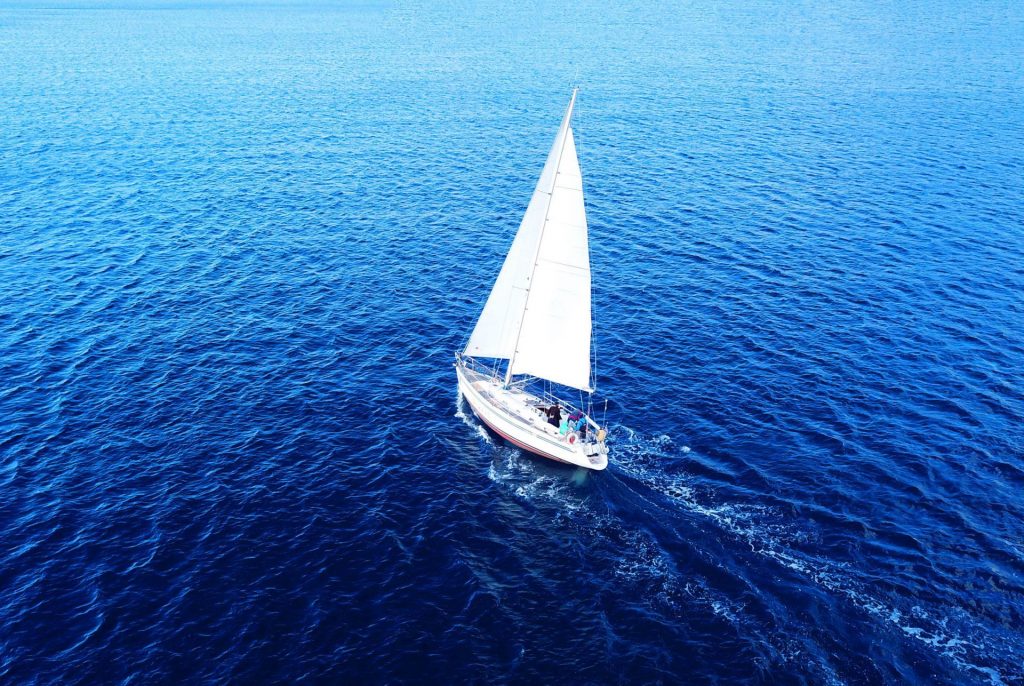
The basics of sailboat design play a significant role in the classification and function of these vessels. Hull shapes, keel types, and construction materials contribute to the speed, stability, and maneuverability of sailboats. Additionally, rigging and sails come in various shapes and sizes, which influence sailing performance and handling.
Key Takeaways
- Sailboats are classified by hull design, rigging, and sails that serve specific purposes.
- Designs and materials have a direct impact on the performance and handling of sailboats.
- A wide range of sailboat types exists, which cater to different needs and preferences.
Basics of Sailboat Design
Sailboats come in various shapes and sizes, designed for different purposes and sailing conditions. One can classify sailboats based on hull types, keel types, and mast configurations. This section will briefly discuss these basic components of sailboat design.
There are mainly two types of hulls: monohull and multihull.
- Monohull : This is the traditional and most common type of sailboat hull. It consists of a single hull, providing stability through the use of a keel or centerboard. Monohulls come in various shapes and sizes, suitable for various sailing conditions.
- Catamaran : Catamarans have two parallel hulls of equal size, offering increased stability and speed compared to monohulls. They are commonly used for cruising and racing.
- Trimaran : Trimarans have three hulls, with a larger central hull and two smaller outrigger hulls. This design offers even more stability and speed than catamarans.
The keel is an essential component in sailboat design, helping with stability and performance. There are various keel types, including:
- Full keel : This traditional design features a long and wide keel that extends along the boat's bottom. It offers good tracking and stability but sacrifices speed and maneuverability.
- Fin keel : Fin keels are shorter and deeper than full keels, providing a better combination of stability and maneuverability. These are common in modern monohull sailboats.
- Bulb keel : A bulb keel features a fin keel with a heavy bulb at the bottom, which concentrates the boat's weight, increasing stability and performance in rough conditions.
- Swing keel or centerboard : Swing keels and centerboards can be raised or lowered, allowing the boat to adapt to different water depths and sailing conditions. They are common in smaller boats and racing sailboats.
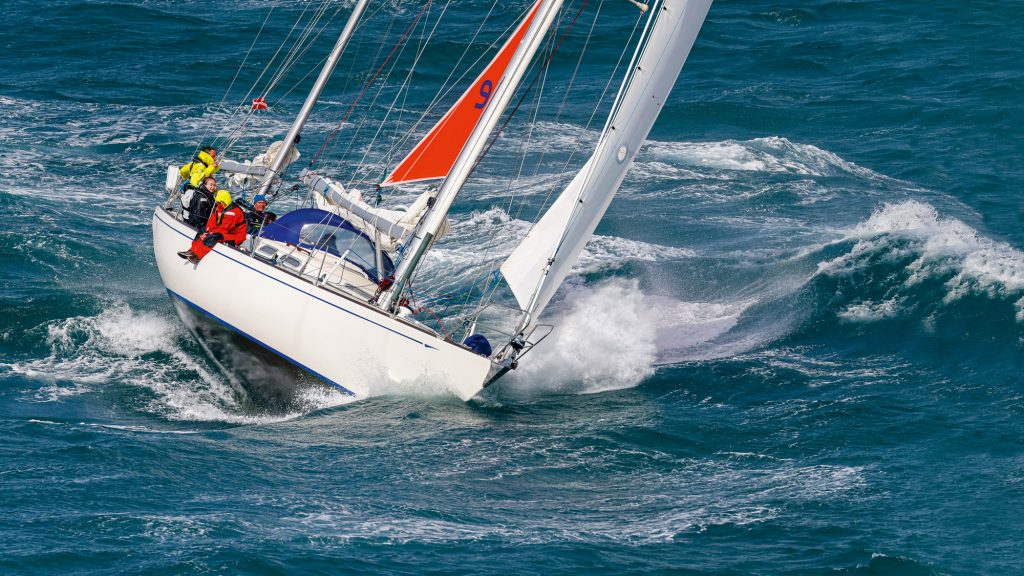
Mast Configuration
The mast configuration affects the sail plan and overall performance of a sailboat. Some common mast configurations include:
- Sloop : This is the most popular mast configuration and features a single mast with a mainsail and a headsail. The simple design makes it easy to handle and suitable for various sailing conditions.
- Cutter : Similar to the sloop, the cutter also has a single mast but carries two headsails, providing more sail area and better performance in heavy weather.
- Ketch : A ketch configuration has two masts: a taller main mast and a shorter mizzen mast. This design offers more flexibility in sail combinations and better balance in different sailing conditions.
- Yawl : Similar to a ketch, a yawl also features two masts but the mizzen is located further aft and is smaller. This design provides better balance and control, particularly in downwind sailing scenarios.
In conclusion, the basics of sailboat design involve selecting the appropriate hull type, keel type, and mast configuration for the desired sailing performance and conditions. Understanding these concepts can help sailors make informed decisions when choosing a sailboat or planning their sailing adventures.
Rigging and Sails
When it comes to sailboats, the rigging and sails play a crucial role in the boat's overall performance and capabilities. This section will briefly cover popular rig types and sail types seen on different sailboats.
There are several types of rigs commonly found on sailboats:
- Sloop : Sloops are the most common type of rig found on modern sailboats. They have a single mast with a mainsail and a single headsail, typically a genoa or jib.
- Ketch : Ketches have two masts, with the main mast taller than the mizzen mast situated aft. They carry a mainsail on the main mast and a mizzen sail on the mizzen mast. Ketches benefit from easier handling and reduced sail area under strong winds.
- Yawl : Similar to ketches, yawls have two masts, but the mizzen mast is smaller and sits further aft, behind the rudder post. Yawls are often chosen for their graceful appearance and improved balance.
- Schooner : Schooners have two or more masts, with the aft mast(s) typically taller than the forward mast(s). Schooners can handle more sails, offering increased sail area for better performance, especially downwind.
- Catboat : Catboats are single-masted sailboats with a single, large mainsail and no headsails. They have a wide beam, which provides stability and ample space for passengers.
- Cutter : Cutters are similar to sloops but carry two headsails, usually a jib and staysail. Cutters may have multiple headsails for increased versatility in various wind conditions.
In addition to the types of rigs, there are also several types of sails used on sailboats, including:
- Mainsail : The primary sail attached to the back of the main mast. It is typically raised on a track or luff groove and managed by a combination of halyard, sheet, and boom vang.
- Genoa : A large triangular sail that overlaps the mainsail, typically used in light winds to provide additional surface area for better performance.
- Jib : A smaller, non-overlapping triangular sail attached to the forestay. Jibs are easier to manage than genoas and are used in a variety of wind conditions.
- Spinnaker : A large, lightweight sail used primarily for downwind sailing . Spinnakers are often brightly colored and shaped like a parachute to catch wind efficiently.
- Staysail : A smaller sail typically used in cutter rigs, positioned between the main mast and the forestay. Staysails provide additional sail area and versatility in varied wind conditions.
Understanding the relationship between sail and rigging can help sailors optimize the performance of their sailboats. With various options for rig types and sail types, each sailboat can be configured to meet the unique needs of its skipper and crew.
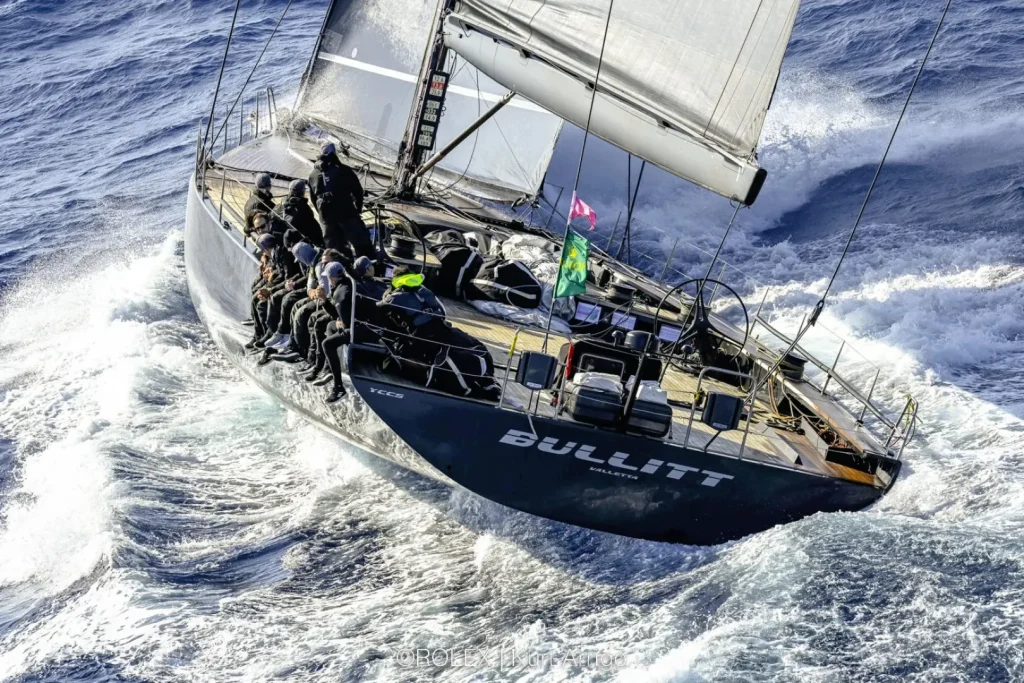
Classes and Types of Sailboats
Monohulls are the most common type of sailboats, consisting of a single hull that provides stability and balance. They come in various sizes and designs, depending on their intended use. Some popular monohull sailboats include the Optimist , Finn, and Sunfish, which are frequently used for racing and recreational sailing. Monohulls tend to have a deeper draft, requiring more water depth than their multi-hull counterparts.
Multihulls, also known as multi-hull sailboats, are a more modern innovation in sailing. They feature two or more hulls connected by a frame or bridgedeck. This design offers increased stability and speed over monohulls. Some common types of multihulls are catamarans (with two hulls) and trimarans (with three hulls). Due to their wider beam and shallower draft, multihulls are particularly suitable for cruising in shallow waters and provide more living space on board.
One-Design Sailboats
One-Design sailboats are a specific class of racing sailboats in which all boats are built to the same design specifications, ensuring that the competition focuses on the skill of the sailor rather than the design of the boat. These boats must adhere to strict rules and standards, with minimal variations allowed in terms of hull shape, sail area, and rigging. Some popular one-design sailboats include the Enterprise and the aforementioned Optimist and Finn sailboats.
Dinghies and Skiffs
Dinghies and skiffs are small, lightweight sailboats that are often used for sailing classes, short-distance racing, or as tenders to larger boats. Dinghies usually have a single mast with a mainsail and sometimes a small jib. Some popular types of sailing dinghies include the Optimist, which is specifically designed for children, and the versatile Sunfish sailboat. Skiffs, on the other hand, are high-performance sailboats primarily used for racing. They have a larger sail area relative to their size and typically include features such as trapezes and planing hulls, which allow for faster speeds and greater maneuverability.
In conclusion, there are various classes and types of sailboats, each with its own unique features and characteristics. From the simplicity of monohulls to the stability and speed of multihulls, and from the fair competition of one-design sailboats to the excitement of dinghies and skiffs, there is a sailboat to satisfy every sailor's preferences.
Sailboat Size and Use
When exploring the world of sailboats, it's important to understand their different sizes and purposes. Sailboats can be categorized into three main types, each with unique characteristics and uses: Day Sailers , Racing Sailboats, and Cruising Sailboats .
Day Sailers
Day Sailers are small sailboats typically ranging from 10 to 24 feet in length. These boats are perfect for short sailing trips and are easy to maneuver for beginners. They have limited accommodations on board, providing just enough seats for a small group of people. Some popular day sailer models include the Laser, Sunfish, and Flying Scot. Lightweight and agile, Day Sailers are often used for:
- Recreation: casual sailing or exploring nearby waters with family and friends
- Training: beginner sailing lessons or practicing sailing techniques
- Competition: local club races or interclub regattas
Racing Sailboats
Racing Sailboats are designed to provide maximum speed, maneuverability, and efficiency on the water. Sizes may vary greatly, from small dinghies to large yachts. Key features of racing sailboats include a sleek hull shape, high-performance sails, and minimalistic interiors to reduce weight.
Career racers and sailing enthusiasts alike participate in various types of racing events , such as:
- One-design racing: all boats have identical specifications, emphasizing crew skill
- Handicap racing: boats of different sizes and designs compete with time adjustments
- Offshore racing: long-distance racing from one point to another, often around islands or across oceans
Cruising Sailboats
Cruising Sailboats are designed for longer journeys and extended stays on the water. They typically range from 25 to 70 feet in length and provide comfortable accommodations such as sleeping cabins, a galley, and storage spaces for supplies and equipment. Sailing cruisers prioritize stability, comfort, and durability for their voyage.
Here are some common types of cruising sailboats:
- Cruiser-racers: These boats combine the speed of a racing sailboat with the comfort and amenities of a cruising sailboat. They are ideal for families or sailors who enjoy participating in racing events while still having the option for leisurely cruises.
- Bluewater cruisers: Designed for handling the world's most demanding ocean conditions, bluewater cruisers are built with a focus on sturdy, self-reliant sailboats that can withstand long-distance voyages and challenging weather conditions.
- Multihulls: Catamarans and trimarans are gaining popularity in the cruising world for their typically more spacious interiors and level sailing characteristics. With two or three hulls, multihulls offer high levels of stability and speed for a comfortable cruising experience.
Understanding the differences between various sailboat types will help potential sailors select the perfect vessel for their sailing goals, skills, and preferences. Day Sailers, Racing Sailboats, and Cruising Sailboats each have their unique features, catering to distinct uses and sailing experiences.
Advanced Sailboat Features
Sailboats have evolved over time, and many advanced features have been developed to enhance performance and safety. In this section, we will discuss some of the key advanced features in modern sailboats, focusing on performance enhancements and safety/navigation.
Performance Enhancements
One critical component that impacts a sailboat's performance is the type of keel it has, which affects stability, resistance, and maneuverability . There are several kinds of keels such as fin keel , wing keel , and bulb keel . Fin keels offer low drag and high efficiency, making them suitable for racing sailboats. On the other hand, wing keels provide better stability at low speeds, while bulb keels provide a lower center of gravity to enhance overall stability and comfort during long voyages.
Another feature that contributes to a sailboat's performance is its sails and rigging. The jib is a triangular sail at the front of the boat, which helps improve its upwind performance. More advanced sailboats use a combination of shrouds , which are the supporting cables running along the sides of the boat, and stays , the cables that help hold the mast in place, to create a stable and efficient rigging system.
A sailboat's performance can also be influenced by the presence of a centerboard or daggerboard , which can be adjusted to optimize stability, maneuverability, and speed. When racing or navigating in shallow waters, retractable centerboards and daggerboards are particularly useful as they provide better performance and versatility.
Safety and Navigation
Safety and navigation onboard a sailboat relies on a combination of advanced gear and equipment. A modern sailboat is usually equipped with:
- GPS and chartplotters to assist with navigation and planning routes
- VHF radios for communication with other vessels and authorities
- Radar to detect obstacles, weather systems, and other vessels
- AIS (Automatic Identification System) which helps monitor nearby vessel traffic
The design of a sailboat's hull, rigging, sails, and hardware also contribute to its safety. The boom , the horizontal pole that extends the sail, should be properly secured and designed to avoid accidents while sailing. The keel , whether it's a fin, wing, or bulb keel, plays a vital role in the overall stability and safety of the sailboat. The choice of keel should be based on the intended use of the sailboat and the prevailing sailing conditions.
In summary, advanced sailboat features significantly improve the performance, safety, and navigation capabilities of modern sailboats. Innovations in keel design, rigging systems, and onboard navigational equipment have undoubtedly contributed to the overall enjoyment and safety of sailing.
Sailboat Ownership
Buying Considerations
When considering buying a sailboat , it is important to understand the different types of sailboats available and the purpose each serves. Sailboats can be broadly categorized into three types:
- Racing sailboats: Designed for speed and performance, with minimalistic interiors and advanced sail systems.
- Cruising sailboats: Built for comfort and longer trips, featuring more spacious interiors and amenities.
- Daysailers: Smaller, easy-to-handle boats that are often used for short trips and recreational sailing.
Prospective boat owners should consider factors such as boat size, type, budget, and intended use (solo vs. family sailing, charter operations, etc.). It's also essential to evaluate the availability of necessary gear and the level of experience required to handle the chosen sailboat.
Maintenance and Upkeep
Sailboat ownership involves maintenance and upkeep to ensure the boat remains functional, safe, and holds its value. Some common maintenance tasks include:
- Hull cleaning and inspection: Regularly inspect the hull for damages and clean off any growth to maintain performance and fuel efficiency.
- Antifouling paint: Apply antifouling paint to prevent marine organisms from attaching to the hull, which can negatively impact the boat's performance.
- Engine maintenance: Check and replace engine oil, inspect cooling and fuel systems, and clean or replace air filters.
In addition to regular maintenance, sailboat owners should also be prepared to replace or repair critical systems and components, such as:
- Sails: Monitor the condition of your sails and replace them as needed to maintain performance and safety.
- Rigging: Regularly inspect and maintain the standing and running rigging, and replace worn or compromised parts.
- Electronics and instruments: Ensure navigation systems, radios, and other electronic equipment are functioning properly.
Taking proper care of a sailboat can be time-consuming, and some owners may choose to charter their boats when not in use as a way to offset ownership costs. Others may opt for hiring professionals to manage routine maintenance, particularly when sailing solo or with limited sailing experience.
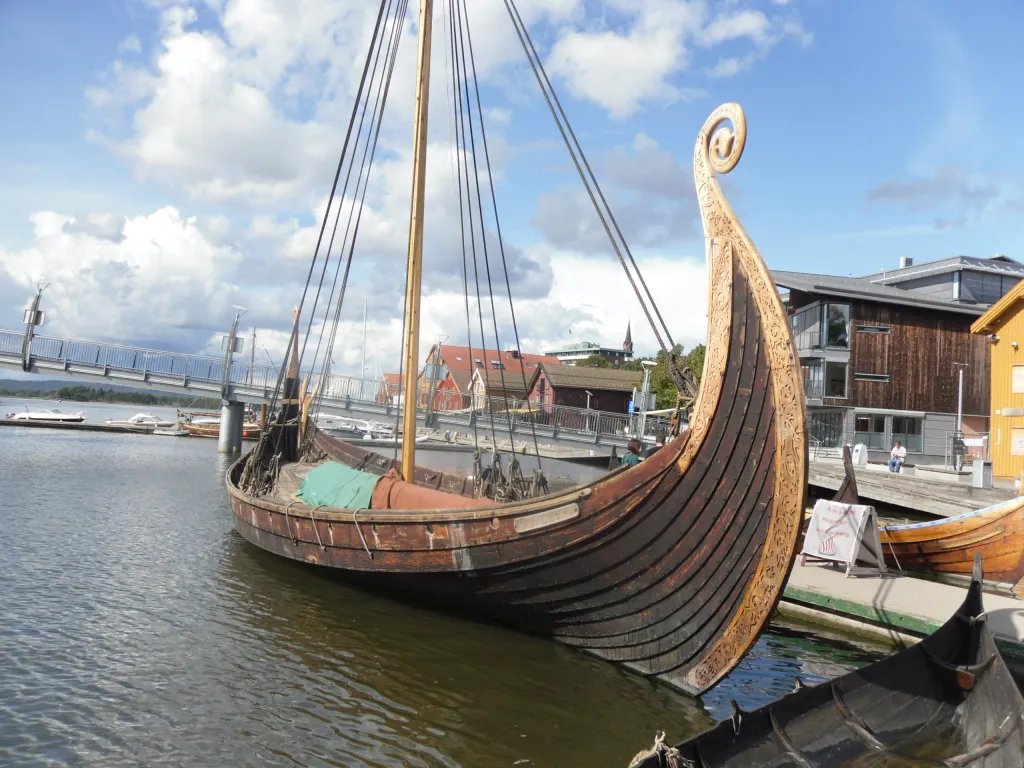
Historical and Special Sailboats
Tall ships and gaffers.
Tall Ships are large, traditionally rigged sailing vessels with multiple masts, typically square-rigged on at least one of their masts. Some examples of these ships include the clipper, brig, and square-rigged vessels. The clipper is a fast sailing ship known for its sleek hull and large sail area, while the brig features two square-rigged masts. Square-rigged ships were known for their impressive sail area and could cover large distances quickly.
Gaffers are a subset of historical sailing vessels with a gaff mainsail as their primary sail type. This gaff-rig is characterized by a spar (pole) that extends the top edge of the mainsail, giving it a quadrilateral shape to optimize wind coverage. Gaff mainsails were commonly used in England and influenced the development of other sailing vessels.
Classic and Antique Sailboats
Classic and antique sailboats refer to older, traditionally designed sailing vessels that have been preserved or restored. They often feature wooden construction and showcase a variety of rigging types, including gaff rigs and square rigs. These historical sailboats have unique designs, materials, and techniques that have since evolved or become rare.
Here are some examples of antique and classic sailboats:
- Sloop : A single-masted sailboat with a Bermuda rig and foresail
- Cutter : A single-masted vessel with a similar rig to the sloop, but with additional headsails for increased maneuverability
- Ketch : A two-masted sailboat with a smaller mizzen mast aft of the main mast
In summary, historical and special sailboats encompass a wide range of vessel types, from large, multi-masted tall ships to smaller, single-masted gaffers and classic sailboats. These vessels reflect the rich maritime history and the evolution of sailing techniques and designs over time.
Sailboat Culture and Lifestyle
Sailboat culture and lifestyle encompass a variety of aspects including racing events, leisurely cruising, and exploring new destinations. The main types of sailboats include racing yachts, cruising sailboats, and motorsailers, each offering a unique experience for sailors.
Regattas and Racing Circuits
A popular aspect of sailboat culture involves participating in regattas and racing circuits . These events create a competitive atmosphere and develop camaraderie among sailors. Racing sailboats are specifically designed for speed and agility , and sailors often team up to compete in prestigious races such as the Rolex Sydney Hobart Yacht Race or the America's Cup. Yacht clubs play an essential role in cultivating this competitive sailing environment.
Sailboat Charter and Tourism
Another facet of sailing culture is the sailboat charter and tourism industry, which allows people to experience the cruising lifestyle without owning a sailboat. Charters are offered for various types of sailboats, from family-sized cruising vessels to luxurious superyachts . Yacht sailing provides tourists with a unique travel experience, as they can explore diverse destinations, immerse themselves in local cultures, or simply relax on the open water.
Cruising sailboats are designed to provide comfortable living spaces and amenities, making them perfect for longer journeys or exploring remote destinations. Motorsailers, on the other hand, are equipped with both sails and engines, offering versatility and convenience for sailors.
Some popular sailing destinations include the Caribbean, Mediterranean Sea, and the South Pacific. These regions offer beautiful scenery, rich cultural experiences, and ideal sailing conditions.
The sailboat culture and lifestyle attract individuals who enjoy adventure, exploration, and camaraderie. From competitive racing events to leisurely cruising vacations, sailing offers diverse experiences that cater to a wide range of interests.
Frequently Asked Questions
What are the distinguishing features of different sailboat classes?
There are various sailboat classes, each with its own distinguishing features. Monohulls, for example, are the most common type of sailboat and have a single hull. Multihulls, such as catamarans and trimarans, have two or three hulls, respectively. These differences in hull design often affect the boat's stability, speed, and maneuverability.
Which sailboat types are best for novice sailors?
Novice sailors often benefit from starting with smaller, more manageable boats. Sailing dinghies and daysailers are popular choices due to their simple rigging and ease of handling. These boats typically have a single mast and a limited number of sails, making them ideal for beginners to learn sailing basics.
What are common types of small sailboats ideal for day sailing?
For day sailing, small sailboats such as sailing dinghies, day sailers, and pocket cruisers are ideal options. These boats usually range between 12 and 25 feet in length and offer simplicity, ease of handling, and portability. Examples of common day sailing boats include the Sunfish, Laser, and O'Day Mariner.
How do the purposes of various sailboat types vary?
Sailboats serve different purposes based on their design, size, and features. Daysailers and dinghies are ideal for short trips, sailing lessons, and casual outings. Racing sailboats, with their lighter weight and streamlined design, are built for speed and competition. Cruising sailboats, on the other hand, are designed for longer voyages and often include living quarters and additional amenities for comfortable onboard living.
What is considered the most popular class of sailboat for recreational use?
The most popular class of sailboat for recreational use often varies depending on individual preferences and local conditions. However, monohulls are commonly preferred due to their widespread availability, versatility, and affordability. Within the monohull class, boats like the Sunfish, Laser, and Catalina 22 are popular choices for their ease of use and adaptability to various sailing conditions.
Could you describe a sailing dinghy designed for two people?
A two-person sailing dinghy typically has a simple rig with a single mast and one or more sails, making it easy to handle for both experienced and novice sailors. The RS Venture , for example, is a popular choice for two-person sailing. It features a spacious cockpit, durable construction, and simplicity in its rigging and control systems. These characteristics make it an excellent option for recreational sailing, training, and even racing.
Related Articles
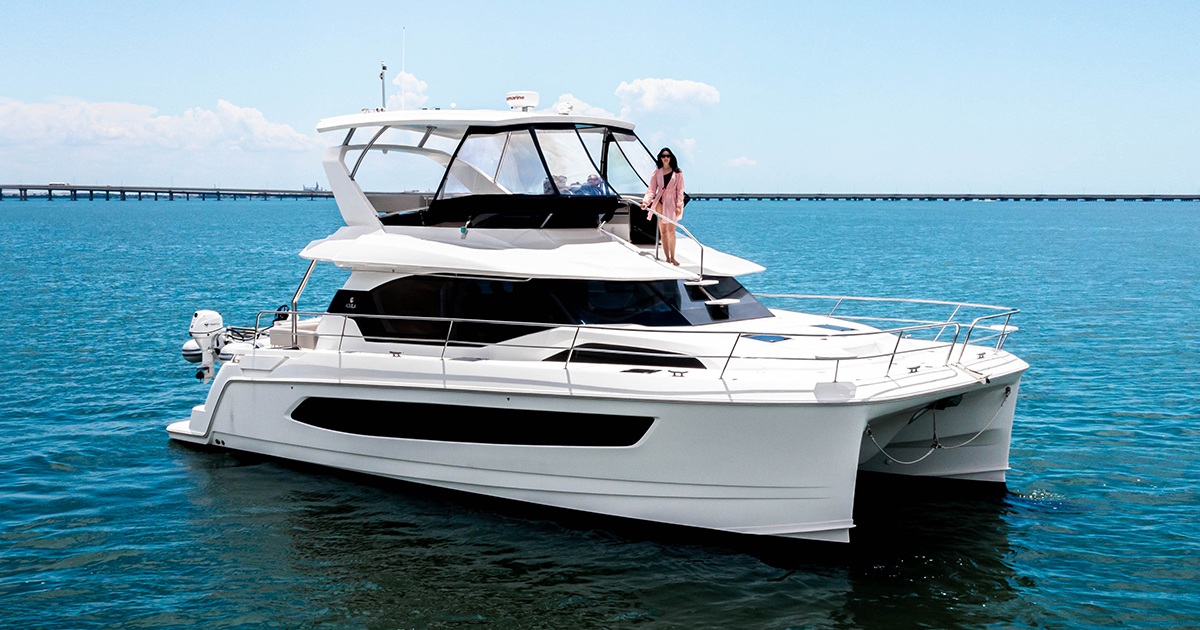
Aquila 44: Exploring the Luxury Power Catamaran Experience
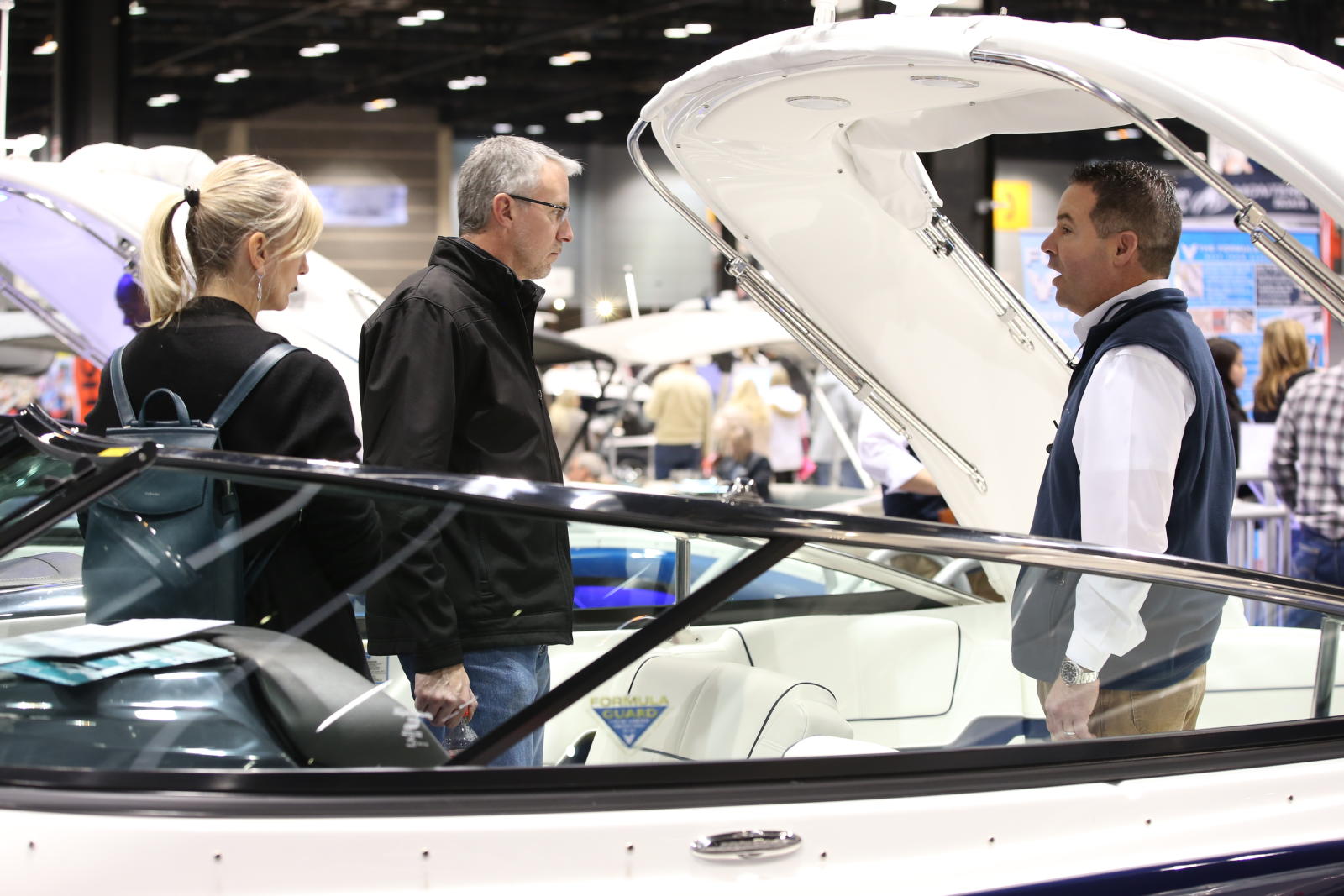
Boat Financing: Key Factors to Secure Your Dream Vessel

Navionics Boating App-Is It The Best?
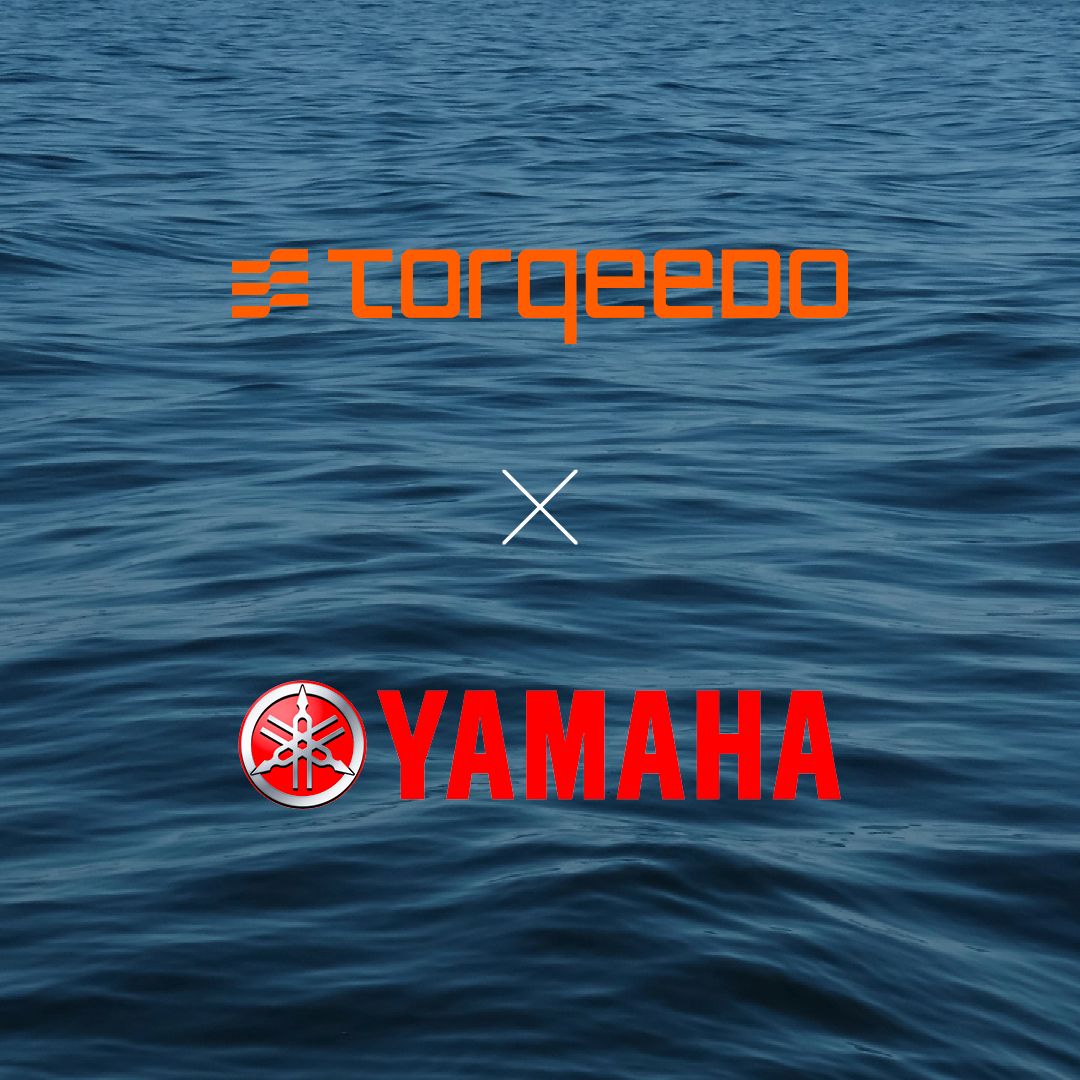
Yamaha Motor Aquires Torqeedo, the global market leader in electric mobility on water
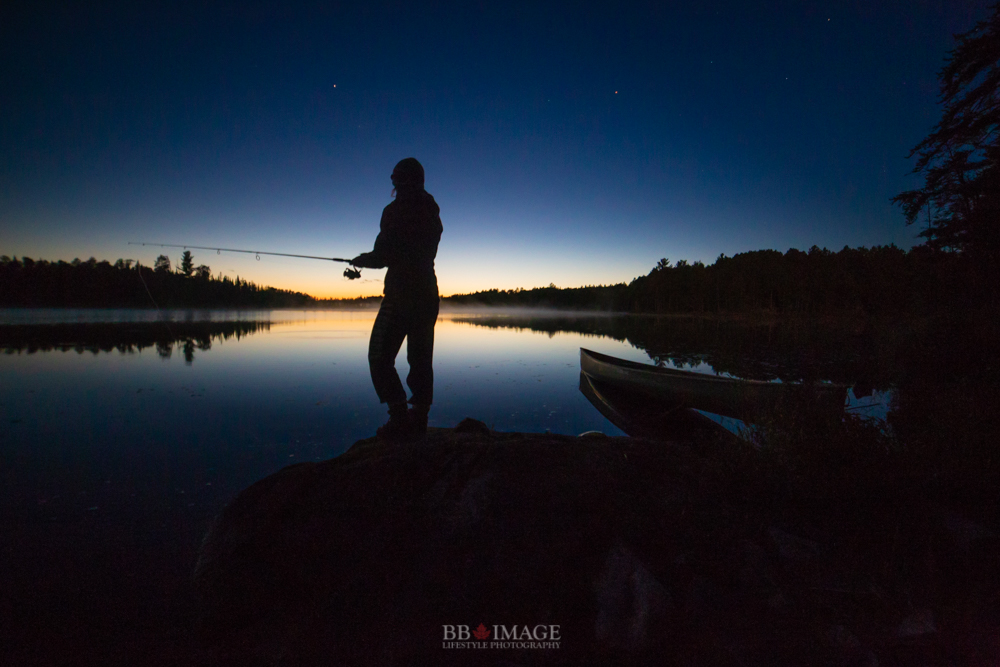
Night Fishing: The Ultimate Guide to Mastering the Art of Nocturnal Angling
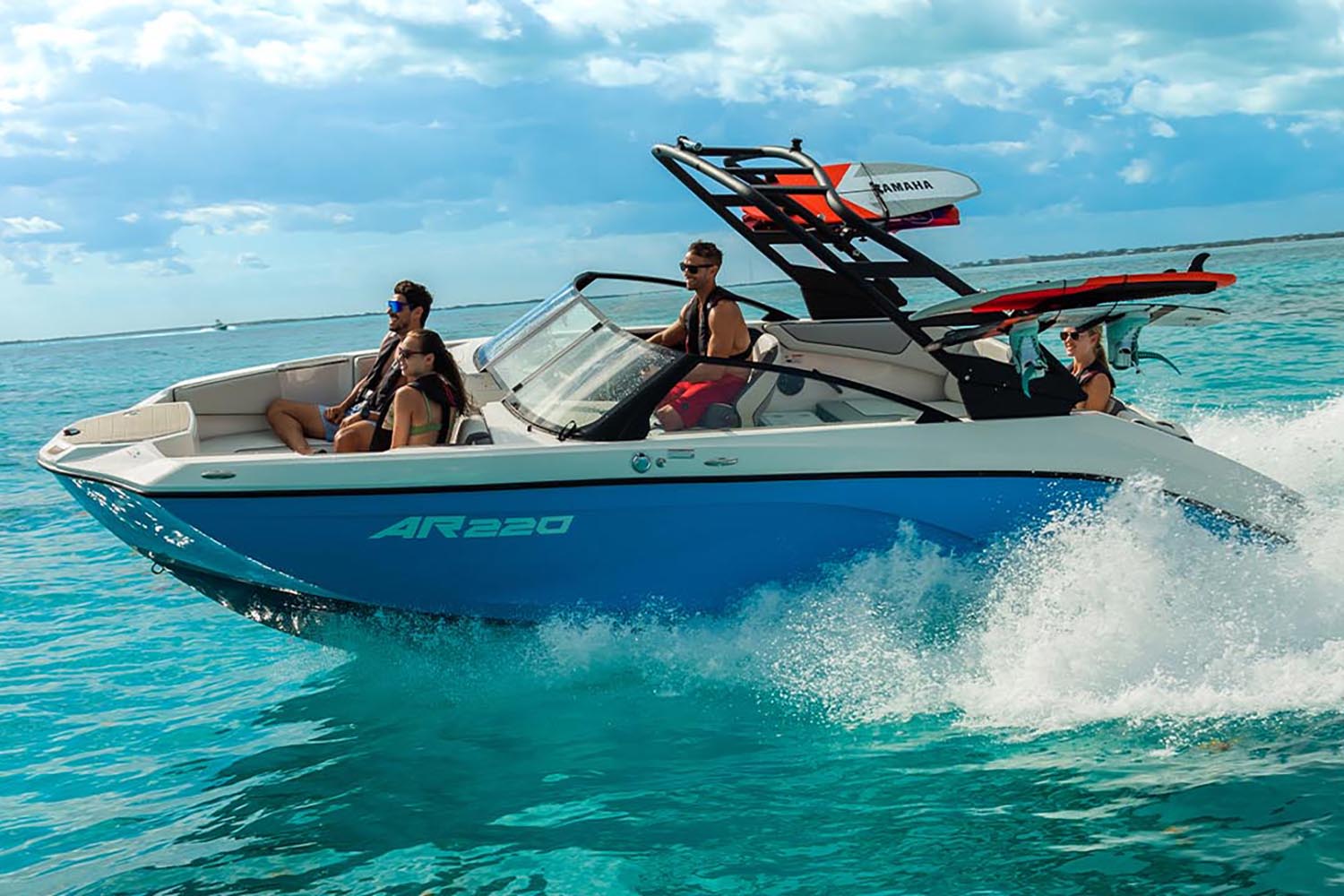
Jet Boat Essentials: A Comprehensive Guide for Enthusiasts

Inflatable House Boat: Ultimate Guide for a Floating Adventure
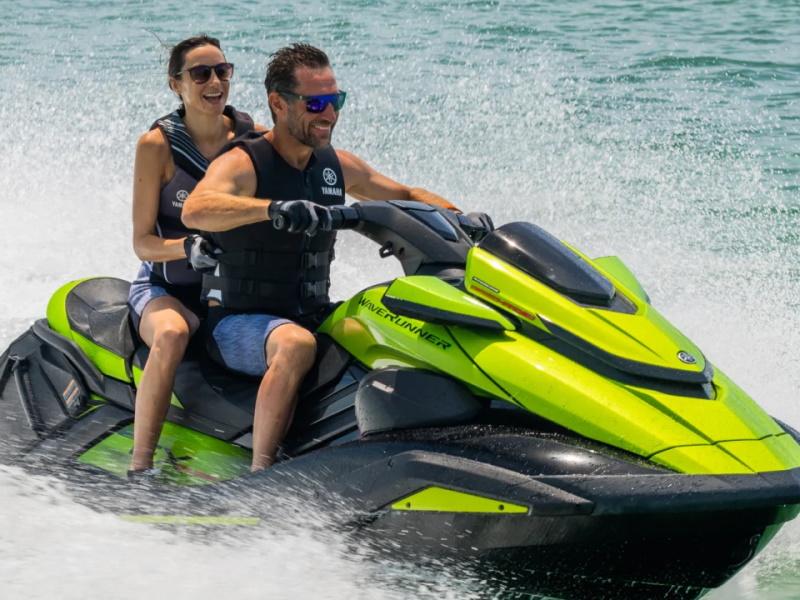
Which Action May Cause Loss of Steering Ability in a PWC? Essential Safety Tips
- Types of Sailboats
- Parts of a Sailboat
- Cruising Boats
- Small Sailboats
- Design Basics
- Sailboats under 30'
- Sailboats 30'-35
- Sailboats 35'-40'
- Sailboats 40'-45'
- Sailboats 45'-50'
- Sailboats 50'-55'
- Sailboats over 55'
- Masts & Spars
- Knots, Bends & Hitches
- The 12v Energy Equation
- Electronics & Instrumentation
- Build Your Own Boat
- Buying a Used Boat
- Choosing Accessories
- Living on a Boat
- Cruising Offshore
- Sailing in the Caribbean
- Anchoring Skills
- Sailing Authors & Their Writings
- Mary's Journal
- Nautical Terms
- Cruising Sailboats for Sale
- List your Boat for Sale Here!
- Used Sailing Equipment for Sale
- Sell Your Unwanted Gear
- Sailing eBooks: Download them here!
- Your Sailboats
- Your Sailing Stories
- Your Fishing Stories
- Advertising
- What's New?
- Chartering a Sailboat
The Different Types of Sailboats
If you’re a sailboat fanatic like me, all types of sailboats will attract your attention. Some more so than others admittedly, but all will have something about them that catches your eye.
If you’re not a fanatic (not yet, that is) but just an interested observer, then the first thing you’ll notice about a sailboat will be how many masts it has and the configuration of its sails - in other words, its 'rig'.
This observation alone will enable you to identify the five main types of sailboats — sloops, cutters, ketches, yawls and schooners - all of which are described here.
But apart from the various rig types, you can describe types of sailboats from a different viewpoint - sailing dinghies, dayboats, motorsailors, monohulls, catamarans and trimarans.
Let's make a start with the various rig types...
A single-masted sailboat with just two sails — a foresail (aka headsail or jib) and a mainsail — is a sloop, the purest type of sailboat.
The sloop rig can also be described as a Bermuda rig, Bermudian rig or Marconi rig.
Read more about sloops...
Examples of Sloops
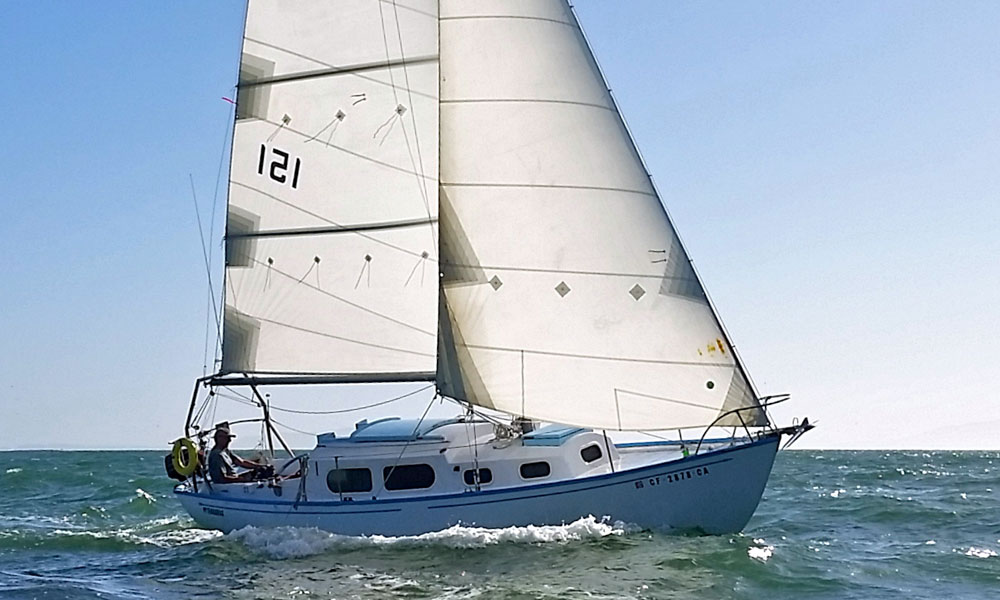
If a sloop has an additional sail between the headsail and the mainsail, then it's no longer a sloop - it's a cutter.
Some cutters - like the one shown here - have the foresail set forward on a bowsprit, with the inner forestay permanently rigged to the stemhead where the foresail otherwise would be, or to a central chainplate further aft on the foredeck.
Read more about cutters...
Examples of Cutters
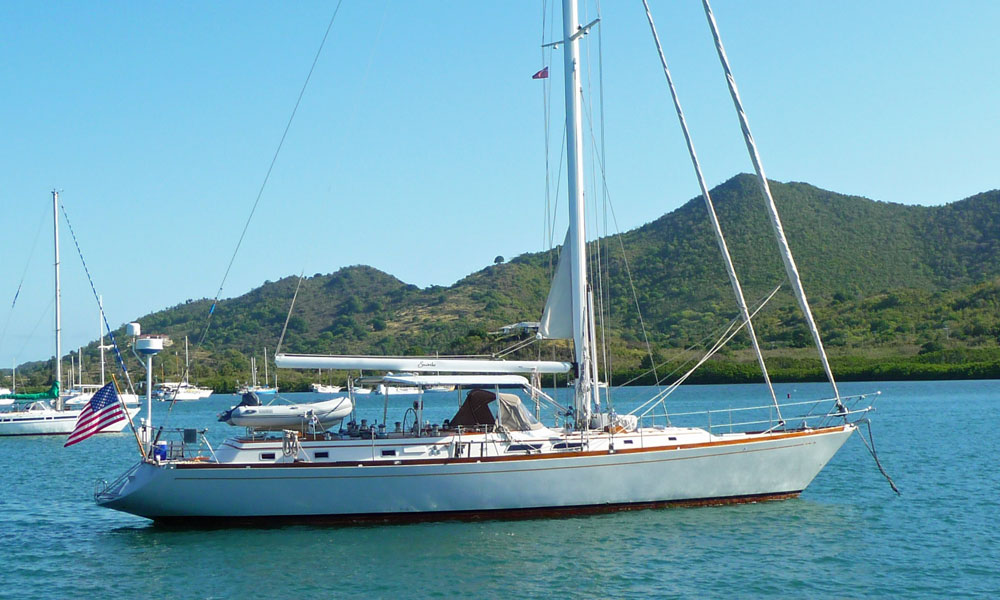
The following boats may look like cutters with their double headsails, but they're not cutters at all...
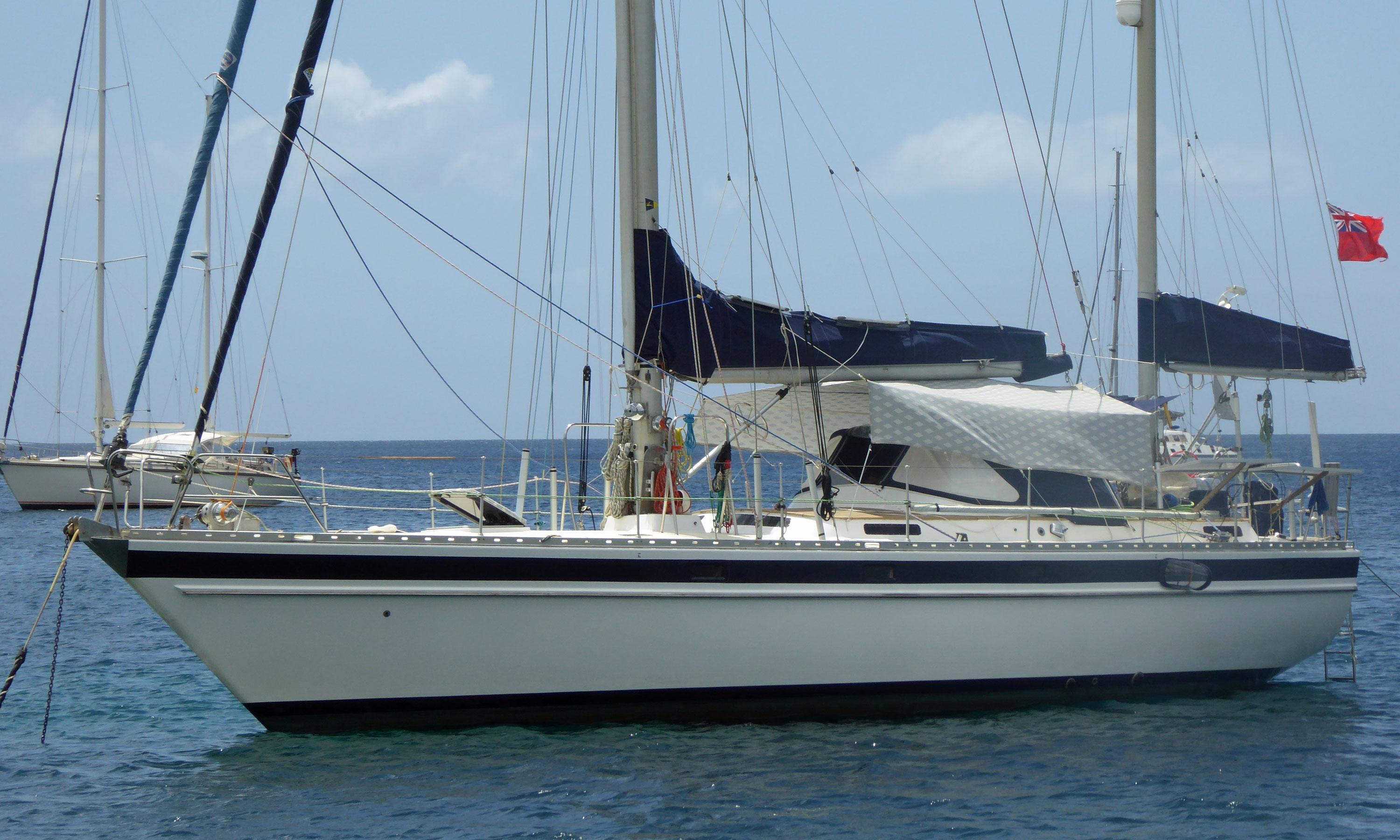
To find out why, click here...
A ketch is a two-masted sailboat, a main mast forward and a shorter mizzen mast aft.
But not all two-masted sailboats are ketches — they might be yawls (see below).
A ketch may also sport a staysail, with or without a bowsprit, in which case it would be known as a cutter-rigged or staysail ketch.
Read more about ketches...
Examples of Ketches
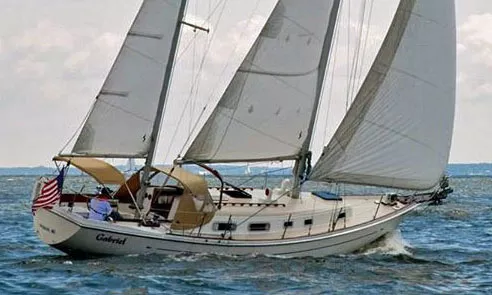
Note that the Ocean 71 and the Irwin 52 are cutter-rigged, and are traditionally referred to as Staysail Ketches .
Cat Ketches
Cat-ketches are recognised by the lack of any standing rigging to support their pair of unstayed masts.
And yes, if the after mast is taller than the foremast then it's called a cat- schooner sailboat.
Read more about cat-ketches...
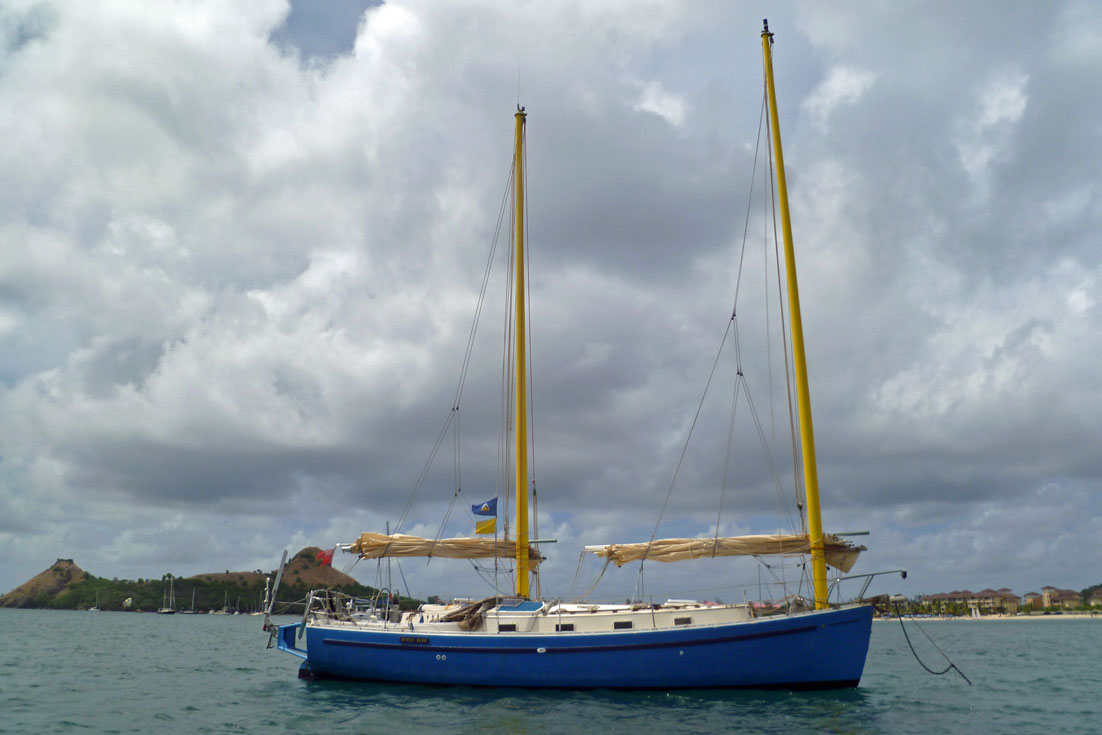
Yawls have their origins as old-time sail fishing boats, where the small mizzen sail was trimmed to keep the vessel steady when hauling the nets.
Much like a ketch, the difference being that the yawl has the mizzen mast positioned aft of the rudder post whereas the ketch has its mizzen mast ahead of the rudder post.
You’ll not be surprised to learn that a yawl with a staysail is known as cutter-rigged yawl.
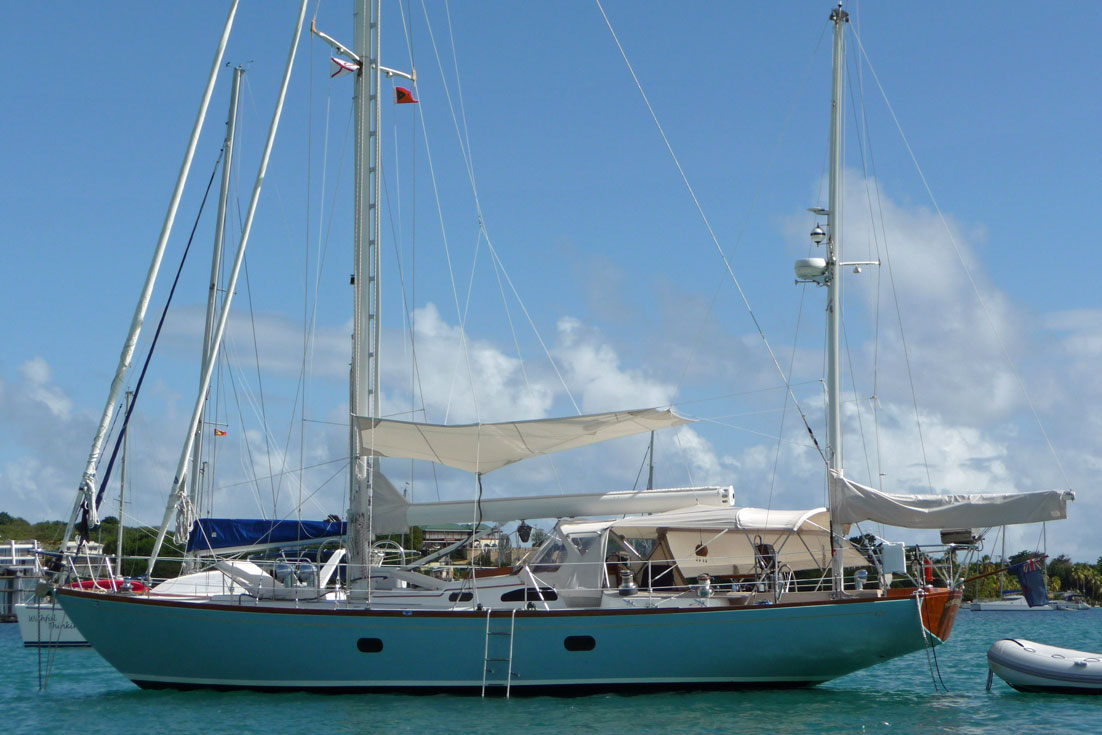
A schooner is a two-or-more masted sailboat, in which the aft-most mast - the mainmast - is the same height or taller than the foremast.
The one shown here is gaff cutter rigged, with a topsail set on the mainmast.
Many sailors agree that of all the different types of sailboats, a schooner under full sail is one of the most beautiful sights afloat.
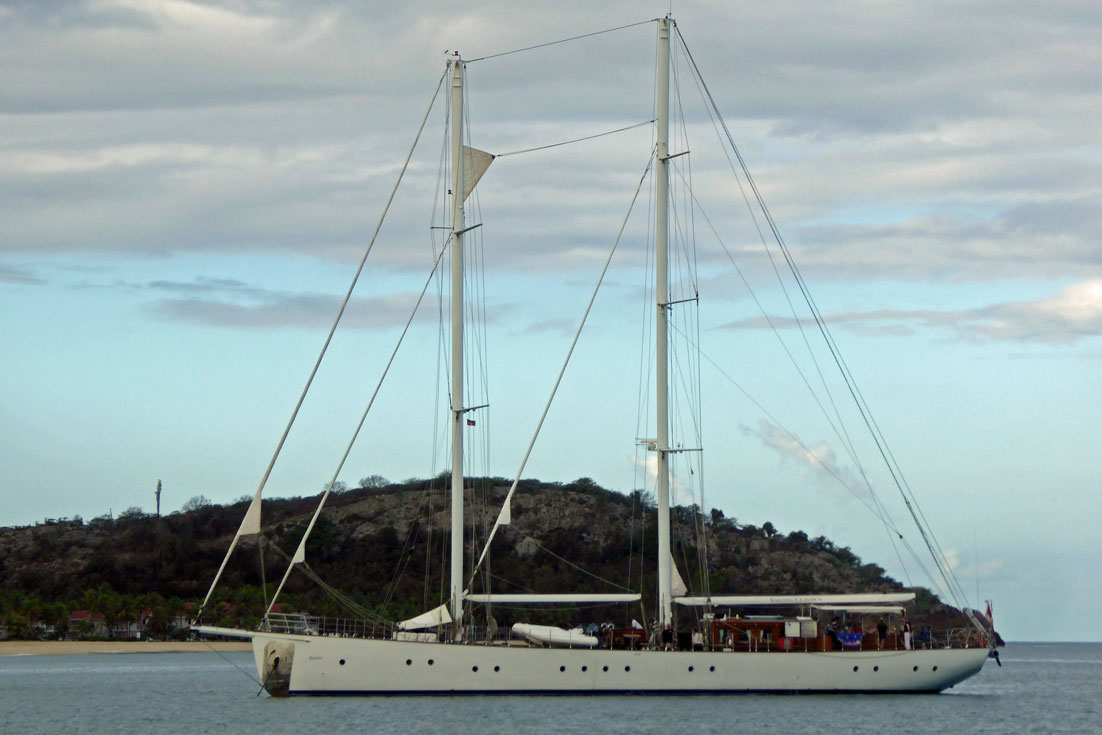
Gaffed-rigged sailboats, or 'gaffers', have their mainsail supported by a spar - the 'gaff' - which is hauled up mast by a separate halyard.
Often these types of sailboats are rigged with a topsail, as shown here and in the gaff schooner above, which really adds some grunt in light airs.
All this comes at a price of course, both in terms of material cost and weight aloft, which is why very few modern yachts are fitted with gaff rigs these days.
All artwork on this page is by Andrew Simpson
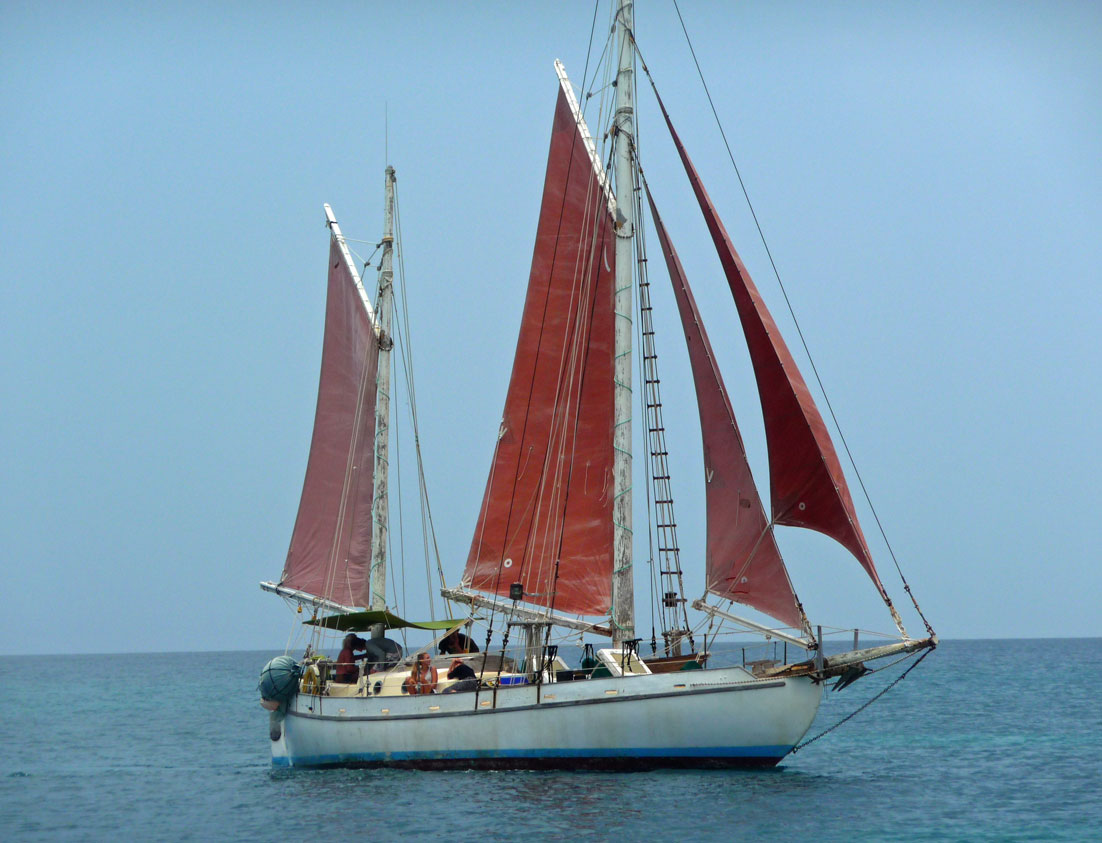
Examples of the Various Types of Sailboats...
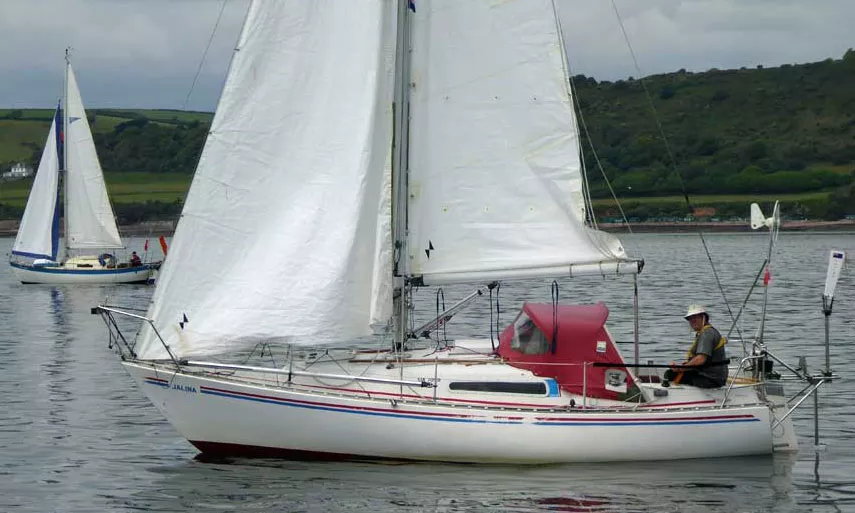
Other Types of Sailboats
The seven sailboat rig variations shown here are the most popular types of modern cruising boat rigs, but there are other rig versions which were once found on commercial, fishing, and naval sailing vessels.
They include:
- Full square-rigged sailing vessels
- Barkentines
- Brigantines
And you can see examples of them here ...
In this article I've said that ketches, yawls and schooners with two headsails can be called cutter rigged. This is a commonly used description but strictly speaking, there's only one rig that can accurately be called a cutter - and that's a single-masted sailboat with two headsails. My thanks to 'Old Salt' for drawing my attention to this!
Recent Articles
Westerly Discus 33 Sailboat Specs & Key Performance Indicators
Aug 28, 24 02:14 AM
Beneteau Oceanis 400 Specs & Key Performance Indicators
Aug 27, 24 05:09 AM
Grand Soleil 37 Sailboat Specs & Key Performance Indicators
Aug 27, 24 01:19 AM
Here's where to:
- Find Used Sailboats for Sale...
- Find Used Sailing Gear for Sale...
- List your Sailboat for Sale...
- List your Used Sailing Gear...
Our eBooks...

A few of our Most Popular Pages...

Copyright © 2024 Dick McClary Sailboat-Cruising.com
- Pontoon Boats
- Personal Watercraft
- nauticalknowhow
- Nautical Knots
- Tools and Calculators
Types of Sailboats: Classification Guide
Sailboats can be divided into three basic types based on their hulls (catamaran, monohull or multihull) , their keel and their rigging, and then further subdivided from there. The result is that there are actually well over a dozen different kinds of sailboats out there.
Sailboat Hull Types
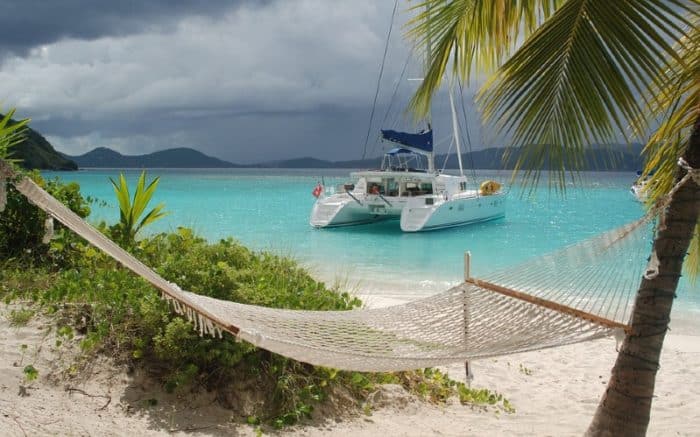
There are three main hull types that you’ll find in sailboats.
- Monohull: This is what most people think of when they think of a sail boat or any boat at all, really. A monohull sailboat has a single hulled structure that gives a boat that traditional boat shape we all instantly recognize. These are far and away the most common hull type for sailboats because they’re some of the oldest, they’re cheaper to produce, and they are fairly easy to maintain compared to the other options. You can do a lot more with the rigger in monohull sailboats and any sailing vessel with multiple masts is invariably going to be a monohull one. The downside of the monohull compared to the others is that they lack the stability.
- Catamaran: The second hull type you’ll find in sailboats is the catamaran . While technically a multihull vessel, they feature two hulls that are located on either side of the boat connected by a deck. Because it’s just the two, they get called catamarans rather than multihull which generally refers to three. Catamarans had been used by ancient peoples for years but never really caught on with “modern” boating for quite a long time. Now that we have fiberglass hulls and other advances, catamarans are much more commonplace than they were a hundred years ago. Catamarans offer great speed and stability but don’t have as much cabin space as a monohull.
- Trimaran/Multihull : This hull style features three hulls in a similar style to the catamaran with the addition of that third center hull. From the side you wouldn’t be able to tell a catamarans from trimaran sailboats. These boats are even faster and more stable than a catamaran and, by extension, a monohull. They have a very low center of gravity and a large beam. Space is still a drawback but the third hull increases room overall. There are also vessels with even more hulls, but they are exceedingly rare and also pretty expensive.
Sailboat Keel Types
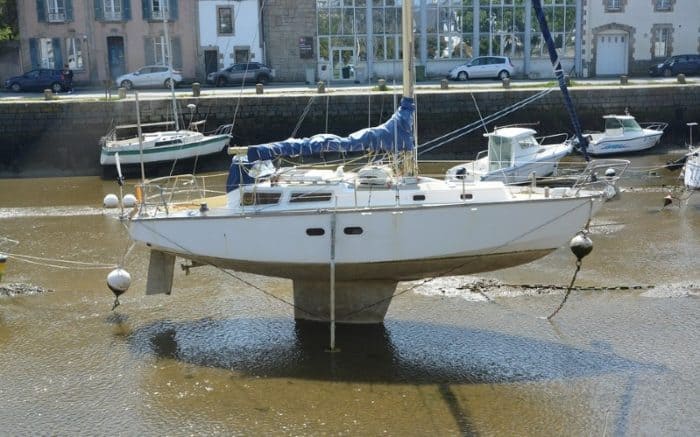
Heading below the hull now and we’ll find the keel, which is what gives your sailboat added stability in the water. While multihull boats find stability in the additional hulls, a monohull boat will get stability from its keel. Though it’s nearly impossible to flip or capsize a trimaran, if it does happen it’s staying flipped or capsized. However, the keel on a monohull boat makes it even harder to flip because of the physics of resistance in the water. That isn’t to say a monohulled boat with a keel is unsinkable, quite the opposite, but you’re just not going to flip one upside down without a real fight. There are six main keel types you’ll find in sailboats.
- Bilge Keel: These are dual keels that can be like fin keels or even full keels extending the length of the vessel. They extend from the sides and can prevent the boat from rolling. They need to be symmetrical on both sides of the boat to work.
- Bulb Kee l: These are a kind of fin keel but they carry ballast in them. That allows them to have a little more stability. They operate like a hydrofoil
- Centerboard Keel: This type of keel actually pivots and can be changed depending on the depth of the water.
- Daggerboard Keel : Another kind of centerboard keel but the daggerboard can actually be pulled up into the hull. This allows you to alter its position for an increase or decrease in speed or stability as needed.
- Fin Kee l: If you’re into racing you’ll probably have a fin keel. They are thin but extend deep below the sailboat. This makes them great for speed but not really ideal for a comfortable ride. You wouldn’t want to be day sailing for fun and relaxation with a fin keel.
- Full Keel: This is the most common type of keel and it spans the entire length of the vessel. There will likely be a rudder built into the keel as well.
- Wing Keel : This is a variant on the fin keel. Wing keels have a small wing at the tip to allow better directional stability by reducing cross flow.
Sailboat Mast Configuration
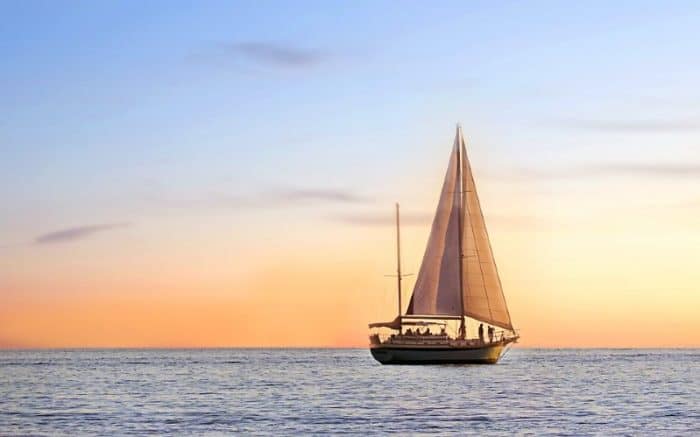
The mast of the sailboat is obviously that large pole onto which sails are rigged. Depending on your boat type you may have one mast, two masts, or more masts. How these masts are configured is where you can start distinguishing sailboat types you may recognize by name. These include:
Sloop: This is arguably the most popular type of sailboat mast type. A sloop has a single mast and two sails – the headsail and the mainsail. Being a single masted sailboat makes them easy to identify. These are probably the easiest to learn how to rig and how to sail. It’s versatile enough for cruising and for racing. Commonly these a gaff rig or a Bermuda rig. Another kind of sloop rig is the fractional rig sloop in which you can find one of the sails below the top of the mast.
Schooner: These can have multiple masts, not just two. The largest sailing vessels you’re likely to see, either in the present or in images from history, were schooners. Giant ships with six masts each bearing over 10 sails were schooners. An important detail is that the first mast on a schooner will always be shorter than the others. They are usually gaff-rigged
Cutter: This type of sailboat is very similar to the sloop and has a centrally located mast supporting three sails. Two headsails, the second called a staysail, is what distinguishes it most easily from the sloop. The rigging makes a cutter a bit harder to manage than a sloop.
Ketch : A ketch is a lot like a schooner but the two masts are arranged differently. On a ketch, the main mast is taller than the aft mast which is called the mizzen mast. The mizzen sail naturally is on the mizzen mast with the mizzen mast positioned aft.
Catboat : Also called a cat, a catboat has a single mast and a large, single gaff sail. The boats are usually short, stout boats that aren’t built for speed or for open seas. Best to be used in coastal waters
Yawl: This vessel is nearly identical to the ketch with one main difference. In a yawl, the helm is forward of the mizzen mast, while that is not the case in a ketch.
Other Types of Sailboats
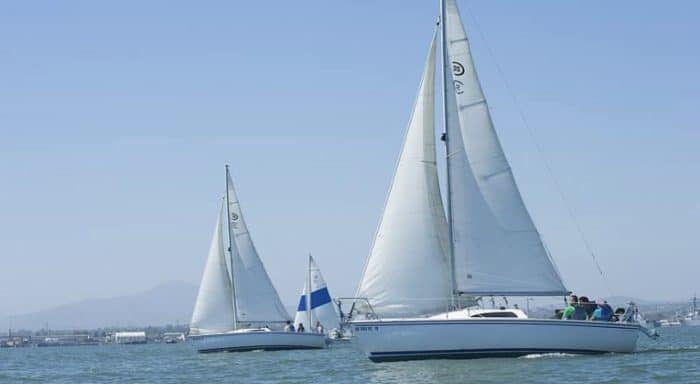
Now that we have the basic configurations out of the way, let’s look at some of the more specific types of sailboats you may find at sea. In some cases you’ll see that these terms are not entirely specific and one term may actually apply to multiple kinds of sail boats in much the same way that something like SUV can describe multiple different vehicles that are similar but not all the same.
Sailing Dinghies
Like any dinghy, a sailing dinghy is going to be a small vessel. Typically made to accommodate just one or two people, they are under 15 feet and the smallest of which are often used by children. Optimist dinghies are raced professionally and must meet certain requirements to be officially registered as true Optimist boats. If you’re totally new to sailing, a sailing dinghy might be a good place to learn the ropes.
Daysailer generally refers to any sailboat that is not intended to either race other boats or keep you out on the water for an overnight stay. As such, it can cover a lot of ground. Typically, a daysailer will probably be between 14 feet and 20 feet. Usually you won’t get more than 4 people on board and there will be room for storing gear but not a sleeping berth. These are great beginner sailboats.
Pocket Cruisers
Like a daysailer, a pocket cruiser is more of a general label for boats rather than a specific kind. In this case, any sailboat under 30 feet could technically be considered a pocket cruiser. Basically it should be trailerable and used for either cruising or racing. They may contain a small cabin or berth. They could be outfitted for long offshore trips.
Trailer Sailer
Very similar to a pocket cruiser, a trailer sailer is a smaller vessel but still larger than a sailing dinghy. There is clear overlap between trailer sailers, daysailers, and pocket cruisers and the same name could technically be used for many different boats. The defining characteristic of a trailer sailer is that it can easily be transported by trailer behind your tow vehicle. Unlike a sailing dinghy, a trailer sailer would likely have a retractable keep like a centerboard or daggerboard.
Racing Sailboats
These boats can be very large, anywhere from 20 feet to over 70 feet, and they are designed to be light and fast on the water. Larger racing sailboats required a skilled crew to operate. These have keels intended to increase speed and even laminate sales to improve performance. Smaller racing boats can be manned by just one or two people. They don’t offer a lot of creature comforts and aren’t meant for relaxing trips at sea.
Beach Catamarans
Beach cats get their name from the fact they’re designed to be beached and can be launched again from the beach if you so desire. They are usually under 25 feet and not meant for extending sailing offshore, rather they are designed for daysailing. They are very agile and fast and take a good foundation of knowledge to control properly.
Cruising Catamarans
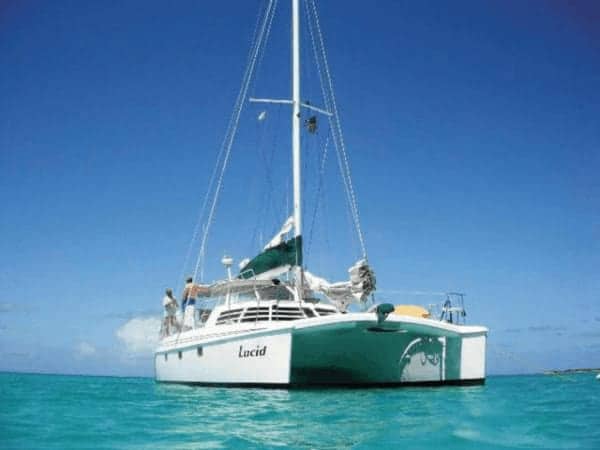
This is the larger style of catamaran designed for more serious boating. Like any catamaran they have a shallow draft but these can be between 25 feet and up to more than 50 feet. They’re designed for extended cruising offshore.
Cruising Sailboats
Boats like schooners quality as a cruising boat and they are typically at least 16 feet in length but may get well over 50 feet as well. Cruising sailboats include cabins for extended stays offshore and, if the boat is large enough, will likely have a fairly large living space below deck which includes a galley and a head in addition to sleeping berths. These are often called liveaboard sailboats .
Cruisers are often monohull but can just as easily be multihull. When properly outfitted they can be used for long, extended stays at sea that last weeks or more. Depending on rigging a cruising sailboat could easily be a sloop, a schooner, a cutter, a ketch or even a superyacht.
Racing Cruisers
This is essentially a hybrid of the cruising sailboat and the racing sailboat. It’s built for more speed than a cruiser but it will have better accommodations than a racing sailboat to allow for stays at sea. The end result is a lighter cruiser ideal for a few days at sea that can get some good speed.
Bluewater Cruising Boats
These are basically the next step up from a cruising sailboat. A bluewater cruiser is meant to sail across oceans, which is where the bluewater part of the name comes from. These are large sailboats and are best only sailed by skilled sailors. They can be outfitted for very long stays at sea and are able to handle rough weather better than smaller vessels.
Motorsailers
You don’t hear this term much anymore but it refers to a sailboat that also has an inboard motor so that they can travel under engine power or wind power. Typically these are larger vessels with accommodations below deck and designed for extended stays off shore. That said, because they mix both styles of boat, they fall somewhere short of either in terms of performance. The engine takes up space and adds weight, limiting your sailing abilities. Obviously traditional sailboats won’t include a motor.
The Bottom Line
There are a number of different kinds of sailboats and the easiest way to distinguish them is by comparing hull types, sail and mast configuration, and keels. Many terms you hear to describe sailboats can describe more than one kind, while others are very specific and the boat must meet certain requirements to merit the name. The only thing that truly unites every type of sailboat is the fact it must be powered by the wind, and even then there are hybrid versions that use motor power sometimes.
Learning the rigging of the different types of sailboats, including things like gaff rigs, standard rigging, and other rig types can be hard work and time consuming as some of these sailing boat rig types are far more complex than others.
My grandfather first took me fishing when I was too young to actually hold up a rod on my own. As an avid camper, hiker, and nature enthusiast I'm always looking for a new adventure.
Categories : Boats
Leave a Reply Cancel reply
Your email address will not be published. Required fields are marked *
Save my name, email, and website in this browser for the next time I comment.
More in Boats

What Is A Gunwale?

131 of the Best Hawaiian Boat Names

167 Patriotic Boat Names

The 138 Best Boat Names for Dog Lovers

The People’s Poncho Review and Ratings

Oru Lake Kayak Review

About Boatsafe
Established in 1998, BoatSafe is your independent guide into the world of boating, fishing, and watersports. We provide expert insights and detailed guides to help you find products tailored to your needs and budget.
Contact Boatsafe
- Address: 4021 West Walnut Street. Rogers, AR 72756
- Phone: (479)339-4795
- Email: [email protected]
Site Navigation
- How We Test
- Corrections Policy
- Privacy Policy
- Terms & Conditions
- Editorial Policy
- Affiliate Disclosure
Our Reviews

All content is © Copyright 2024. All rights reserved.

- Aug 14, 2023
A Breakdown of the Different Types of Sailboats and Their Uses
Updated: Jan 8
To the untrained eye, all sailboats are pretty much the same (some are just bigger than others). They’re essentially floating vessels with a mast, a set of sails, and the ability to navigate the waters by harnessing wind power. But if you dive a bit deeper, you’ll see there are drastic differences in the designs, capabilities, and uses of each type of sailboat.
Whether you’re new to sailboats or already an American Sailing Association (ASA) certified skipper, knowing the difference between the different types of vessels is essential. We’ll provide you with a basic understanding of the different types of sailboats, the advantages of each, and which type of voyage they’re best used for.
Sailboat Rigging Types
When you start sailing, one of the first things you’ll notice is how complicated the rigging seems. The rigging system includes ropes, furling jibs, booms, winches, cables, chains, masts, and much more. It takes time to identify and understand each one, but each type of sailboat has a distinct rigging system. A few of the main types of rigging you can expect to see on the water include:
Sloop: The sloop is arguably the most common rigging system. With one mast and two sails (mainsail & headsail), this type of rigging is simple, but efficient and prepared for all types of situations.
Cutter: If you squint, you could easily mistake a cutter for a slope, but there are slight differences. A cutter has a smaller headsail and an additional staysail between the mast and forestay of the vessel. The extra sail allows for more stability and control in heavy winds.
Ketch and Yawl: Both the ketch and yawl rigging types have two masts. However, what makes them different is in a ketch rigging, the aft mast (mizzen) is taller than the one on a yawl. Also, it’s positioned in front of the rudder post. These riggings are known for their excellent balance and flexibility in most conditions.
Schooner: If you have ever toured older wooden ships built to sail around the world and explore the ocean, then you have probably been aboard a Schooner. This configuration can have two or more masts and the aft mast is taller than the forward one(s). These vessels are powerful and equipped for the long haul.
Types of Sailboats and Their Uses
There are many types of sailboats (not to be confused with rigging types), each with its own pros, cons, and uses. Here’s a look at five of the most popular sailboats and why sailors use them.

When most people think of sailboats, they think of sailing dinghies. These small sailboats are less than 15-feet long and can be sailed by one person or a small crew. In most cases, they have small sloop rigs, are monohulls, and are excellent as a first sailboat. Dinghies are also great for racing or using as a lifeboat for bigger vessels.
Pros of a dinghy: Easily managed, relatively inexpensive, and great for beginners.
Cons of a dinghy: Not much space, only designed for short trips, and not recommended for rough waters or harsh weather conditions.

A daysailer is like the dinghy’s older brother. It’s usually about 14-20 feet in length and sloop-rigged. As the name suggests, they’re best for day trips on the ocean. In most cases, daysailers have a small cabin or open cockpit. They’re designed more for fun rather than long distances.
Pros of daysailers: Easy handling, stable, and great for outings with family or friends.
Cons of daysailers: Assmaller boats, they aren’t designed for overnight trips or long voyages.

The catamaran is where luxury on the sea begins. Its two parallel and equal-sized hulls make the vessel much more stable and comfortable than its single-hull counterparts. It’s a highly customizable boat that can be small and sporty or large and luxurious, depending on your needs.
More experienced sailors use these types of sailboats for longer trips and smaller charter trips .
Pros of the catamaran: A lot of space, fast, and perfect for cruising at sea.
Cons of the catamaran: Since they have such a wide beam, it can be a challenge to find places to dock or maneuver in tight marinas.

If you’re drawn to the size and stability of the catamaran, but yearn for more speed and power then you’ll love the trimaran. Instead of two hulls, this bigger boat has three: a main hull in the middle, and two smaller outrigger hulls on its sides. It’s an excellent sailboat for racing and cruising due to its stability and speed.
Pros of trimarans: Ability to be very fast, stable, and less likely to capsize in rough waters than smaller sailboats.
Cons of trimarans: They’re larger boats, so it can be difficult and more expensive to dock or store them in certain places.
Cruising Keelboat

Suppose you want to take an overnight cruise or even a trip across the Atlantic Ocean. In that case, a cruiser is your best bet. These large-sized sailboats (usually more than 30 feet long) are designed to be comfortable and self-sufficient, which makes them ideal for long voyages.
Pros of Cruising Keelboats: Well-suited to go on long-distance cruises for weeks or months with the ability to support multiple passengers.
Cons of Cruising Keelboats: You’ll not only have to invest in the sailboat (including storage and upkeep), but it also requires a large crew and an experienced captain.
Frequently Asked Questions (FAQs) About Sailboat Types
What is the most common type of sailboat.
Sloop-rigged sailboats (particularly daysailers and dinghies) are among the most popular types of sailboats. However, generally, the most commonly used sailboat depends on who’s using it. For example, a racer will have much different needs than someone who just wants the right boat for cruising.
What’s the difference between a sailboat and a yacht?
In the U.S., the determination between a sailboat and a yacht is that a sailboat only uses wind power, while a yacht can use wind, a motor, or a combination of both. However, internationally, sailboats and all other boats are usually considered “yachts.” Size can also be a determining factor. For example, some people consider any boat longer than 40 feet to be a yacht.
What’s the best beginner sailboat?
If you don’t have any sailing experience , the best sailboats are usually smaller, easy to maneuver, and less complicated than multihulls. Some of the best small sailboats for beginners have tiller steering and no winches.
This can include vessels like small dinghies, catamarans (though these are multihull boats), rotomolded boats, and those that can be easily trailered to different locations.
What is the safest type of sailboat?
In most cases, larger cruising keelboats are usually considered much safer than smaller dinghies and catamarans. That’s because they’re less likely to capsize and can handle adverse weather more safely, which is especially useful for new sailors. However, sailboat safety depends on the sailor, type of boat, and conditions.
What are the most popular sailboat brands?
There are countless high-quality sailboats on the market. Some of the most popular brands include Beneteau, Jeanneau, Hunter, Catalina, Dufour, Sunfish, Hobie, and many others. These brands have built a reputation of trust and reliability over the years, making them prime choices for new and seasoned sailors alike.
Which type of boat is best for offshore cruising?
If you want to take your sailboat for an offshore cruise, you’ll need something sturdy, reliable, and able to handle harsh sea conditions. In most cases, a cruising keelboat is your best bet for casual offshore cruising as they’re comfortable and self-sufficient vessels. In regards to rigging, ketch, cutter, and schooner rigs are best for sailing offshore because they are adaptable to varying wind speeds.
Learn How to Sail From The Experts
Are you interested in learning more about sailing or getting certified ? First Reef Sailing is one of the top ASA sailing schools in the Boston area.
We can help you learn the basics of sailing so you can get out on the water with confidence. Our certification courses, such as the beginner ASA 101 and ASA 103 courses, will teach you how to sail everything from 20-foot keelboats to 50-foot catamarans.
Take a look at this timeline of how many of our students learn, gain sailing experience, and go on to buy their own sailboats.
Recent Posts
ASA 103 Overview: What to Expect From Basic Coastal Cruising
Acting Fast: What to Do if Someone Falls Overboard
(Article) Tenant Spotlight: First Reef Sailing
Take a look at a quick spotlight about the origins of First Reef Sailing, written by our friends at the Boston Harbor Shipyard and Marina. Read the article here
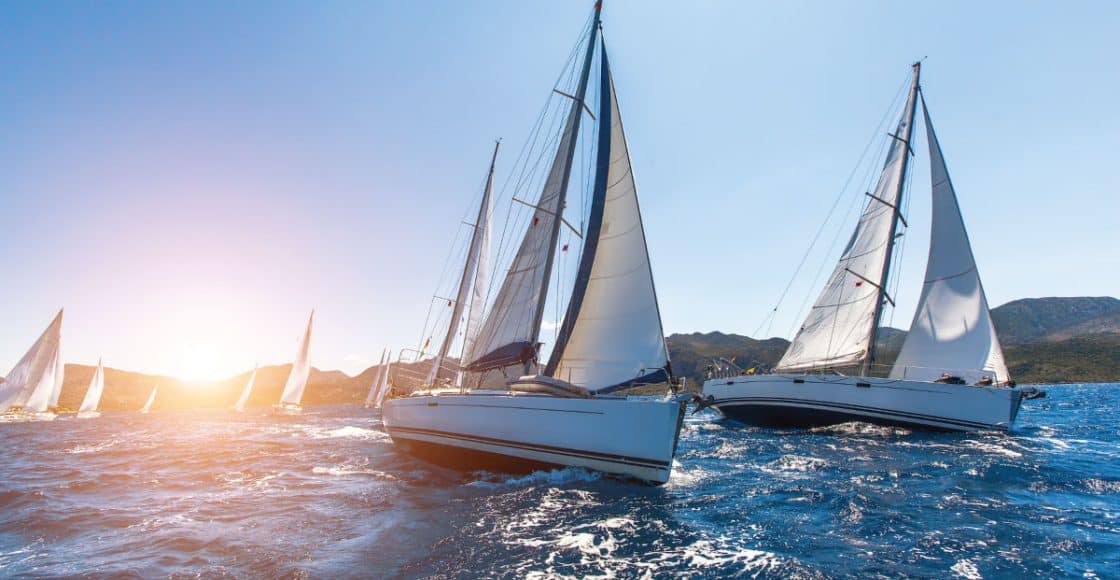
Types of Sailboats

Table of Contents
Last Updated on August 15, 2023 by Boatsetter Team
Sailboats are one type of boat, but just because they all have sails doesn’t mean they’re all the same. There are subsets of sailboats and they differ by their shape (or number of hulls), the type of sailing rig, and their best primary use. Let’s investigate.
Discover sailboat rentals near you— only at Boatsetter
Sailboat shapes
Sailboats can be monohulls or multihulls, which can be catamarans with two hulls or trimarans with three.
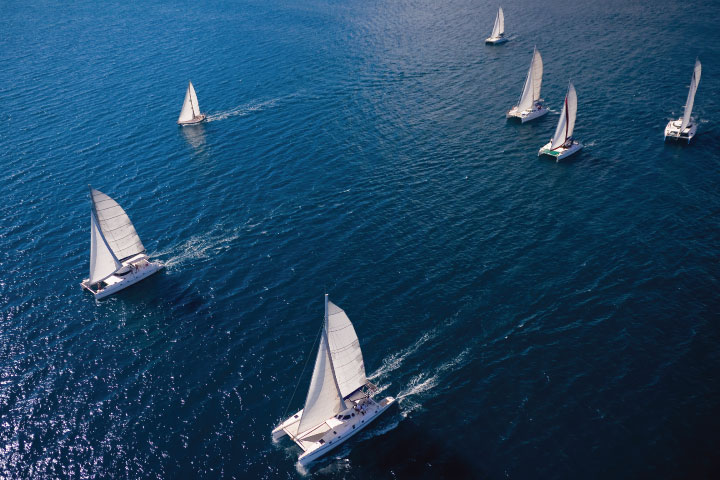
Monohulls are the classic sailing boat with one hull . Large, traditional, and older versions have deeper and heavier keels integrated into the hull for greater stability. At the same time, newer designs have fin keels that are attached rather than integrated appendages. Monohull boats can be used for racing or cruising.
Catamarans have two hulls that are connected by a bridge deck . Cats are prized for their large deck and accommodations space, stability, and shallow draft, so many mid-sized cats can be found in charter fleets worldwide.
Production cats are typically built for comfort rather than speed, but there are high-performance carbon fiber racing cats like those in the America’s Cup.
Trimarans are boats with three hulls. They can be large cruisers with fixed hull supports or small racers where the structural arms that hold the amas (outer hulls) fold to make the whole boat narrower. This is handy when fitting into a small slip or onto a trailer. Even more than catamarans, trimarans are known to be fast sailors.
More sailboats of all shapes (but especially catamarans) are experimenting with foils where the hull(s) ride out of the water to minimize wetted surfaces and maximize speed.
READ MORE: 10 Best Beginner Sailboats
Sailboat rigging
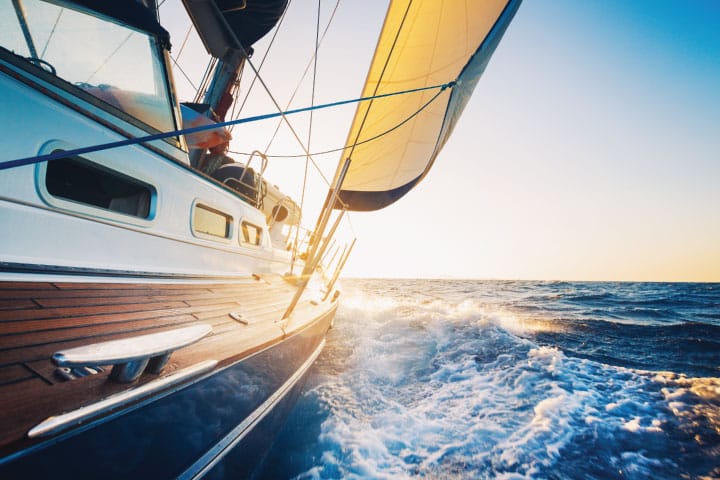
The rig of a sailboat includes the spar (mast) that holds the sails up, the boom that holds the bottom of the mainsail, and the shrouds or stays that support the mast. One sailboat can have multiple masts.
The number and placement of the masts decide what kind of boat it is. A sloop has one mast but may have multiple headsails (the sails that are in front of the mast), and therefore it may be called a cutter sloop.
A ketch or a yawl has a second smaller (mizzen) mast aft of the main mast. Schooners have multiple masts, but the secondary mast is ahead of the main mast rather than behind it. Many classic tall ships are outfitted as schooners, not generally found in modern recreational sailing.
Different uses of sailboats
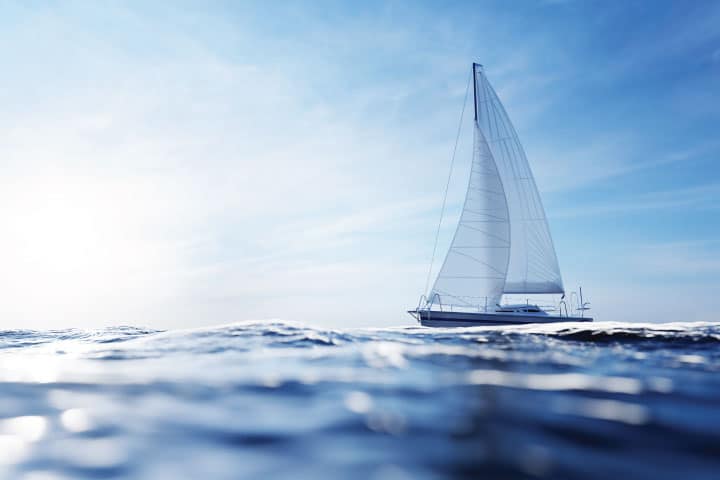
As mentioned above, sailboats can be distance cruisers, racers, or something in between . Much of how they’re used will depend on their size and shape.
- Daysailers: The primary use of a daysailer is for an afternoon sailing in a bay or harbor. You can daysail on the ocean, and any boat can be sailed for just a day. Still, typical daysailers are usually smaller (under 30 feet), have no or minimal accommodations below, and are used for short outings.
- Cruisers: Sailboats can cruise for a weekend or a lifetime. Cruisers are often outfitted with amenities to accommodate overnight stays, so they have a galley , a cabin , and a head (bathroom). They vary in size, can be mono- or multihulls, and can carry any rig type.
- Racers: Although any sailboat can be raced, some models are specifically designed to do so. They’re usually built lighter and carry more sail area.
- Racer-cruisers: Racer-cruisers are performance boats (usually sloops) that can cruise. Some sailors will argue that there’s no such thing and that it’s all marketing rather than reality as companies try to make customers believe their boats are fast. Lightly built cruisers are often classified as racer-cruisers.
- Bluewater cruisers: Sailboats designed to cruise across oceans are often called bluewater cruisers. They’re well equipped, have large water and fuel tanks, and are often loaded with technical and cruising gear to be able to stay at sea for a long time. Again, these sailboats can have any number of hulls or masts to qualify for this moniker.
- Motorsailers: Heavy sailboats with big engines may be called motorsailers but it’s not a name that appeals to their owners because it implies the boat is heavy and slow under sail.
- Sailing dinghies: Small sailboats that are often used to teach sailing are sailing dinghies. They’re designed for one or two people and can be basic like a Lido or Sabot or competition level such as a Finn, Nacra, or Laser.
Learn more about sailboats with Boatsetter
An expert sailor knows a sailboat isn’t just a boat with sails — there are nuances and knowing the differences will make you not only better informed, it will also enable you to decide which kind of sailboat is right for you.
Of course, the best way to get to know a sailboat is by hands-on practice . Rent a sailboat — with a captain or to sail solo — and get on-the-water practice. In no time, you’ll be a pro.
Boatsetter is a unique boat-sharing platform that gives everyone— whether you own a boat or you’re just renting — the chance to experience life on the water. You can list a boat , book a boat , or make money as a captain .
List. Rent. Earn— Only at Boatsetter

Zuzana Prochazka is an award-winning freelance journalist and photographer with regular contributions to more than a dozen sailing and powerboating magazines and online publications including Southern Boating, SEA, Latitudes & Attitudes and SAIL. She is SAIL magazines Charter Editor and the Executive Director of Boating Writers International. Zuzana serves as judge for SAIL’s Best Boats awards and for Europe’s Best of Boats in Berlin.
A USCG 100 Ton Master, Zuzana founded and manages a flotilla charter organization called Zescapes that takes guests adventure sailing at destinations worldwide.
Zuzana has lived in Europe, Africa and the United States and has traveled extensively in South America, the islands of the South Pacific and Mexico.
Browse by experience

Explore articles
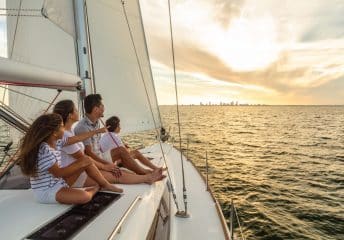
How to Build a Budget to Buy a Sailboat

5 Ways to Make the Most of Your Fishing Trip When Renting a Boat
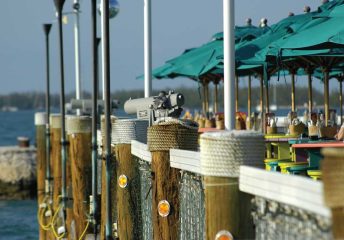
8 Key West Restaurants on the Water
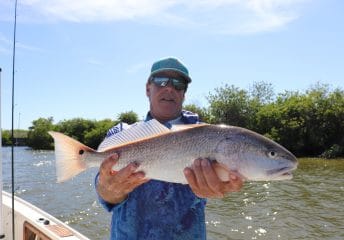
Fishing Report from Tampa Bay - Late October Morning
Types of Sailboats, Activities and Uses
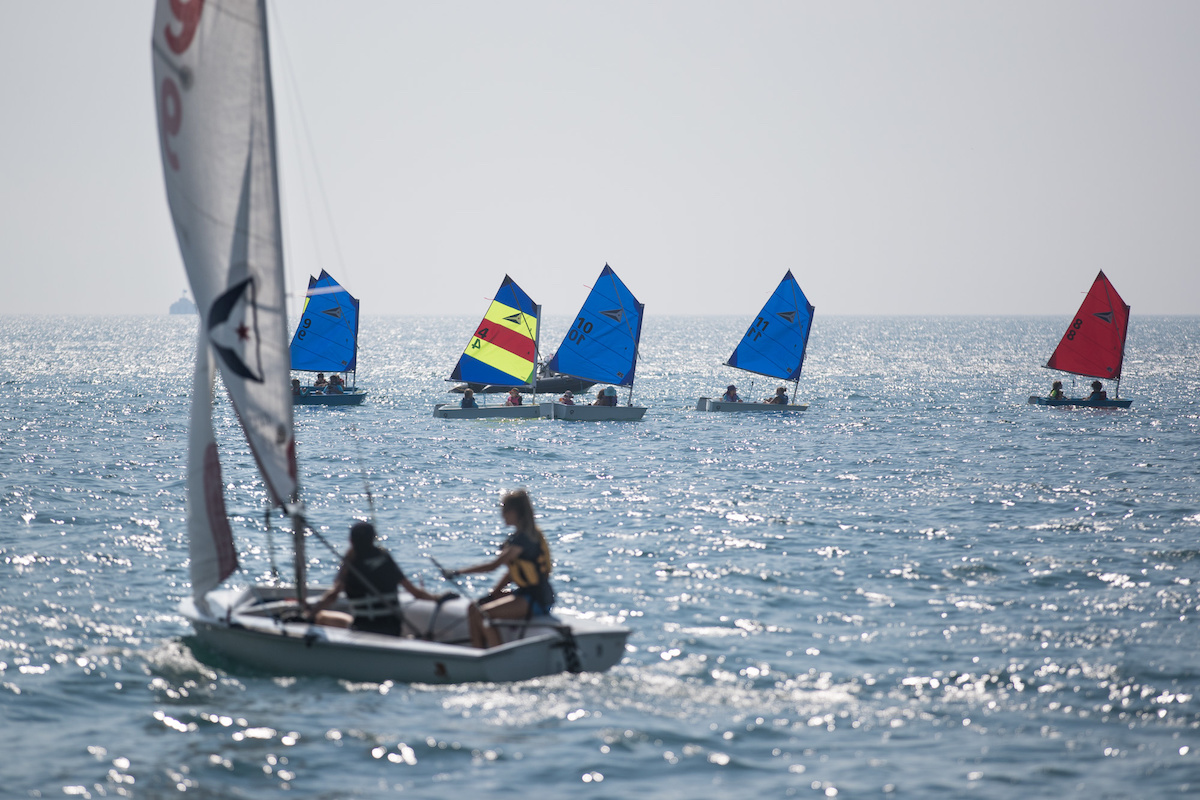
Sailboats may be boats with sails, but they’re not one homogenous category. Sailboat types differentiate by design and use, and even the type of culture that permeates each subgroup. Let’s divide sailboats by hull types, rig types and activities/uses.
Explore Sailboat Brands
Sailboat Hull Types
Sailboats ride on different hulls, which differ in the total number of hulls and their shape. The basic three hull types include:
- Monohulls (one hull)
- Catamarans (two hulls)
- Trimarans (three hulls)
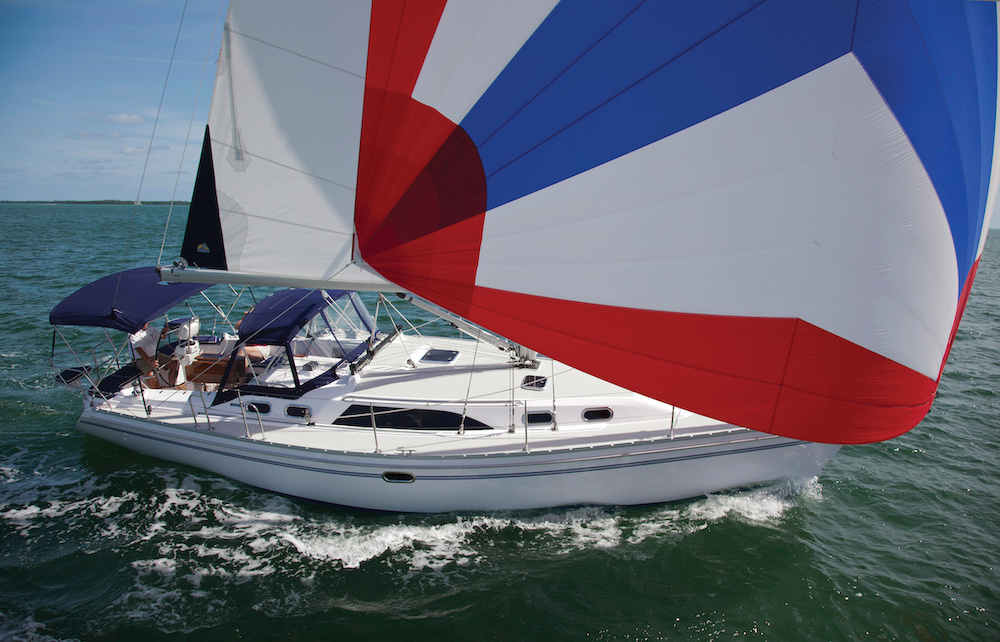
Monohulls have one hull but that doesn’t make them all the same. Traditional monohulls may have full keels (heavy encapsulated ballast that runs along the bottom of the hull), cutaway keels (similar to full but the forefoot is cutaway allowing the boat greater maneuverability in tight quarters) or bolted on fin keels that may have a bulb at the bottom for extra ballast to keep the vessel stable.
Monohulls can also have a swing keel, daggerboard or centerboard that retracts up into an appendage in the hull itself. With the keel or board up, the boat can enter shallow water and can travel faster downwind. With the keel down, the vessel tracks better upwind.
Small monohulls like sailing dinghies, may also have shallow planing hulls that can surf off a wave. Finally, monohulls can also foil on appendages (usually made of carbon fiber) with the actual hull out of the water when a minimum speed is reached.
Catamarans (often nicknamed "cats") have two hulls with a deck or trampoline in between. Large cats (35 feet and over) have become popular in charter use because they offer more interior and deck space and an easier motion to induce less seasickness. Small catamarans usually have just a trampoline in between the hulls and make fun daysailers.
Because catamarans don’t have deep and heavy keels, they tend to sail faster off the wind. Foiling catamarans were made popular by the America’s Cup races and are proliferating into general cruising use.
Trimarans have three hulls: a main hull and two amas (side hulls used for stability). On some trimarans, the arms that hold the amas can fold inward, making the trimaran narrower and in some cases trailerable. Large cruising trimaranas are gaining popularity because they are stable and fast sailers.
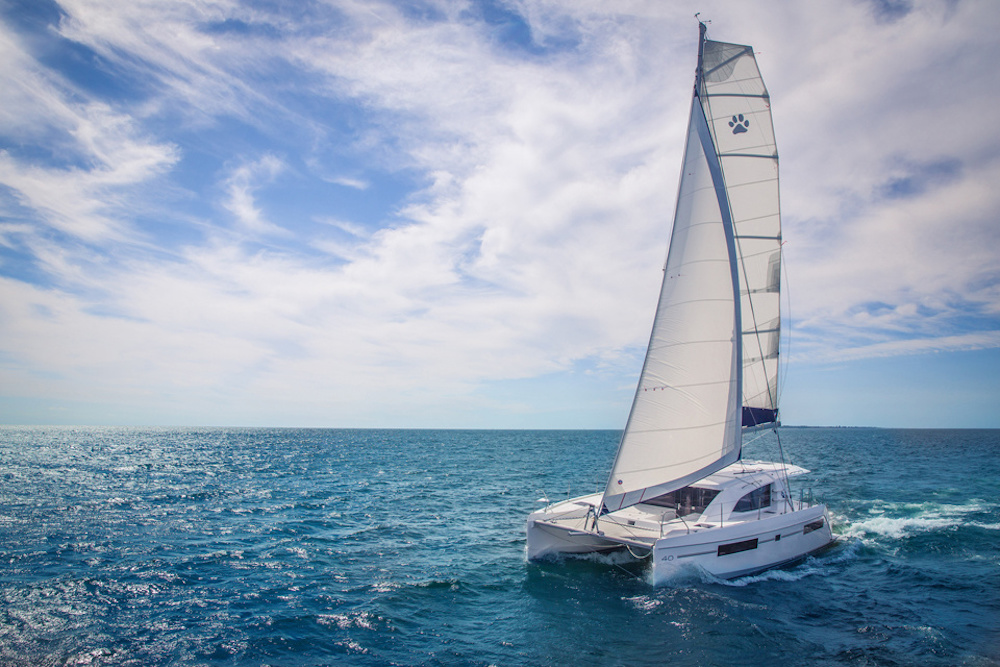
Sailboat Rig Types
Sailboat rigging includes:
- the mast(s);
- and the shrouds or stays that hold up the mast.
A sailboat with one mast is usually a sloop with one mainsail and one headsail.
A cutter rig usually has one mast but two or more headsails. This rig “cuts” the foretriangle between the head (forward) stay and the main mast. Multiple headsails allow for flexible sail combinations in variable wind conditions.
Ketches and yawls have a secondary mast behind the main one. The ketch configuration places that mizzenmast behind the mainmast but ahead of the rudderpost while the yawl places it behind the post. The second mast is shorter than the main mast. Both of these designs (split rigs) provide more sail area that isn’t reliant solely on the height of the mainmast and therefore can be easier to manage when sailing shorthanded.
Schooners also have multiple masts—two or more. However, the foremost mast is shorter than the main mast. Tall ship rigging is in its own category and can get quite complex.
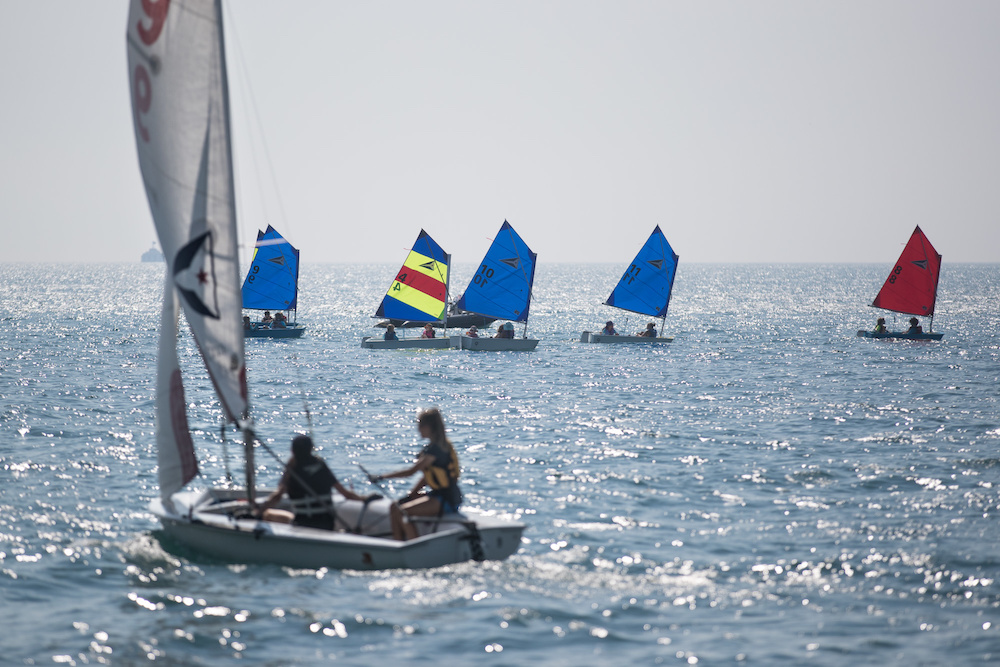
Sailboat Types by Primary Use
You can do many of the same things on all sailboats, but some types are more specialized.
Sailing dinghies: Small boats usually sailed by one or two people, sailing dinghies are often used to teach new sailors. That said, experts on high tech sailing dinghies compete in athletic racing up to Olympic level.
Day cruisers: Although any sailboat can be cruised for a day, day cruisers are often boats shorter than 30 feet that are designed to be sailed for an afternoon. They’re usually more Spartan in their outfitting and may or may not have a cabin with amenities.
Sailing cruisers: These sailboats can be monohulls or multihulls and are designed to cruise for weekends or longer. They usually have a berth (bed), a head (toilet) and a galley (kitchen). They can be sloop, cutter, ketch, yawl or schooner-rigged and vary in length (from 25-85 feet). Larger sailboats tend to fall into the crewed superyacht category.
Racing sailboats: Most offshore racers are larger boats crewed by multiple individuals while smaller racers can be single or double-handed. Racing boats are usually built lighter, have fin keels and laminate performance sails.
Racer/cruisers: These designs try to straddle the two above. They’re usually more lightly built cruisers with full amenities so they can be weekended. Some people will argue that these boats are a compromise for owners who want to primarily cruise but also race.
Bluewater cruising sailboats: These boats are designed to cross oceans or sail “blue waters.” They’re typically heavier in build with a stout rig and are fully equipped for extended offshore use.
Motorsailers: This term has fallen out of favor since it’s often pejorative. These sailboats may rely on the engine to sail in light wind conditions, especially due to their excessive weight.
Antique/classic sailboats: These are usually older restored vessels. They may be built of wood and have classic yawl rigs. These sailboats are often showcased in special events.
Sailboats occupy multiple segments and experienced sailors learn the finer points of design and use. Then, they never see two sailboats the same way again.
Read Next: Buying a Sailboat: Factors to Consider
You Might Also Like:
- Why Sailing?
- Learning the Basics of Sailing
- Sailing Basics: 10 Nautical and Sailing Terms to Know
- Explore Sailboat Brands & Manufacturers
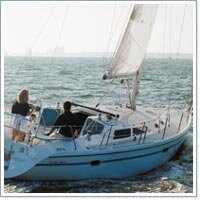
Join Our Newsletter!
Get community news, buying bargains, and how-to guides at your fingertips.
The simplest entrance to the world of sailing
Types of Sailboats – The Ultimate Guide
There exist many different sailing boats types and they can be classified by various criteria. This blog post discusses the most common types of sailboats (both modern and traditional). Sailboats are classified by:
- the number of hulls
- construction material .
Types of Sailboats by Size
Sailboat division by size could be as follows:
- Sailing dinghies (small)
- Cruising sailboats (mid size)
- Tall ships (large).
Dinghies are small sailing boats, typically up to 6 meters long (approximately 20 feet). They are open (i.e. they don’t have a cabin) and most often don’t have an engine. Operated by a crew of one or two persons, they are used for shorter (day) sailings in coastal regions. There are many different types of sailing dinghies and they could be divided to traditional dinghies (typically made out of wood) or modern dinghies (typically made out of fiberglass ). Most modern dinghies are allowed to capsize (i.e. overturn) and recover as an integral part of their use.
Here are some of the most popular types of modern dinghies:
- Optimist – small single-handed dinghy for young people under the age of 15
- Laser – single-handed dinghy, an Olympic class since 1996
- 420 – 4.2 meters long double-handed dinghy used for racing and teaching
- 470 – 4.7 meters long double-handed dinghy, an Olympic class since 1976.
Remark: The term dinghy can also refer to any small boat carried by a larger boat in order to facilitate access to/from the shore.
Cruising Sailboats
Cruising sailboats are typically 6 to 20 meters long (approximately 20-60 feet), but can be even longer. They have cabins which allow for onboard sleeping and longer cruises that might last an arbitrary number of days. Also, they normally have either an outboard or an inboard engine which is used for leaving from and returning to the berth, as well as to provide propulsion when there is not enough wind. As opposed to sailing dinghies, cruising sailboats can be safely sailed during the night and are not intended for capsizing. Different cruising sailboat types are listed below by the rig type.
Remark: The term cruising sailboat is used for mid-sized sailboats, since nowadays sailing is practiced mainly for pleasure and sport, be it cruising or racing. However, it should be clear that mid-sized boats were historically used for work, trade or even military purposes.
Tall ships are large sailing boats, typically over 40 meters long (approximately 130 feet). They use traditional sails which are set on multiple masts (2 to 5). When talking about tall ships first thing that comes to mind might be old wooden ships that sailed the oceans from 15th to 19th century and were used for trade and military purposes. However, there also exist modern tall ships that are built from modern materials and are used for tourism (cruising) or training (navy cadets). For more information, check out Wikipedia’s Tall ship article.
Rig is the name for the arrangement of masts and sails on a boat. There are basically two main rig types:
- Fore-and-aft rig.
Square rig is a traditional rig typically used on tall ships. It is characterized by the sails being set perpendicular to the length of the boat (or transversely to the sailing direction). This type of rig is efficient when sailing downwind, but is unable to sail upwind (against the direction of the wind) or it performs poorly when attempting to do so. Today, square rig is used only on tall ships.
Fore-and-aft rig is characterized by the sails being set along the length of the boat (or longitudinally to the sailing direction). This type of rig is capable of sailing both upwind and downwind. All the modern sailboats (other than tall ships) are fore-and-aft rigged.
Some important fore-and-aft rig types are:
- Bermuda rig.

Lateen rig is a traditional rig type originating from the Mediterranean. It consists of a triangular sail hanging down from a spar (pole) which is hoisted on the mast at a certain angle. Lateen rig can still be seen today on smaller, wooden traditional boats. For instance, in certain places along the Croatian Adriatic coast, sailing regattas of traditional lateen-rigged boats are regularly organized.
Gaff rig is characterized by the four-sided mainsail which is hoisted along the mast and stretched between the two spars: upper one called the gaff and lower one called the boom. Gaff-rigged boats also carry a foresail called a jib. They may also carry a topsail which is hoisted above the gaff. Nowadays, gaff rig has been largely superseded by the newer Bermuda rig.
Bermuda Rig
Bermuda rig is by far the most popular type of rig on modern sailboats. It is characterized by the two triangular sails: mainsail and jib. Mainsail is hoisted along the mast and stretched along the boom (see our post: Parts of a Sailboat ). Some racing boats may carry a square top mainsail, but cruising sailboats will in most cases carry a triangular-like mainsail. Advantage of Bermuda rig over other rig types is sail efficiency and ease of sail handling. Bermuda rig is sometimes referred to as the Marconi rig.
Remark: There exist more fore-and-aft rigs, e.g. lug rig, gunter rig and others.
Cruising Sailboats by Rig Type
Cruising sailboats are fore-and-aft rigged boats with one or two masts. Older boats were mostly gaff-rigged and they might still be seen today, while modern and new build boats are almost exclusively Bermuda rigged. The most common single-masted cruising sailboat types are:

The most common two-masted cruising sailboat types are:

Single-masted
Sloop is a boat with a single mast. In this blog and in Your First Sailing Handbook the most widespread modern type of sailing boat is considered and that is a Bermuda rigged sloop.
Cutter is a boat with a single mast that normally sails with two or more foresails (jibs) simultaneously. It is more demanding for sailing than sloop, as there is one additional sail to handle. However, cutters offer some advantages (primarily for offshore sailing) as discussed in this Cutter or sloop rig? article. The term cutter might also refer to:
- a small, light sail- or oar-powered boat carried by a larger vessels
- a fast and agile official vessel used by the authorities to enforce law (e.g. US Coast Guard cutter)
- a fast boat from the 18th century carrying both fore-and-aft and square sails.
Ketch is a boat with two masts, the taller foremast (mainmast) and the shorter after mast (mizzen mast). Ketch is characterized by the rudder post being positioned abaft the mizzen mast.
Yawl is a boat similar to a ketch, the difference being that the rudder post is positioned forward of the mizzen mast. Also, yawl’s mizzen mast is typically shorter than that of a ketch.
Schooner is a boat with two or more masts, where the foremast is no taller than the after masts. In case of a two-masted schooner, taller aftermast is called the mainmast.
Why Sloops are so Popular Nowadays
Cutters, ketches, yawls and schooners were once popular because they could have the same sail area as sloops with the individual sails being smaller and thus easier for handling. However, development of modern equipment made sail handling much easier irrespective of the sail size. This is one of the reasons why sloop has become the most widespread cruising sailboat type today. Another reason is that rigs with two masts are more expensive to build and maintain. Finally, sloops generally perform better when sailing upwind. For more information see the following post discussing two-masted sailboats .
.Modern sloops can be categorized to cruisers, racers and performance cruisers. Cruising sloops sacrifice sailing performance for comfort, meaning that the interior is well equipped but heavy, while sail handling is easy but suboptimal in terms of sailing efficiency. On the other hand, racing sloops usually have bare interior (in order to reduce weight), but large cockpits to give the crew enough space to handle many different sails and work with many lines. Finally, performance cruisers usually offer a good trade-off between cruisers and racers, providing good comfort below the deck and decent sailing performance above the deck.
Types of Sailboats by the Number of Hulls
All the cruising sailboat types mentioned above are monohulls (they have one hull). However, sailboats may have more than one hull and they are called catamarans (in case of two hulls) or trimarans (in case of three hulls). Catamarans and trimarans are jointly called multihulls. Multihulls are typically single-masted and Bermuda-rigged, while being built from modern materials like fiberglass .

Dinghy catamarans are usually very agile and fun for sailing, but they require a skilled crew. Due to their low weight, they heel easily during sailing, resulting in one hull being raised above the water, which in turn reduces water resistance and allows the boat to sail faster.
On the other hand, majority of cruising catamarans are heavy and don’t heel much during sailing in normal conditions. They might not be as fun for sailing as monohulls, but they offer a lot of comfort since their interior is quite spacious. Compared to similarly equipped and sized monohulls, cruising catamarans have poorer performance upwind, but are usually faster downwind.
There also exist performance catamarans and trimarans which are built for speed and they are much faster than monohulls of similar size. Such boats are not widely available for chartering since they require a skilled crew.
Types of Sailboats by Construction Material
Main part of any boat is its hull and it can be constructed from different materials. Trade-off has to be made between strength and weight. Generally speaking, you want the sailboat to be strong and safe, while at the same time you want it to be light and fast. Main boat building materials are:
- Composite materials.
Traditionally, sailboats of all sizes were made out of wood and there is still a fair amount of wooden boats sailing today. Even though wood does not have favorable characteristics like modern composite materials, many owners prefer wooden boats for aesthetic and nostalgic reasons. Also, there are still new wooden sailboats being built either for private owners (often dinghies or smaller cruisers) or as a part of maritime heritage preservation projects. Wooden boats are very nice and appealing, especially if maintained properly, however that requires a lot of time and dedication.
Sailboat’s hull can also be constructed out of metal, most often steel and aluminum. Steel is very strong, but heavy, while aluminum is much lighter, but not as strong as steel. Precautions must be taken to prevent corrosion of both materials. Steel suffers from rusting, while aluminum suffers from galvanic corrosion.
Composite Materials
Vast majority of modern sailboats is made out of fiberglass, a composite material also known as glass-reinforced plastic or glass-fiber reinforced plastic. As the name suggests, this material is made from fine fibers of glass which are interwoven into fabrics and then reinforced with resin. Fiberglass is easily molded to form hulls and decks of different shapes. This allows fiberglass boats to be mass produced simply and cheaply, which is one of the reasons for their popularity. Fiberglass is very durable, so fiberglass boats have long life expectancy with relatively easy and simple maintenance. This is because fiberglass does not rot like wood, nor does it suffer from corrosion like steel and aluminum.
Modern high performance racing boats are typically made from carbon fibers which is a short name for carbon-fiber reinforced plastic. This technology is very similar to fiberglass, with the glass fibers being replaced by the carbon fibers. In comparison, carbon fiber technology offers much better strength-to-weight ratio, but it is also much more expensive than fiberglass. High price is the main reason hindering mass production of carbon cruising sailboats.
Vedran Bobanac
Vedran Bobanac has been sailing since the age of 10, while he has been working as a skipper and as a sailing instructor for almost 20 years now. He also holds PhD degree in electrical engineering and he enjoys using his technical knowledge, as well as pedagogical skills to teach sailing and publish sailing handbooks .

Royal Navy Ship HMS Trent Seizes Cocaine Worth £40 Million In The Caribbean Sea

Seafarers Hospital Society Launches Pilot Project To Support Women At Sea

Hydrocell Launches The First Hydrogen-Powered Boat

Indian Port Workers Call Off Strike After Agreeing To New Wage Settlement

Types of Sailboats – A Comprehensive Classification
Traditionally, sailboats were made of marine wood and other materials however; modern ones use premium marine lumber products. Sailboats are divided into subclasses, and one such is the catamaran which is made of fiberglass, which makes it more durable and low maintenance.
Sailboats are propelled by wind captured through their sails, masts and rigging lines. Some are equipped with generators, wind makers and other technologies to generate more power, hence providing more speed. They are considered a separate class of vessels independent of motor-powered crafts since their hydrodynamic characteristics differ.
They can vary in occupancy from single-seater crafts for competitions or adventure sailing to recreational vessels spanning hundreds of metres that can host up to thirty individuals. The luxury yachts are ideal to experience sailing in comfort and style. These vessels are known for their remarkable craftsmanship and innovative design.
The most common type of sailboat is the racing sailboat, used in sailing competitions around the world. Several international events intended to raise awareness about sailing allow a wide range of craft types to participate, including catamarans and racer-cruiser.
For most sailing vessels, sail plans are often drawn up before the vessel leaves port. These plans indicate sail positions for various weather conditions.
In this article, we will go through the different types of sailboats and their key features.
Hull-Based Classification Of Sailboats
Sailboats can be classified into three distinct types based on their primary hull type.
These include
- catamarans, and
- multi-hull crafts.
Traditionally, monohulls are the most common design for sailboats since they provide storage in addition to a certain level of stability.
However, with the advent of sailing competitions and an increased focus on performance and stability features, there has been a general shift towards catamarans and trimarans.
Monohulls are single-hulled structures, much like conventional vessels , that have a large hull beam (breadth) which provides stability while sailing. The advantage of having a single large hull is that the longer beam allows for improved onboard systems and amenities. It has a cabin, a cockpit, a galley, a v-berth and a saloon as well.
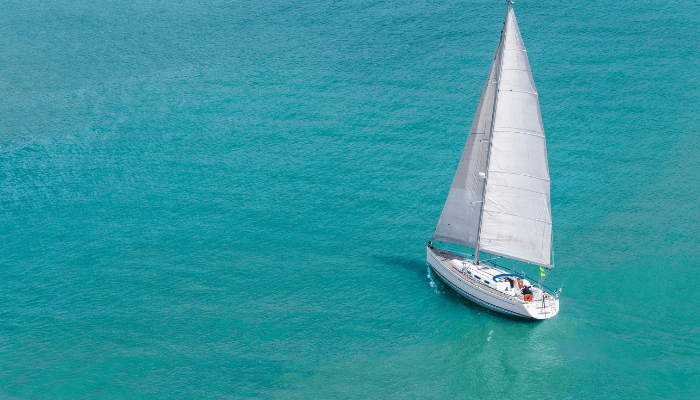
Catamarans refer to twin-hulled structures that are attached by specialized members to provide strength. The term originates from the South Indian phrase for “tied pieces of wood”, as this was the manner in which traditional sailboats were built in the subcontinent.
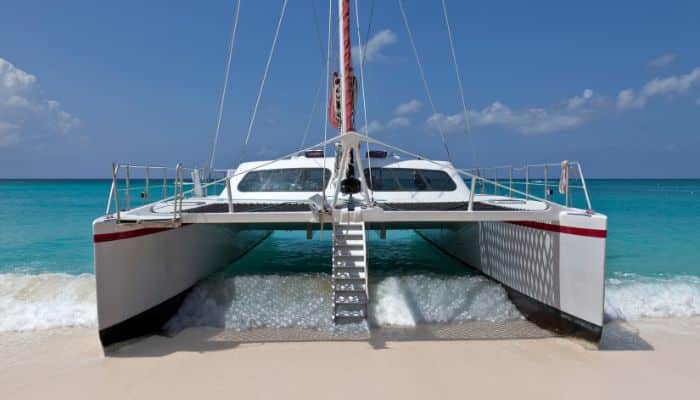
Twin hulls offer an increased level of stability. In addition, if designed properly the vessel will have a much higher speed than conventional crafts owing to lower wetted-surface resistance forces.
On the other hand, extensive care must be taken in designing the vessel, or else the resistive forces can exceed the values found in monohulls.
Multi-hull crafts, or simply multihulls, include vessels with anywhere between three to five hulls, although the three-hull variation is the most common. Such crafts are known as trimarans and are considered to be extremely stable owing to their large beam and lower centre of gravity.
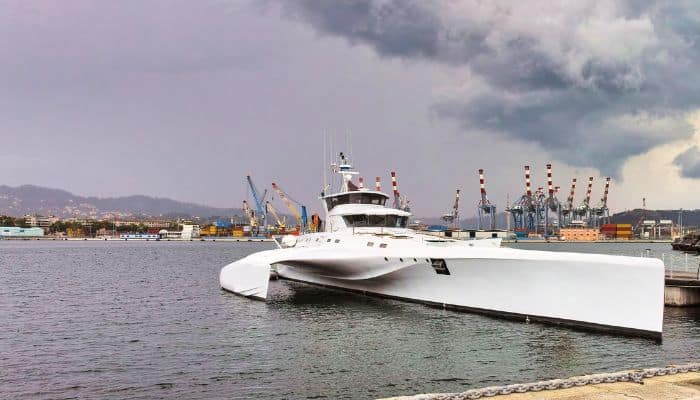
Four and five-hulled vessels are more difficult to manufacture and hence are rarely used commercially. An advanced form of the catamaran design is the SWATH version.
SWATH is an acronym for Small Waterplane Area Twin Hull, and it achieves unprecedented levels of speed owing to a considerably small waterplane area. To reduce this area, the hull has a reduced beam above the surface of the water, while underwater buoyant structures ensure that the vessel has the necessary weight balance.
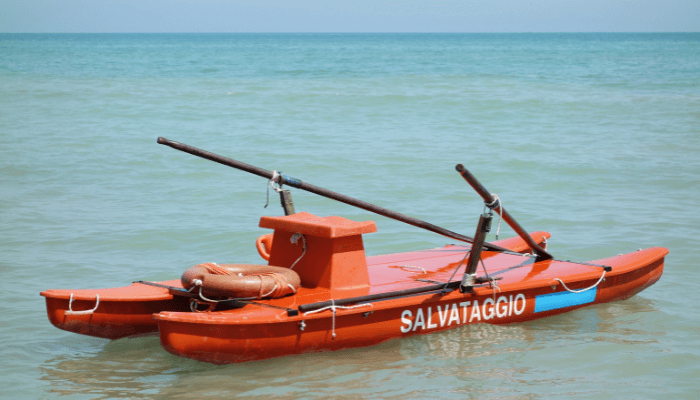
Common Monohull Designs
Monohulls are relatively easier to manufacture compared to multi-hull structures. Thus, there has been a wider range of innovations for this type of hull over the last thousand years.
The common classes of monohull crafts are – sailing dinghies, cutters, sloops, catboats, ketch and schooners.
A dinghy is a relatively common sailboat owing to its short overall length and ease of manoeuvring. They are used in competitions and in the port industry.
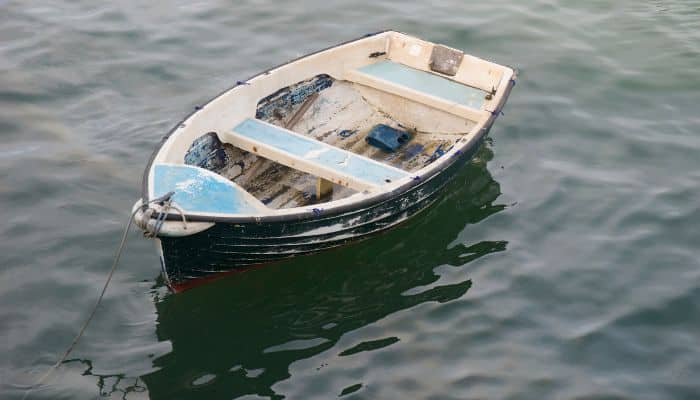
Generally, dinghies are used to transport people or small cargo to and from a larger vessel such as a cruise ship that is anchored away from the shore.
Such vessels may not be able to enter a port due to size and tonnage regulations. Hence, dinghies serve as the best mode of transporting essential goods between the port and the vessel.
Dinghies can have sails, such as the three-sailed variant consisting of the mainsail, jib and spinnaker. However, motor-powered dinghies are also commonly used especially as lifeboats onboard ships.
Cutters are another class of sailboats that are medium-sized and generally have three sails. The mainmast on which the sails are mounted is located near the stern of the ship to allow for larger sails to be used.
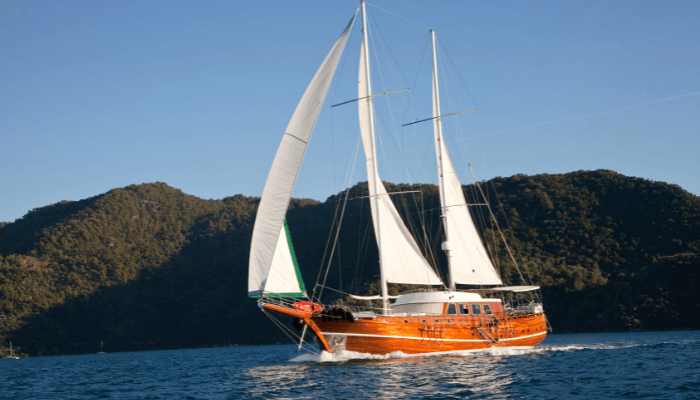
Cutters were commonly used in competitions as their design favours speed and agility. A different combination of the sails also allows cutters to be used for cruises and other recreational sailboats.
Sloops are similar to cutters and are the most commonly found sailboats. They are the standard in sail designs, with a two-sail configuration used for added manoeuvrability. They have a mainsail and a headsail called jib or genoa.
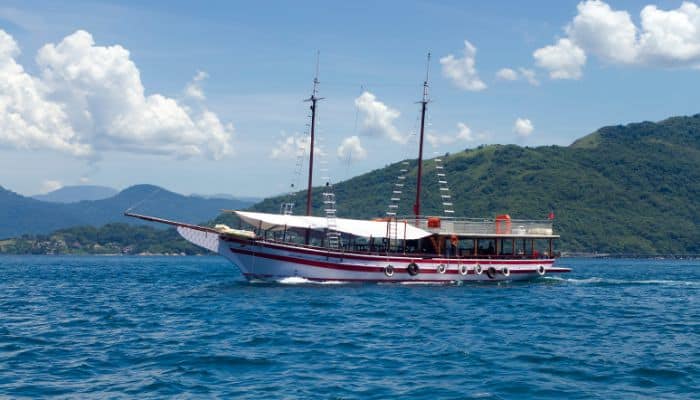
In addition to the generic sloop sail configuration, there is also a fractionally-rigged sloop in which one of the sails lies below the top of the mast.
This design allows the crews of smaller sloops to handle the craft while improving performance. Catboats are sailboats equipped with only a single sail. They are aimed at capacity rather than speed and have the mainsail mounted on a single mast.
For increased speeds, sails can be added to the rigging such that wind force is better optimized by the vessel.
The ketch is a sailboat that has two main masts- the main mast located around the midship, and the mizzen mast at the aft. The mizzen mast is generally smaller than the main mast and serves to add speed to the craft. The word ketch is derived from the word catch, denoting the manner in which the sails “catch” the wind as they move.
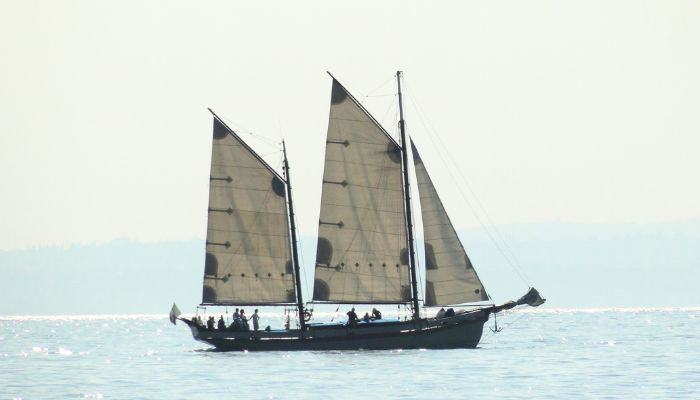
Schooners are a class of sailboats that can have more than two sails supported on masts known as the main mast and foremast. The foremast is located near the fore of the vessel and is slightly shorter than the main mast. In variations where additional masts are added to support more sails, they are positioned such that they remain shorter than the main mast depending on their sizes.
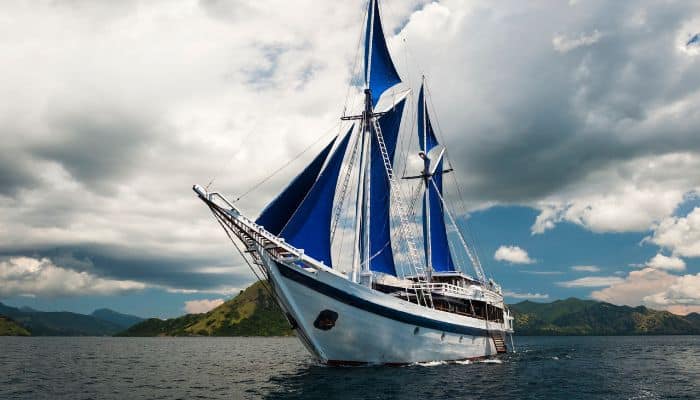
Keel Based Classification
The keel is the base of a vessel that provides a central backbone for the design of the entire structure. The boat keel is structurally relevant since it often has to carry the weight of the vessel.
In the case of sailboats, the keel is often what the entire craft rests on during transport by road or rail. Thus, keels need to have integral strength and be able to withstand a variety of forces.
Similarly, while sailing, the keel is the lowermost point of the vessel at which resistive forces act. As a result, many modifications are often made to the keel so that hydrodynamic features can be incorporated to reduce drag. Sailboats often sit high in the water owing to their design and shape.
However, for competition and performance crafts, it is essential that they try to sit as close to the surface of the water as possible without capsizing. Thus, the keel often plays the role of a central ballast, by integrating heavy iron or steel components so that the vessel draft increases.
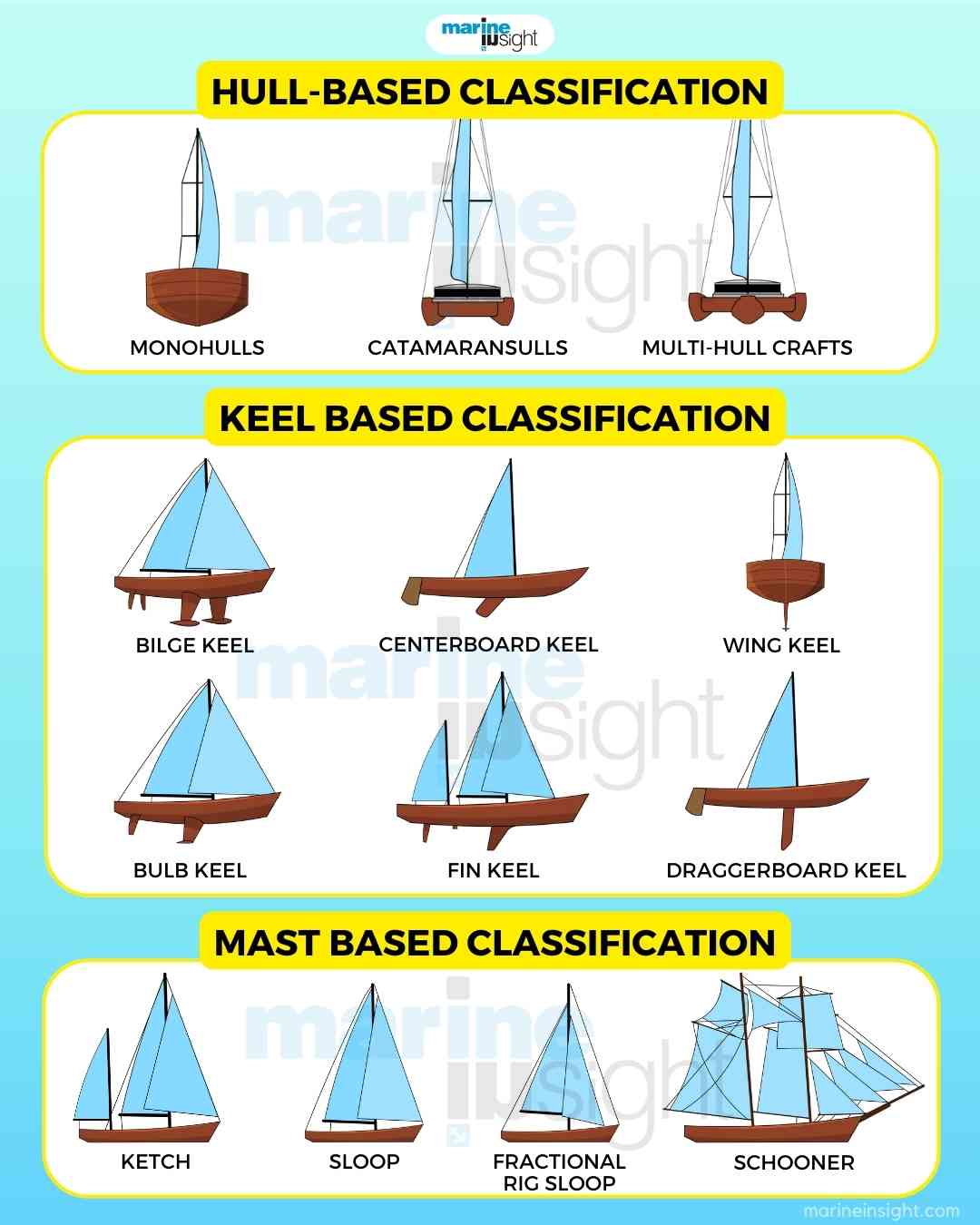
Based on keel type, there are several sailing boat variants found in the market. These generally have modified keels for improving performance and speed by integrating hydrodynamic features such as hydrofoils .
The types of keels commonly associated with sailboats are as follows: full-length keel, fin keel, centreboard keel, bilge keel, bulb keel and wing keel.
As the name suggests, full-length keels have keels that extend in the form of a long fin below the main structure of the ship. The fin runs along the length of the ship and often has an integrated rudder system attached at the stern.
The advantage of this type of keel is that it is easy to manufacture, with little cost in terms of development. Also, the ballast effect is provided by the extra weight of the full-length keel.
Since it can be difficult to enter certain ports or quays owing to the large draft that comes with this type of keel, manufacturers attempt to reduce fin depth and instead increase its length.
Fin keels , on the other hand, run only along certain regions of the sailboat. Located on the underside of the craft, it sticks out similar to the fin of a fish giving rise to this nomenclature. Since this type of keel must perform the same functions as the full-length keel without having a large length, the fin is deeper.
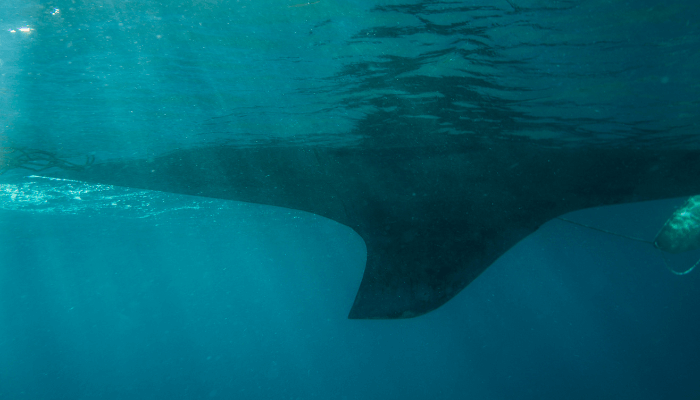
Owing to this large draft, it may be difficult to dock at certain ports due to depth restrictions. A key feature of this type of keel is that the rudder and manoeuvring systems remain independent of the fin keel, and are located at the extreme aft of the vessel. Centreboard keels are a common feature of high-performance crafts that take part in competitions. They are not restricted to monohull structures and are often found in catamarans and trimarans.
The centreboard keel employs a type of fin that is pivoted about a point on the keel of the vessel. By having a pivot, the natural flow of the vessel and surrounding water varies the depth at which the keel sits below the vessel. Similar to the fin keel, it only runs along a certain length of the vessel.
However, it is distinguished by being able to vary the angle of tilt with respect to the baseline of the craft. In some variations, the crew are able to manually change the angle of tilt, to change performance features during certain events and competitions.
Another variation of the centreboard keel is the daggerboard keel , which allows the fin to completely integrate into the underside of the vessel.
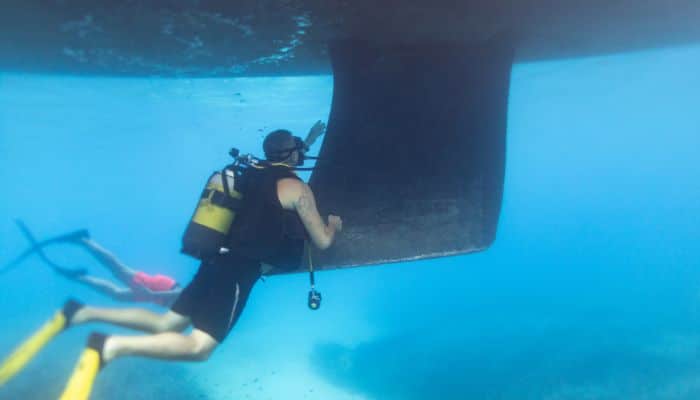
By providing a bay at the underside, the fin can be raised or lowered from the slot. In this type of keel, the raised configuration allows for higher speeds and reduced resistive forces. However, when lowered into the water, the vessel gains added stability and makes up for the loss in speed by improving hydrodynamic features.
Bilge keels refer to protrusions on the sides of the hull of the vessel, commonly called the bilges. These protrusions run along the length of the vessel while tapering into the hull panels at both ends.
The primary purpose of bilge keels is to improve the rolling stability of the craft. The fins stick out perpendicular to the hull and can vary in length depending on the purpose. For instance, sailboats require larger anti-roll stability and hence have long tapering bilge keels.
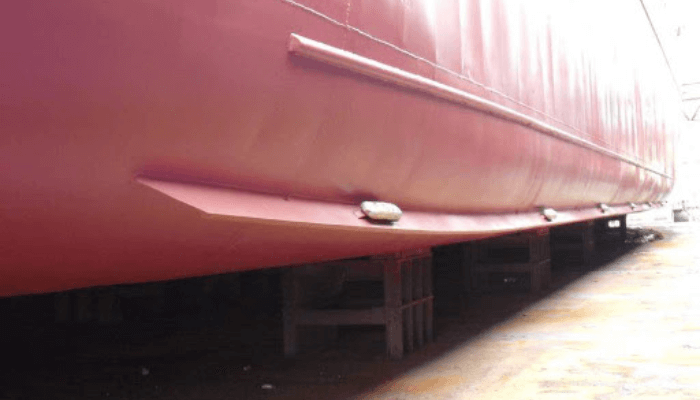
The bilge keels must be symmetrically placed on both the port and starboard sides, so as to ensure even hydrodynamic characters.
A bulb keel is a protrusion sticking vertically below the craft and terminating in an oblong-shaped hydrodynamic device called the bulb. The bulb acts as a 3D hydrofoil that improves the stability and handling of the vessel. Due to the increased wetted surface area, there is a slight drop in the speed, but it can be made up through superior handling capabilities.
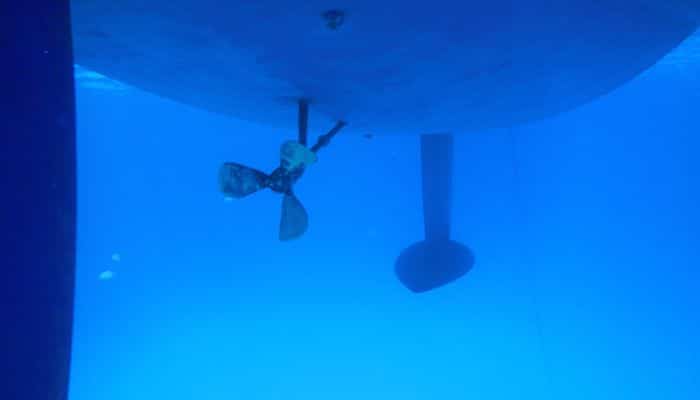
For smaller crafts, longer bulb keels are required, and as this length increases, the chance of accidental grounding of the vessel increases.
The last commonly found type of keel is the wing keel . The wing keel is similar to the bulb keel, except that instead of a bulb terminating a vertical protrusion, there are horizontal hydrofoils extending from the central shaft.
The primary purpose of the wings underneath the ship is to improve handling and stability. In addition, they slightly lift the craft above the surface of the water. As a result, the total wetted surface area remains constant and may even decrease. Thus, speed remains constant and may improve as the craft picks up velocity.
Mast Based Classifications
The mast of the vessel refers to a vertical shaft extending out of the deck which supports the sails and rigging. Older models of sailboats and ancient ships had masts constructed out of wood, while modern speed-oriented versions use galvanized steel or aluminium.
Aluminium has the benefit of being extremely light while still retaining its strength, which is important during harsh weather conditions.
The various mast-based classification includes – sloop, fractional-rig sloop, cutter, ketch, schooner and catboat.
The sloop is the most common mast type, where a single mast supports two sails called the headsail (or foresail) and the mainsail.
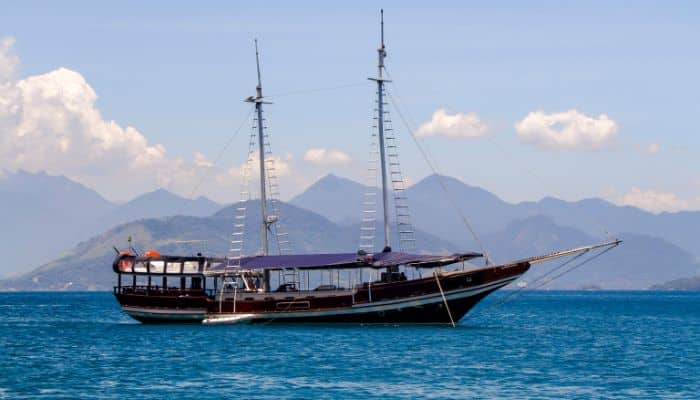
The headsail also goes by different names depending on the purpose and configuration of the sails.
In a fractional rig sloop , the forestay cable that is used to hoist the headsail is actually placed below the top of the mast. This configuration is particularly useful when it comes to performance, as the tip of the mast can be hauled towards the aft using stiff cables, and the sails can be collapsed.
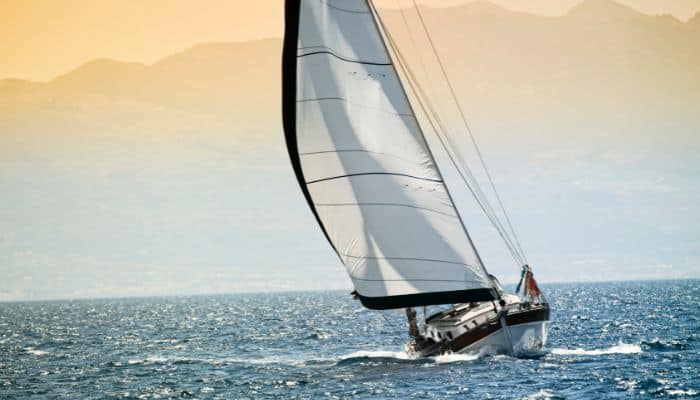
This is useful on days when wind power can be used to propel the sailboat, without the sails having to be fully extended.
Another useful feature of being able to trim or flatten the sails is that during particularly strong squalls of wind, the sails will not be punctured or ruptured due to the high wind pressure. The next type of mast configuration is the cutter. This involves a single mast supporting three sails- one mainsail, and two headsails known as the staysail hauled by the inner stay cable, and the jib hauled by the headstay cable.
The mast is located more towards the aft compared to the sloop, to allow for an easily manoeuvrable configuration. In addition, a wide range of sail arrangements makes it favourable for cruise operators and for competition purposes.
The ketc h has a two-mast configuration, with the aft mast known as the mizzen mast. The mizzen mast is located fore of the rudder post, and aft of the main mast.
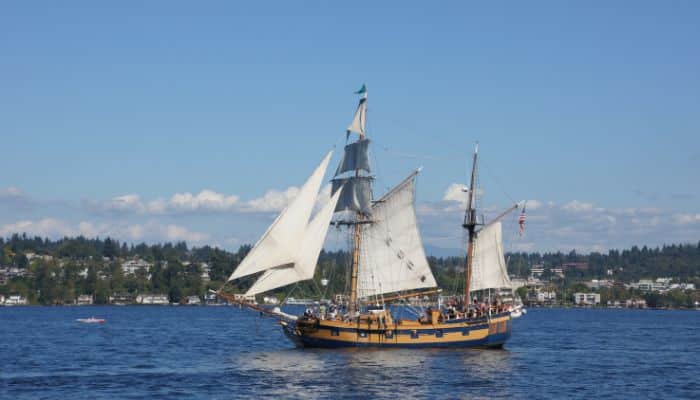
The mizzen sail rests on the mizzen mast. In general, the mizzen mast is slightly shorter than the main mast.
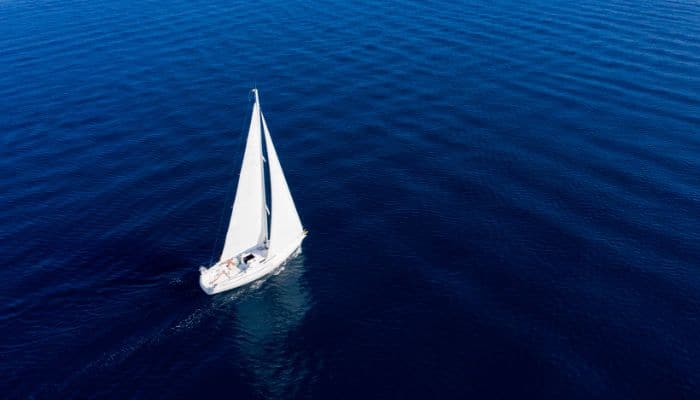
The main mast supports two sails known as the mainsail and the headsail.
The schooner is another configuration similar to the ketch, but where the aft mast is taller than the foremast.

Schooners can have multiple masts and are not restricted to commercial small and medium sailboats. The images of ancient ships that were used for trade and military purposes were often schooners having between four to six masts with an average of over ten sails each.
In addition, the sails of the schooner tend to lie along the length of the vessel, rather than along the beam. This is to prevent sail rupture during violent storms or during heavy winds. The catboat is one of the simplest configurations where only a single sail and mast arrangement are used.
The mast can be located either aft or fore of midships, with varying advantages to each configuration. The ease of design and construction makes it a favourable sailboat for beginners and trainees. However, the disadvantage behind the catboat is that the sail cannot be used to move against the direction of the wind, unlike other sail variations.
Apart from recreation purposes, sailboats are one of the most common types of vessels used in recreational purposes and competitions. They can vary in the hull, keel and sail configurations based on the primary purpose that they are intended to be used for.
For over five thousand years, sailboats have been in use, whether it has been for transportation in Ancient Egypt, or for sailing events in modern times. Technological advancements have turned the sailboat into a sleek, agile and fast vessel capable of reaching extremely high speeds by harnessing the power of the wind.
Whether it be for cruises or for racing events, sailboats and other such crafts continue to be a favourite choice for sailors.
Frequently Asked Questions About Sailboats
1. how many different kinds of sailboats are there.
There are many types based on their hull type- monohulls, catamarans and trimarans; keel type- fin keel, wing keel, daggerboard, centreboard; mast configuration and sails- sloop, fractional rig sloop, schooner, ketch, yawl, cutters and catch.
2. What is the most common type of sailboat?
The sloop is the most common sailboat. It has a mast, two sails, commonly a Bermuda rigged main and a headsail. They include a gaff rig, a mix of gaff and square rig or a Bermuda rig.

3. What is a four-masted sailboat called?
It is called a schooner. Traditional schooners have a gaff-rig, which means that they have a square topsail on the front of the mast. They were mainly constructed for carrying cargo, passengers and for fishing.
4. How many masts does a ketch have?
Ketch has two masts whose main mast is taller than the mizzen mast. It is similar to a yawl and has a triangular mizzen sail and a triangular or square headsail. Due to their smaller sails, they are easily manageable and preferred by sailors.
5. What is the most beautiful sailboat?
Some of the most beautiful sailboats in the world include Pelagic Australis, Thomas W Lawson, Royal Clipper, Barque Sedov and Amerigo Vespucci.
6. What are some popular sailboat brands?
Beneteau, Sparkman and Stephens, Oyster Yachts, Amel Yachts and Nautor’s Swan are some popular sailboat brands that sell the most number of sailboats yearly.
You Might also like to read
- Real Life Accident: Officer Of The Watch Ignores Lookout’s Warning, Ship Collides with Sailboat
- Introduction To Different Types Of Yachts
- 12 Sailing Books For Beginners
- The Ultimate Guide to Different Types of Boats – Top 20
- Main Types of Catamarans Used in the Shipping World
- What are Tug Boats – Types And Uses
Disclaimer : The information contained in this website is for general information purposes only. While we endeavour to keep the information up to date and correct, we make no representations or warranties of any kind, express or implied, about the completeness, accuracy, reliability, suitability or availability with respect to the website or the information, products, services, or related graphics contained on the website for any purpose. Any reliance you place on such information is therefore strictly at your own risk.
In no event will we be liable for any loss or damage including without limitation, indirect or consequential loss or damage, or any loss or damage whatsoever arising from loss of data or profits arising out of, or in connection with, the use of this website.

About Author
Ajay Menon is a graduate of the Indian Institute of Technology, Kharagpur, with an integrated major in Ocean Engineering and Naval Architecture. Besides writing, he balances chess and works out tunes on his keyboard during his free time.
Read More Articles By This Author >

Do you have info to share with us ? Suggest a correction
Daily Maritime News, Straight To Your Inbox
Sign Up To Get Daily Newsletters
Join over 60k+ people who read our daily newsletters
By subscribing, you agree to our Privacy Policy and may receive occasional deal communications; you can unsubscribe anytime.

BE THE FIRST TO COMMENT
Leave a reply.
Your email address will not be published. Required fields are marked *
Subscribe to Marine Insight Daily Newsletter
" * " indicates required fields
Marine Engineering
Marine Engine Air Compressor Marine Boiler Oily Water Separator Marine Electrical Ship Generator Ship Stabilizer
Nautical Science
Mooring Bridge Watchkeeping Ship Manoeuvring Nautical Charts Anchoring Nautical Equipment Shipboard Guidelines
Explore
Free Maritime eBooks Premium Maritime eBooks Marine Safety Financial Planning Marine Careers Maritime Law Ship Dry Dock
Shipping News Maritime Reports Videos Maritime Piracy Offshore Safety Of Life At Sea (SOLAS) MARPOL

All You Need to Know: Explaining the Different Types of Sailboats
Sailboats are a type of watercraft that are powered by the wind. They come in a variety of shapes and sizes, each with its unique characteristics and features. Understanding the different types of sailboats and their uses can be helpful for those who are interested in sailing or looking to purchase a sailboat.
Several factors determine the types of sailboats, including the hull type , keel type , mast configuration, and sails and rigging . The hull is the boat’s body and can be either a monohull, catamaran , or trimaran .
The keel is the underwater part of the hull that provides stability and can be either a fin keel, wing keel, bilge keel, daggerboard, or centerboard. The mast configuration and sails determine how the boat is powered, and can be a sloop, fractional rig sloop, ketch, schooner, yawl, cutter, or cat.
Types of Sailboats
Sailboats come in many different shapes and sizes, each designed for a specific purpose. Here are the most common types of sailboats:
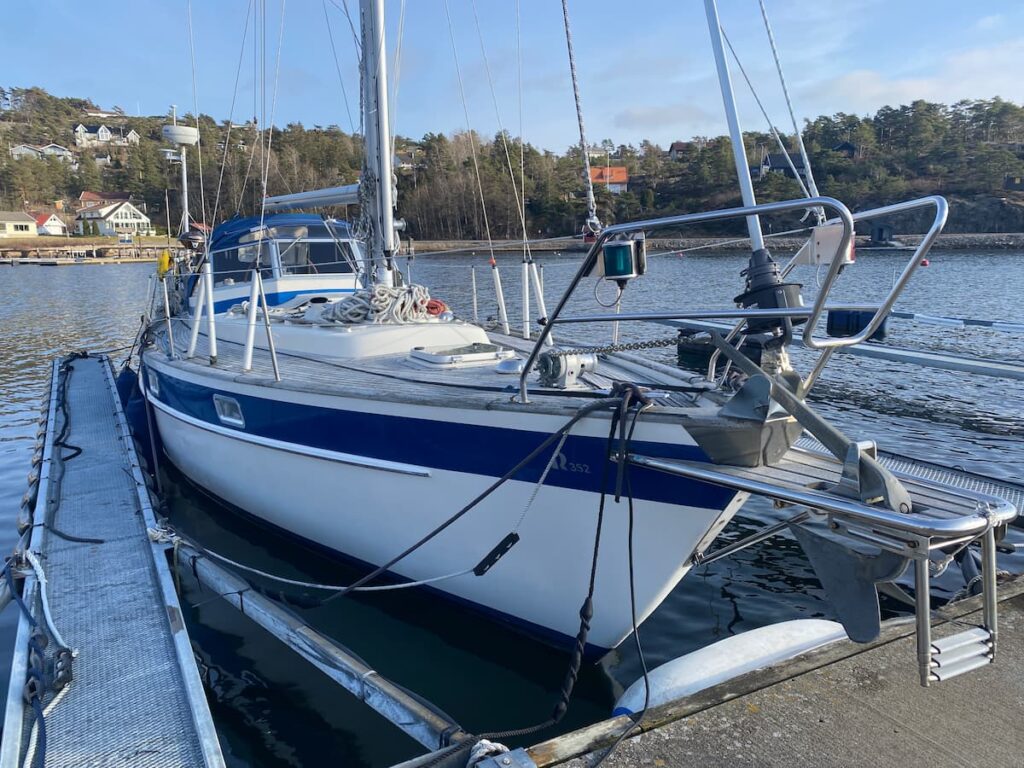
Cruising Sailboats
Cruising sailboats are designed for long-distance sailing and living aboard. They typically have a spacious interior with a galley, head, and sleeping quarters. They also have a large fuel and water capacity to allow for extended time at sea. Cruising sailboats come in many different sizes, from small pocket cruisers to large bluewater yachts.
Racing Sailboats
Racing sailboats are designed for speed and agility. They typically have a lightweight hull and a tall mast with a large sail area. Racing sailboats come in many classes , from dinghies to large offshore racing yachts. They are designed to be sailed by a skilled crew and require a high level of skill and experience to handle.
Daysailers are designed for short trips and day sailing. They typically have a simple interior with minimal accommodations. Daysailers come in many different sizes, from small dinghies to larger keelboats. They are easy to handle and are a great choice for beginners or for those who want to enjoy a day on the water without the hassle of a larger boat.
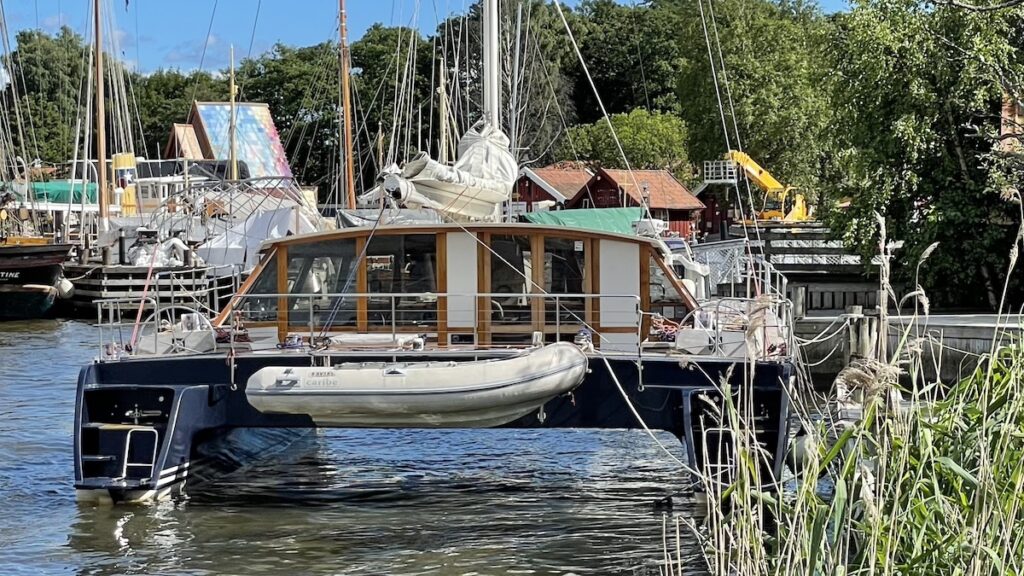
Catamarans are sailboats with two hulls. They are designed for stability and speed and are often used for cruising or racing. Catamarans have a spacious interior and a large deck area, making them a popular choice for those who want to live aboard or entertain guests. They are also popular for chartering and can be found in many popular sailing destinations around the world.
Trimarans are sailboats with three hulls. They are designed for speed and stability and are often used for racing or long-distance cruising. Trimarans have a narrow hull and a large sail area, making them incredibly fast and agile on the water. They are also popular for their spacious interior and large deck area, making them a great choice for those who want to live aboard or entertain guests.
Sailboat Hull Types
When it comes to sailboats, there are two main categories of hull types: monohull and multihull. Each has its unique characteristics and advantages.
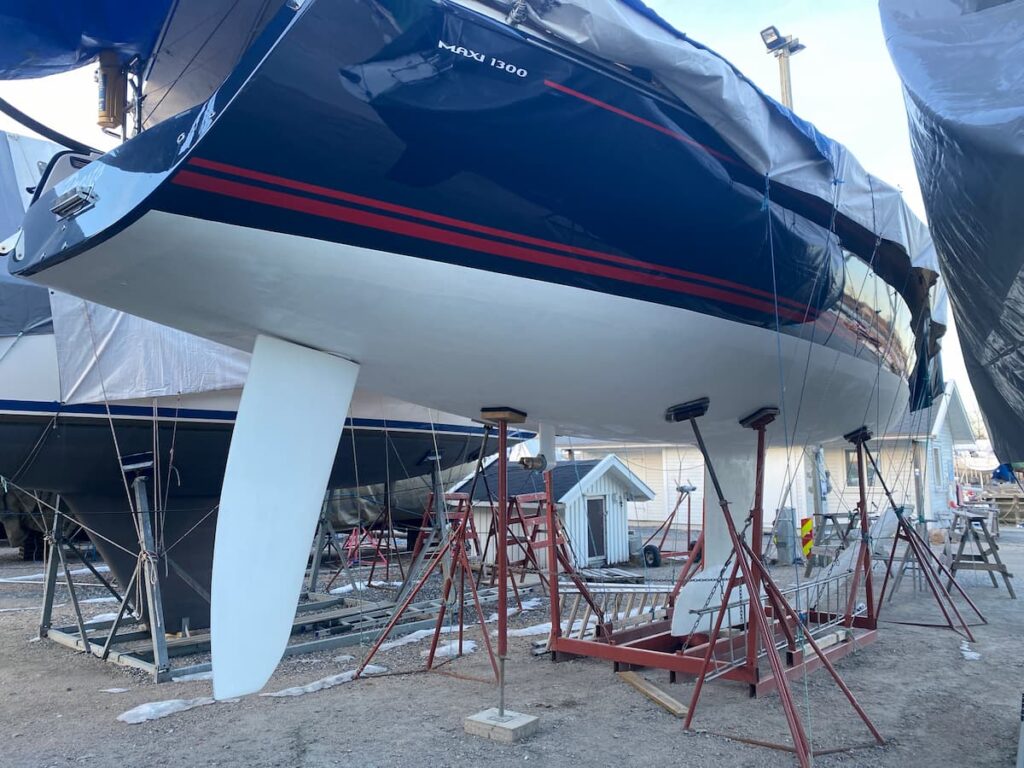
Monohull Sailboats
Monohull sailboats are the most common type of sailboat. They have a single hull, and the hull is typically long and narrow, which makes them more efficient when sailing upwind. Monohulls come in a variety of styles, including:
- Flat-bottom vessels
- Fin-keel racers
- Bulb and bilge keel cruisers
- Heavy semi-displacement sailboats
- Dense full-keel displacement cruisers
Each of these styles has its advantages and disadvantages. For example, flat-bottom vessels are the most stable, but they don’t work well in deep waters. Fin-keel racers are designed for speed and performance but may not be as comfortable for long-term cruising.
Multihull Sailboats
Multihull sailboats have two or more hulls. The most common types of multihulls are catamarans and trimarans. Multihulls have several advantages over monohulls, including:
- More stability
- Better performance in light winds
Catamarans have two hulls, which are connected by a deck. They are known for their stability and spaciousness. Trimarans have three hulls, which make them even more stable and faster than catamarans. However, they are not as spacious as catamarans.
Sailboat Rigging Types
When it comes to sailboat rigging types, there are several options to choose from. Each type of rig has its advantages and disadvantages, and choosing the right one will depend on a variety of factors, including the type of sailing you plan to do and the size of your boat . Some of the most common sailboat rigging types include:
The sloop rig is one of the most popular sailboat rigging types and is commonly used on boats ranging in size from small dinghies to large cruisers. It consists of a single mast with a mainsail and a jib or genoa. The mainsail is typically a triangular shape, while the jib or genoa is a smaller sail that is used to control the boat’s direction.
The cutter rig is similar to the sloop rig but with an additional headsail. This makes it a popular choice for sailors who want more control over their boat’s speed and direction. The mainsail is still triangular, but the headsail is typically smaller than the jib or genoa used in a sloop rig.
The ketch rig is a two-masted sailboat rigging type that is commonly used on larger boats. It consists of a main mast and a smaller mizzen mast located aft of the cockpit. The mainsail is typically triangular, while the mizzen sail is smaller and located behind the cockpit. The ketch rig is known for its versatility and is often used for long-distance cruising.
The yawl rig is similar to the ketch rig but with a smaller mizzen mast located further aft. This makes it a popular choice for sailors who want more control over their boat’s direction, especially in heavy winds. The yawl rig is also known for its ability to sail close to the wind, making it a popular choice for racing sailors.
Sailboat Sails
Several types of sails are commonly used on sailboats . Each sail has a specific purpose and is designed to work in different wind conditions. The main types of sails include mainsails, jibs, genoas, and spinnakers.
The mainsail is the largest sail on a sailboat and is typically located behind the mast. It is attached to the mast and boom and is used to capture the wind and propel the boat forward. The mainsail is the most important sail on the boat and is used in a wide range of wind conditions.
The mainsail can be adjusted in several ways to optimize its performance. The sail can be reefed, or reduced in size, to reduce the amount of sail exposed to the wind in high winds. The sail can also be twisted to adjust the shape of the sail and improve its performance in different wind conditions.
The jib is a smaller sail that is located in front of the mast. It is attached to the mast and forestay and is used to help balance the boat and improve its performance in light wind conditions. The jib is typically used in conjunction with the mainsail and can be adjusted to optimize its performance.
There are several types of jibs, including the working jib, the genoa jib, and the storm jib. The working jib is the most common type of jib and is used in moderate wind conditions. The genoa jib is a larger jib that is used in light wind conditions, while the storm jib is a smaller jib that is used in high wind conditions.
The genoa is a large jib that is used in light wind conditions. It is similar to the jib but is larger and overlaps the mainsail. The Genoa is attached to the mast and forestay and is used to capture as much wind as possible to propel the boat forward.
The Genoa is typically used in conjunction with the mainsail and can be adjusted to optimize its performance. It can be furled, or rolled up when not in use to reduce wind resistance and improve the boat’s performance.
The spinnaker is a large, balloon-shaped sail that is used for downwind sailing. It is typically used in light wind conditions and is attached to a spinnaker pole to keep it away from the boat’s mast and sails.
The spinnaker is used to capture as much wind as possible and propel the boat forward. It is typically used in conjunction with the mainsail and jib and can be adjusted to optimize its performance.

What factors determine the types of sailboats?
The factors that determine the types of sailboats include hull type, keel type, mast configuration, and sails and rigging.
What are the two main categories of sailboat hull types?
The two main categories of sailboat hull types are monohull and multihull.
What are some common sailboat rigging types?
Common sailboat rigging types include sloop rig, cutter rig, ketch rig, and yawl rig.
What are the main types of sails used on sailboats?
The main types of sails used on sailboats include mainsails, jibs, genoas, and spinnakers.
What are the differences between a catamaran and a trimaran?
A catamaran has two hulls connected by a deck, while a trimaran has three hulls. Trimarans are generally more stable and faster than catamarans, but they are not as spacious.
- Recent Posts
- The Role of Cargo Ships in Global Trade – August 22, 2024
- Report: Yang Ming’s YM Mobility Explosion at Ningbo-Zhoushan Port – August 9, 2024
- Understanding Drillships: Types, Key Features and Advancements – August 1, 2024
About the author
I worked as an officer in the deck department on various types of vessels, including oil and chemical tankers, LPG carriers, and even reefer and TSHD in the early years. Currently employed as Marine Surveyor carrying cargo, draft, bunker, and warranty survey.
Latest posts

The Quality Control Process in Marine Manufacturing
Companies in the marine manufacturing space must have tight and effective quality control processes. What steps should an effective quality control process include?

The Role of Cargo Ships in Global Trade
Contents show Volume of Goods Transported by Sea Key Global Trade Routes Economic Impact of Maritime Shipping Types of Cargo Commonly Transported Environmental Considerations Conclusion Cargo ships are the lifeline […]

What Are AGVs? Automation Becoming Increasingly Common in Seaports
What are AGVs? Automated guided vehicles can minimize the troubles of manual operations and enhance seaport operations.
The Ultimate Guide to Sail Types and Rigs (with Pictures)
What's that sail for? Generally, I don't know. So I've come up with a system. I'll explain you everything there is to know about sails and rigs in this article.
What are the different types of sails? Most sailboats have one mainsail and one headsail. Typically, the mainsail is a fore-and-aft bermuda rig (triangular shaped). A jib or genoa is used for the headsail. Most sailors use additional sails for different conditions: the spinnaker (a common downwind sail), gennaker, code zero (for upwind use), and stormsail.
Each sail has its own use. Want to go downwind fast? Use a spinnaker. But you can't just raise any sail and go for it. It's important to understand when (and how) to use each sail. Your rigging also impacts what sails you can use.

On this page:
Different sail types, the sail plan of a bermuda sloop, mainsail designs, headsail options, specialty sails, complete overview of sail uses, mast configurations and rig types.
This article is part 1 of my series on sails and rig types. Part 2 is all about the different types of rigging. If you want to learn to identify every boat you see quickly, make sure to read it. It really explains the different sail plans and types of rigging clearly.

Guide to Understanding Sail Rig Types (with Pictures)
First I'll give you a quick and dirty overview of sails in this list below. Then, I'll walk you through the details of each sail type, and the sail plan, which is the godfather of sail type selection so to speak.
Click here if you just want to scroll through a bunch of pictures .
Here's a list of different models of sails: (Don't worry if you don't yet understand some of the words, I'll explain all of them in a bit)
- Jib - triangular staysail
- Genoa - large jib that overlaps the mainsail
- Spinnaker - large balloon-shaped downwind sail for light airs
- Gennaker - crossover between a Genoa and Spinnaker
- Code Zero or Screecher - upwind spinnaker
- Drifter or reacher - a large, powerful, hanked on genoa, but made from lightweight fabric
- Windseeker - tall, narrow, high-clewed, and lightweight jib
- Trysail - smaller front-and-aft mainsail for heavy weather
- Storm jib - small jib for heavy weather
I have a big table below that explains the sail types and uses in detail .
I know, I know ... this list is kind of messy, so to understand each sail, let's place them in a system.
The first important distinction between sail types is the placement . The mainsail is placed aft of the mast, which simply means behind. The headsail is in front of the mast.
Generally, we have three sorts of sails on our boat:
- Mainsail: The large sail behind the mast which is attached to the mast and boom
- Headsail: The small sail in front of the mast, attached to the mast and forestay (ie. jib or genoa)
- Specialty sails: Any special utility sails, like spinnakers - large, balloon-shaped sails for downwind use
The second important distinction we need to make is the functionality . Specialty sails (just a name I came up with) each have different functionalities and are used for very specific conditions. So they're not always up, but most sailors carry one or more of these sails.
They are mostly attached in front of the headsail, or used as a headsail replacement.
The specialty sails can be divided into three different categories:
- downwind sails - like a spinnaker
- light air or reacher sails - like a code zero
- storm sails

The parts of any sail
Whether large or small, each sail consists roughly of the same elements. For clarity's sake I've took an image of a sail from the world wide webs and added the different part names to it:

- Head: Top of the sail
- Tack: Lower front corner of the sail
- Foot: Bottom of the sail
- Luff: Forward edge of the sail
- Leech: Back edge of the sail
- Clew: Bottom back corner of the sail
So now we speak the same language, let's dive into the real nitty gritty.
Basic sail shapes
Roughly speaking, there are actually just two sail shapes, so that's easy enough. You get to choose from:
- square rigged sails
- fore-and-aft rigged sails
I would definitely recommend fore-and-aft rigged sails. Square shaped sails are pretty outdated. The fore-and-aft rig offers unbeatable maneuverability, so that's what most sailing yachts use nowadays.

Square sails were used on Viking longships and are good at sailing downwind. They run from side to side. However, they're pretty useless upwind.
A fore-and-aft sail runs from the front of the mast to the stern. Fore-and-aft literally means 'in front and behind'. Boats with fore-and-aft rigged sails are better at sailing upwind and maneuvering in general. This type of sail was first used on Arabic boats.
As a beginner sailor I confuse the type of sail with rigging all the time. But I should cut myself some slack, because the rigging and sails on a boat are very closely related. They are all part of the sail plan .
A sail plan is made up of:
- Mast configuration - refers to the number of masts and where they are placed
- Sail type - refers to the sail shape and functionality
- Rig type - refers to the way these sails are set up on your boat
There are dozens of sails and hundreds of possible configurations (or sail plans).
For example, depending on your mast configuration, you can have extra headsails (which then are called staysails).
The shape of the sails depends on the rigging, so they overlap a bit. To keep it simple I'll first go over the different sail types based on the most common rig. I'll go over the other rig types later in the article.
Bermuda Sloop: the most common rig
Most modern small and mid-sized sailboats have a Bermuda sloop configuration . The sloop is one-masted and has two sails, which are front-and-aft rigged. This type of rig is also called a Marconi Rig. The Bermuda rig uses a triangular sail, with just one side of the sail attached to the mast.
The mainsail is in use most of the time. It can be reefed down, making it smaller depending on the wind conditions. It can be reefed down completely, which is more common in heavy weather. (If you didn't know already: reefing is skipper terms for rolling or folding down a sail.)
In very strong winds (above 30 knots), most sailors only use the headsail or switch to a trysail.

The headsail powers your bow, the mainsail powers your stern (rear). By having two sails, you can steer by using only your sails (in theory - it requires experience). In any case, two sails gives you better handling than one, but is still easy to operate.
Let's get to the actual sails. The mainsail is attached behind the mast and to the boom, running to the stern. There are multiple designs, but they actually don't differ that much. So the following list is a bit boring. Feel free to skip it or quickly glance over it.
- Square Top racing mainsail - has a high performance profile thanks to the square top, optional reef points
- Racing mainsail - made for speed, optional reef points
- Cruising mainsail - low-maintenance, easy to use, made to last. Generally have one or multiple reef points.
- Full-Batten Cruising mainsail - cruising mainsail with better shape control. Eliminates flogging. Full-length battens means the sail is reinforced over the entire length. Generally have one or multiple reef points.
- High Roach mainsail - crossover between square top racing and cruising mainsail, used mostly on cats and multihulls. Generally have one or multiple reef points.
- Mast Furling mainsail - sails specially made to roll up inside the mast - very convenient but less control; of sail shape. Have no reef points
- Boom Furling mainsail - sails specially made to roll up inside the boom. Have no reef points.
The headsail is the front sail in a front-and-aft rig. The sail is fixed on a stay (rope, wire or rod) which runs forward to the deck or bowsprit. It's almost always triangular (Dutch fishermen are known to use rectangular headsail). A triangular headsail is also called a jib .
Headsails can be attached in two ways:
- using roller furlings - the sail rolls around the headstay
- hank on - fixed attachment
Types of jibs:
Typically a sloop carries a regular jib as its headsail. It can also use a genoa.
- A jib is a triangular staysail set in front of the mast. It's the same size as the fore-triangle.
- A genoa is a large jib that overlaps the mainsail.
What's the purpose of a jib sail? A jib is used to improve handling and to increase sail area on a sailboat. This helps to increase speed. The jib gives control over the bow (front) of the ship, making it easier to maneuver the ship. The mainsail gives control over the stern of the ship. The jib is the headsail (frontsail) on a front-and-aft rig.
The size of the jib is generally indicated by a number - J1, 2, 3, and so on. The number tells us the attachment point. The order of attachment points may differ per sailmaker, so sometimes J1 is the largest jib (on the longest stay) and sometimes it's the smallest (on the shortest stay). Typically the J1 jib is the largest - and the J3 jib the smallest.
Most jibs are roller furling jibs: this means they are attached to a stay and can be reefed down single-handedly. If you have a roller furling you can reef down the jib to all three positions and don't need to carry different sizes.

Originally called the 'overlapping jib', the leech of the genoa extends aft of the mast. This increases speed in light and moderate winds. A genoa is larger than the total size of the fore-triangle. How large exactly is indicated by a percentage.
- A number 1 genoa is typically 155% (it used to be 180%)
- A number 2 genoa is typically 125-140%
Genoas are typically made from 1.5US/oz polyester spinnaker cloth, or very light laminate.

This is where it gets pretty interesting. You can use all kinds of sails to increase speed, handling, and performance for different weather conditions.
Some rules of thumb:
- Large sails are typically good for downwind use, small sails are good for upwind use.
- Large sails are good for weak winds (light air), small sails are good for strong winds (storms).
Downwind sails
Thanks to the front-and-aft rig sailboats are easier to maneuver, but they catch less wind as well. Downwind sails are used to offset this by using a large sail surface, pulling a sailboat downwind. They can be hanked on when needed and are typically balloon shaped.
Here are the most common downwind sails:
- Big gennaker
- Small gennaker
A free-flying sail that fills up with air, giving it a balloon shape. Spinnakers are generally colorful, which is why they look like kites. This downwind sail has the largest sail area, and it's capable of moving a boat with very light wind. They are amazing to use on trade wind routes, where they can help you make quick progress.
Spinnakers require special rigging. You need a special pole and track on your mast. You attach the sail at three points: in the mast head using a halyard, on a pole, and on a sheet.
The spinnaker is symmetrical, meaning the luff is as long as its leech. It's designed for broad reaching.

Gennaker or cruising spinnaker
The Gennaker is a cross between the genoa and the spinnaker. It has less downwind performance than the spinnaker. It is a bit smaller, making it slower, but also easier to handle - while it remains very capable. The cruising spinnaker is designed for broad reaching.
The gennaker is a smaller, asymmetric spinnaker that's doesn't require a pole or track on the mast. Like the spinnaker, and unlike the genoa, the gennaker is set flying. Asymmetric means its luff is longer than its leech.
You can get big and small gennakers (roughly 75% and 50% the size of a true spinnaker).
Also called ...
- the cruising spinnaker
- cruising chute
- pole-less spinnaker
- SpinDrifter
... it's all the same sail.

Light air sails
There's a bit of overlap between the downwind sails and light air sails. Downwind sails can be used as light air sails, but not all light air sails can be used downwind.
Here are the most common light air sails:
- Spinnaker and gennaker
Drifter reacher
Code zero reacher.
A drifter (also called a reacher) is a lightweight, larger genoa for use in light winds. It's roughly 150-170% the size of a genoa. It's made from very lightweight laminated spinnaker fabric (1.5US/oz).
Thanks to the extra sail area the sail offers better downwind performance than a genoa. It's generally made from lightweight nylon. Thanks to it's genoa characteristics the sail is easier to use than a cruising spinnaker.
The code zero reacher is officially a type of spinnaker, but it looks a lot like a large genoa. And that's exactly what it is: a hybrid cross between the genoa and the asymmetrical spinnaker (gennaker). The code zero however is designed for close reaching, making it much flatter than the spinnaker. It's about twice the size of a non-overlapping jib.

A windseeker is a small, free-flying staysail for super light air. It's tall and thin. It's freestanding, so it's not attached to the headstay. The tack attaches to a deck pad-eye. Use your spinnakers' halyard to raise it and tension the luff.
It's made from nylon or polyester spinnaker cloth (0.75 to 1.5US/oz).
It's designed to guide light air onto the lee side of the main sail, ensuring a more even, smooth flow of air.
Stormsails are stronger than regular sails, and are designed to handle winds of over 45 knots. You carry them to spare the mainsail. Sails
A storm jib is a small triangular staysail for use in heavy weather. If you participate in offshore racing you need a mandatory orange storm jib. It's part of ISAF's requirements.
A trysail is a storm replacement for the mainsail. It's small, triangular, and it uses a permanently attached pennant. This allows it to be set above the gooseneck. It's recommended to have a separate track on your mast for it - you don't want to fiddle around when you actually really need it to be raised ... now.

| Sail | Type | Shape | Wind speed | Size | Wind angle |
|---|---|---|---|---|---|
| Bermuda | mainsail | triangular, high sail | < 30 kts | ||
| Jib | headsail | small triangular foresail | < 45 kts | 100% of foretriangle | |
| Genoa | headsail | jib that overlaps mainsail | < 30 kts | 125-155% of foretriangle | |
| Spinnaker | downwind | free-flying, balloon shape | 1-15 kts | 200% or more of mainsail | 90°–180° |
| Gennaker | downwind | free-flying, balloon shape | 1-20 kts | 85% of spinnaker | 75°-165° |
| Code Zero or screecher | light air & upwind | tight luffed, upwind spinnaker | 1-16 kts | 70-75% of spinnaker | |
| Storm Trysail | mainsail | small triangular mainsail replacement | > 45 kts | 17.5% of mainsail | |
| Drifter reacher | light air | large, light-weight genoa | 1-15 kts | 150-170% of genoa | 30°-90° |
| Windseeker | light air | free-flying staysail | 0-6 kts | 85-100% of foretriangle | |
| Storm jib | strong wind headsail | low triangular staysail | > 45 kts | < 65% height foretriangle |
Why Use Different Sails At All?
You could just get the largest furling genoa and use it on all positions. So why would you actually use different types of sails?
The main answer to that is efficiency . Some situations require other characteristics.
Having a deeply reefed genoa isn't as efficient as having a small J3. The reef creates too much draft in the sail, which increases heeling. A reefed down mainsail in strong winds also increases heeling. So having dedicated (storm) sails is probably a good thing, especially if you're planning more demanding passages or crossings.
But it's not just strong winds, but also light winds that can cause problems. Heavy sails will just flap around like laundry in very light air. So you need more lightweight fabrics to get you moving.
What Are Sails Made Of?
The most used materials for sails nowadays are:
- Dacron - woven polyester
- woven nylon
- laminated fabrics - increasingly popular
Sails used to be made of linen. As you can imagine, this is terrible material on open seas. Sails were rotting due to UV and saltwater. In the 19th century linen was replaced by cotton.
It was only in the 20th century that sails were made from synthetic fibers, which were much stronger and durable. Up until the 1980s most sails were made from Dacron. Nowadays, laminates using yellow aramids, Black Technora, carbon fiber and Spectra yarns are more and more used.
Laminates are as strong as Dacron, but a lot lighter - which matters with sails weighing up to 100 kg (220 pounds).
By the way: we think that Viking sails were made from wool and leather, which is quite impressive if you ask me.
In this section of the article I give you a quick and dirty summary of different sail plans or rig types which will help you to identify boats quickly. But if you want to really understand it clearly, I really recommend you read part 2 of this series, which is all about different rig types.
You can't simply count the number of masts to identify rig type But you can identify any rig type if you know what to look for. We've created an entire system for recognizing rig types. Let us walk you through it. Read all about sail rig types
As I've said earlier, there are two major rig types: square rigged and fore-and-aft. We can divide the fore-and-aft rigs into three groups:
- Bermuda rig (we have talked about this one the whole time) - has a three-sided mainsail
- Gaff rig - has a four-sided mainsail, the head of the mainsail is guided by a gaff
- Lateen rig - has a three-sided mainsail on a long yard

There are roughly four types of boats:
- one masted boats - sloop, cutter
- two masted boats - ketch, schooner, brig
- three masted - barque
- fully rigged or ship rigged - tall ship
Everything with four masts is called a (tall) ship. I think it's outside the scope of this article, but I have written a comprehensive guide to rigging. I'll leave the three and four-masted rigs for now. If you want to know more, I encourage you to read part 2 of this series.
One-masted rigs
Boats with one mast can have either one sail, two sails, or three or more sails.
The 3 most common one-masted rigs are:
- Cat - one mast, one sail
- Sloop - one mast, two sails
- Cutter - one mast, three or more sails
1. Gaff Cat

2. Gaff Sloop

Two-masted rigs
Two-masted boats can have an extra mast in front or behind the main mast. Behind (aft of) the main mast is called a mizzen mast . In front of the main mast is called a foremast .
The 5 most common two-masted rigs are:
- Lugger - two masts (mizzen), with lugsail (cross between gaff rig and lateen rig) on both masts
- Yawl - two masts (mizzen), fore-and-aft rigged on both masts. Main mast much taller than mizzen. Mizzen without mainsail.
- Ketch - two masts (mizzen), fore-and-aft rigged on both masts. Main mast with only slightly smaller mizzen. Mizzen has mainsail.
- Schooner - two masts (foremast), generally gaff rig on both masts. Main mast with only slightly smaller foremast. Sometimes build with three masts, up to seven in the age of sail.
- Brig - two masts (foremast), partially square-rigged. Main mast carries small lateen rigged sail.

4. Schooner

5. Brigantine

This article is part 1 of a series about sails and rig types If you want to read on and learn to identify any sail plans and rig type, we've found a series of questions that will help you do that quickly. Read all about recognizing rig types
Related Questions
What is the difference between a gennaker & spinnaker? Typically, a gennaker is smaller than a spinnaker. Unlike a spinnaker, a gennaker isn't symmetric. It's asymmetric like a genoa. It is however rigged like a spinnaker; it's not attached to the forestay (like a jib or a genoa). It's a downwind sail, and a cross between the genoa and the spinnaker (hence the name).
What is a Yankee sail? A Yankee sail is a jib with a high-cut clew of about 3' above the boom. A higher-clewed jib is good for reaching and is better in high waves, preventing the waves crash into the jibs foot. Yankee jibs are mostly used on traditional sailboats.
How much does a sail weigh? Sails weigh anywhere between 4.5-155 lbs (2-70 kg). The reason is that weight goes up exponentially with size. Small boats carry smaller sails (100 sq. ft.) made from thinner cloth (3.5 oz). Large racing yachts can carry sails of up to 400 sq. ft., made from heavy fabric (14 oz), totaling at 155 lbs (70 kg).
What's the difference between a headsail and a staysail? The headsail is the most forward of the staysails. A boat can only have one headsail, but it can have multiple staysails. Every staysail is attached to a forward running stay. However, not every staysail is located at the bow. A stay can run from the mizzen mast to the main mast as well.
What is a mizzenmast? A mizzenmast is the mast aft of the main mast (behind; at the stern) in a two or three-masted sailing rig. The mizzenmast is shorter than the main mast. It may carry a mainsail, for example with a ketch or lugger. It sometimes doesn't carry a mainsail, for example with a yawl, allowing it to be much shorter.
Special thanks to the following people for letting me use their quality photos: Bill Abbott - True Spinnaker with pole - CC BY-SA 2.0 lotsemann - Volvo Ocean Race Alvimedica and the Code Zero versus SCA and the J1 - CC BY-SA 2.0 Lisa Bat - US Naval Academy Trysail and Storm Jib dry fit - CC BY-SA 2.0 Mike Powell - White gaff cat - CC BY-SA 2.0 Anne Burgess - Lugger The Reaper at Scottish Traditional Boat Festival
Hi, I stumbled upon your page and couldn’t help but notice some mistakes in your description of spinnakers and gennakers. First of all, in the main photo on top of this page the small yacht is sailing a spinnaker, not a gennaker. If you look closely you can see the spinnaker pole standing on the mast, visible between the main and headsail. Further down, the discription of the picture with the two German dinghies is incorrect. They are sailing spinnakers, on a spinnaker pole. In the farthest boat, you can see a small piece of the pole. If needed I can give you the details on the difference between gennakers and spinnakers correctly?
Hi Shawn, I am living in Utrecht I have an old gulf 32 and I am sailing in merkmeer I find your articles very helpful Thanks
Thank you for helping me under stand all the sails there names and what there functions were and how to use them. I am planning to build a trimaran 30’ what would be the best sails to have I plan to be coastal sailing with it. Thank you
Hey Comrade!
Well done with your master piece blogging. Just a small feedback. “The jib gives control over the bow of the ship, making it easier to maneuver the ship. The mainsail gives control over the stern of the ship.” Can you please first tell the different part of a sail boat earlier and then talk about bow and stern later in the paragraph. A reader has no clue on the newly introduced terms. It helps to keep laser focused and not forget main concepts.
Shawn, I am currently reading How to sail around the World” by Hal Roth. Yes, I want to sail around the world. His book is truly grounded in real world experience but like a lot of very knowledgable people discussing their area of expertise, Hal uses a lot of terms that I probably should have known but didn’t, until now. I am now off to read your second article. Thank You for this very enlightening article on Sail types and their uses.
Shawn Buckles
HI CVB, that’s a cool plan. Thanks, I really love to hear that. I’m happy that it was helpful to you and I hope you are of to a great start for your new adventure!
Hi GOWTHAM, thanks for the tip, I sometimes forget I haven’t specified the new term. I’ve added it to the article.
Nice article and video; however, you’re mixing up the spinnaker and the gennaker.
A started out with a question. What distinguishes a brig from a schooner? Which in turn led to follow-up questions: I know there are Bermuda rigs and Latin rig, are there more? Which in turn led to further questions, and further, and further… This site answers them all. Wonderful work. Thank you.
Great post and video! One thing was I was surprised how little you mentioned the Ketch here and not at all in the video or chart, and your sample image is a large ship with many sails. Some may think Ketch’s are uncommon, old fashioned or only for large boats. Actually Ketch’s are quite common for cruisers and live-aboards, especially since they often result in a center cockpit layout which makes for a very nice aft stateroom inside. These are almost exclusively the boats we are looking at, so I was surprised you glossed over them.
Love the article and am finding it quite informative.
While I know it may seem obvious to 99% of your readers, I wish you had defined the terms “upwind” and “downwind.” I’m in the 1% that isn’t sure which one means “with the wind” (or in the direction the wind is blowing) and which one means “against the wind” (or opposite to the way the wind is blowing.)
paul adriaan kleimeer
like in all fields of syntax and terminology the terms are colouual meaning local and then spead as the technology spread so an history lesson gives a floral bouque its colour and in the case of notical terms span culture and history adds an detail that bring reverence to the study simply more memorable.
Hi, I have a small yacht sail which was left in my lock-up over 30 years ago I basically know nothing about sails and wondered if you could spread any light as to the make and use of said sail. Someone said it was probably originally from a Wayfayer wooden yacht but wasn’t sure. Any info would be must appreciated and indeed if would be of any use to your followers? I can provide pics but don’t see how to include them at present
kind regards
Leave a comment
You may also like, 17 sailboat types explained: how to recognize them.
Ever wondered what type of sailboat you're looking at? Identifying sailboats isn't hard, you just have to know what to look for. In this article, I'll help you.

How Much Sailboats Cost On Average (380+ Prices Compared)
- Privacy Policy
Types of Sailboats: Know By Classification and Intended Use
- June 10, 2024
Embarking on the open waters is an exhilarating experience, and choosing the right sailboat can make all the difference. The world of sailboats is as vast as the oceans they navigate, offering a myriad of options tailored to various needs and preferences.
From sleek racing yachts that cut through waves like arrows to comfortable cruisers designed for leisurely journeys, the spectrum is vast and exciting. Understanding the different types of sailboats before making a decision is like finding the perfect wind for your sails – it ensures a smoother and more enjoyable ride.
Delving into the fascinating realm of sailboat varieties not only broadens your nautical knowledge but also helps you pinpoint the vessel that aligns seamlessly with your sailing ambitions. Whether you dream of competing in regattas, embarking on leisurely coastal cruises, or undertaking adventurous bluewater voyages, knowing your sailboat types is the compass that guides you towards maritime fulfillment.
So, join us as we unfurl the sails of discovery and explore the captivating universe of sailboat diversity. Ready to set sail? Let’s embark on this exciting voyage of exploration!
- 1 Thrill of Sailing in Sailboats
- 2.1 Monohulls
- 2.2 Catamarans
- 2.3 Trimarans
- 2.4 Sloops
- 2.5 Ketches
- 2.6 Schooners
- 3.1 Daysailers
- 3.2 Cruising Sailboats
- 3.3 Racing Sailboats
- 3.4 Performance Cruisers
- 3.5 Other Specialized Sailboats
- 4.1 Keel Configurations
- 4.2 Size & Capacity
- 4.3 Sailing Experience
- 5 Choosing Your Right Sailboat
- 6 Conclusion
Thrill of Sailing in Sailboats
Who wouldn’t want to sail into the captivating world of sailboats. You have the wind in your hair, the salty breeze on your face, and the open sea stretching out endlessly before you. It’s not just a boat ride; it’s an exhilarating dance with the elements.
Sailing is all about freedom and joy, harnessing the power of the wind, charting your course, and feeling the thrill of the open water. Whether you’re a seasoned sailor or just dipping your toes into this nautical adventure, there’s something truly special about the unique appeal of sailing.
The freedom you experience on a sailboat is unparalleled. You’re not confined to roads or tracks; you’re guided by the wind, able to explore hidden coves, secluded islands, and distant horizons. It’s a sense of liberation that only sailing can provide.
Now, let’s dive into the different types of sailboats that populate the seas. Just like there are various species in the animal kingdom, the sailing world boasts an array of vessels, each with its own personality and purpose.
Sailboat Classifications
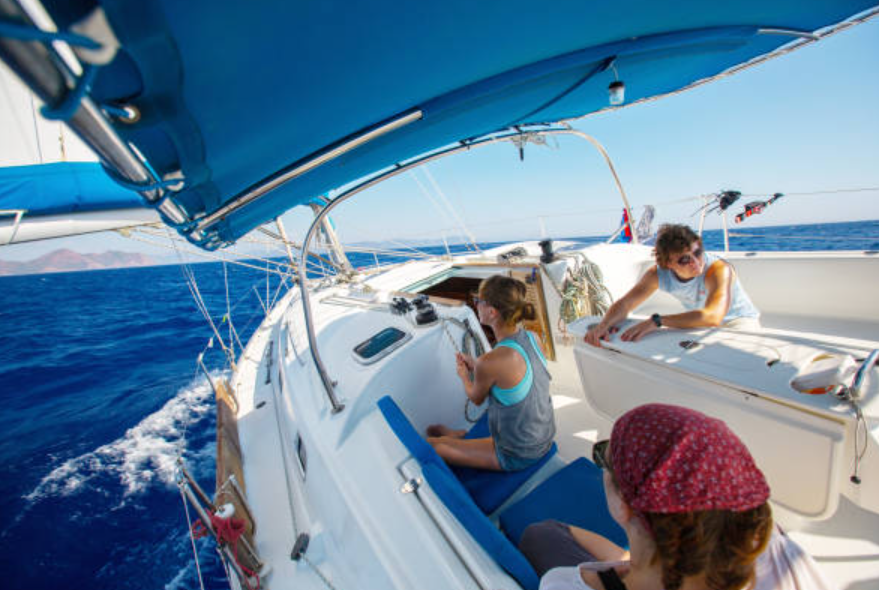
Ok, you want to set sail in your dreams, or maybe daydreamed about cruising crystal-clear waters on a sleek sailboat. Before you chart your course, you may want to explore the different types of sailboats and know its unique personalities and ideal uses.
By Hull Design
Monohulls
Think classic sailboats – these are the most common, offering stability and a variety of keel types. Imagine a deep keel slicing through waves, providing a smooth ride, or a shallow draft monohull skimming across shallow bays. These trusty vessels are the workhorses of the sea, offering stability that makes them a favorite among sailors. With various keel types to choose from, monohulls provide versatility for different sailing conditions. Whether you’re a seasoned sailor or just dipping your toes into the sailing world, monohulls are a reliable choice.
Catamarans
These boast two hulls, creating spacious decks and unmatched stability. Think luxurious floating apartments, perfect for island hopping or relaxing with friends. Catamarans are the spacious giants of the sea, offering a different kind of sailing experience. While they might be less maneuverable compared to monohulls, the extra room and stability make them perfect for leisurely cruises or entertaining your mates on board. Keep in mind, they’re not be as nimble as their single-hulled counterparts.
Trimarans
Craving speed and stability in rough waters? Trimarans have three hulls, slicing through waves effortlessly. They’re less common but perfect for adventurous sailors seeking exhilarating rides. Trimarans boast speed and stability, especially in choppy waters. Though less common, these three-hulled wonders are a sight to behold. If you’re seeking a vessel that can handle rough seas without sacrificing speed, a trimaran might just be your perfect match.
By Mast Configuration and Sails
The most popular choice, sloops have a single mast and are known for their simplicity and versatility. Whether you’re learning the ropes or racing across oceans, there’s a sloop rig for you. Simple, sleek, and ever-popular, the sloop is your go-to sailboat. With various rig types to suit your preference, it’s the ideal choice for those looking for an uncomplicated sailing experience.
Imagine two masts for double the sail area! Perfect for long-distance cruising, ketches handle winds well and offer generous storage space. Think self-sufficient adventures across distant horizons. Ketches provide more sail area for that long-distance adventure. With its two masts and ample sail configuration, it’s the go-to choice for sailors craving extended cruising. Imagine the wind in your sails as you gracefully navigate the open sea.
Schooners
See a classic scene with multiple masts rising majestically. Schooners, with their elegant design, perform particularly well in light winds and offer a unique sailing experience. Its timeless design shines, especially in light winds. If you fancy a nod to sailing’s rich history while enjoying a leisurely sail, the schooner is a top contender. Think historical charm meets modern comfort.
Beyond the basics: There’s a whole world of other mast configurations like catboats, yawls, and cutters, each with their own strengths and quirks. Explore further to find your perfect match!
Sailboats Types by Intended Use

Are you ready to set sail and navigate the open waters? Whether you’re a seasoned sailor or a novice eager to learn, understanding the different types of sailboats based on their intended use is a crucial first step. Let’s dive into the diverse world of sailboats and discover which one suits your sailing ambitions.
If you’re looking for a sailboat perfect for short excursions and skill-building, the daysailer is your go-to. Designed for ease of use, these boats are ideal for beginners and those who crave the simplicity of a quick day on the water. With straightforward rigging and a focus on maneuverability, daysailers make learning the ropes a breeze.
Cruising Sailboats
For the adventurers at heart, cruising sailboats are tailored for extended journeys and even living aboard. These boats offer a comfortable living space and ample storage, making them well-suited for those dreaming of exploring distant shores or embracing the liveaboard lifestyle. Set your sights on the horizon and let a cruising sailboat be your home on the water.
Racing Sailboats
Thrill-seekers and competitive spirits, look no further than racing sailboats. Crafted for speed and precision, these vessels are designed to slice through the water with agility. Join the excitement of regattas and harness the power of the wind as you compete against fellow sailors. Racing sailboats are the ultimate choice for those who crave the rush of the open sea and the thrill of competition.
Performance Cruisers
If you desire the best of both worlds – comfort and speed – a performance cruiser is your ticket to a balanced sailing experience. These sailboats combine the luxury of cruising vessels with the enhanced speed of racing boats. Experience the joy of sailing without compromising on comfort, making every journey an enjoyable and swift adventure.
Other Specialized Sailboats
Beyond the main categories, the world of sailboats offers a myriad of specialized vessels. Dinghies provide nimble handling, multihulls offer stability and speed, while classic boats exude timeless charm. Each has its unique features, catering to specific preferences and needs. Explore these options to find the sailboat that resonates with your sailing style.
Considerations in Type of Sailboats
You’re ready to explore the world under sail, but with an array of amazing sailboats out there, choosing the right one can feel like navigating a stormy sea itself. This guide will equip you with the knowledge to chart your course towards your ideal vessel.
Keel Configurations
Just like shoes, different keels suit different sailing styles. Here’s a quick rundown:
Fin keels: These deep, fixed fins slice through water efficiently, making them ideal for speed and long-distance cruising. Think stability and slicing through waves like a knife!
Wing keels: Imagine an airplane wing underwater. These thin, angled keels provide incredible stability and lift, perfect for choppy waters and sporty sailing. Hold on tight, these can get exciting!
Daggerboards and centerboards: These retractable keels allow you to explore shallow waters. Think playgrounds for exploring hidden coves and navigating tight spaces. Just remember to raise them before hitting deeper waters!
Size & Capacity
Imagine trying on clothes – a sailboat that’s too big can be overwhelming, while one that’s too small feels cramped. Here’s how to find your perfect fit:
Crew size: How many shipmates are joining your adventure? A cozy sailboat for two won’t cut it for a family of five. Remember, comfort matters!
Sailing goals: Weekend getaways or epic voyages? Daytime cruises or stargazing under the open sky? Matching your needs with the boat’s capabilities ensures smooth sailing (and sleeping! ).
Sailing Experience
Not everyone starts as a seasoned sail. Here’s how to choose a boat that matches your experience level:
Beginner’s bliss: Stable boats with simple rigs, like centerboard dinghies or small keelboats, are your training wheels. Think ease of handling and learning the ropes with confidence.
Intermediate island-hopper: Ready to graduate? Mid-sized keelboats with more complex sail plans offer exciting challenges and comfortable explorations. Think weekend adventures with a touch of spice.
Seasoned sailor: The sky’s the limit! From high-performance racing yachts to luxurious cruising vessels, the world is your oyster. Remember, experience and budget go hand-in-hand.
Choosing Your Right Sailboat
Now that you’ve got the basics down, it’s time to set sail on your research journey!
What’s your needs: Reflect on your experience, intended use, budget, and crew size. This forms your map.
Match your preferences: Explore different boat types and their characteristics. Think speed demons, cozy cruisers, or adventurous explorers. Find your match!
Research and choose: Dive deeper into specific models, read reviews, and compare features. This is where you fine-tune your course.
With this guide and a little research, you’ll be well on your way to setting sail on the perfect boat for your unique sailing adventure. Remember, the journey is just as exciting as the destination, so enjoy the exploration!
Embark on your sailing journey with a clear understanding of the diverse types of sailboats based on their intended use. Whether you’re seeking a leisurely day on the water, planning an extended cruise, craving the thrill of competition, or desiring a balanced experience, there’s a sailboat waiting to hoist its sails for you.
This is just a taste of the diverse world of sailboats. So, set sail and discover the type that speaks to your inner mariner. Happy sailing!
Leave a Reply Cancel reply
Your email address will not be published. Required fields are marked *
Save my name, email, and website in this browser for the next time I comment.

My Cruiser Life Magazine
Sailboat Types: Full-Guide
For generations, sailing has been a mode of essential transportation, a rewarding hobby, an active and competitive sport, and a lifestyle. Sailing appeals to all, and there are dozens and dozens of types of sailboats.
Small sailboats are perfect for kids to sail on, and massive sailboats are used to cross oceans in style. In between, there are daysailers, racers, and cruisers.
Table of Contents
- What Does a Sailboat Look Like?
Small Sailboats
Cruising boats, cruising catamarans, cruising trimarans, full keel boats, fin keel boats, centerboard keel.
- Hydrofoil Sailboats
A Purpose for Every Type of Sailboat
Faqs (frequently asked questions).
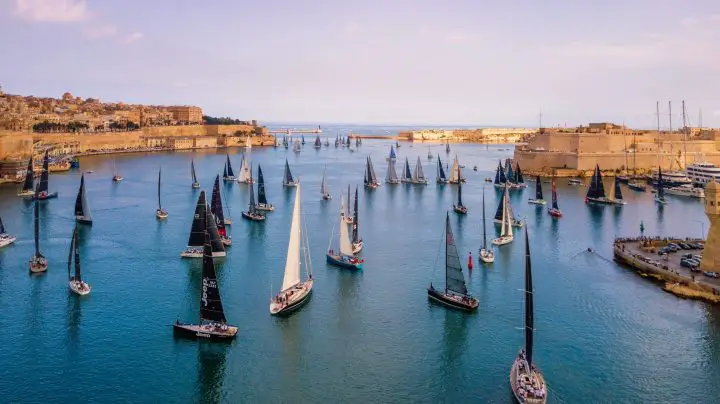
What Are Sailboat Types?
Sailboats are boats that are propelled by the wind. Sailboats use wind power instead of a motor or oars to move the boat. It should be noted, though, that nearly all modern sailboats have a motor as well. It comes in handy when docking in tight marinas and if the wind dies!
A sailboat has one, two, or three hulls. It has at least one mast, or tall vertical spar, that holds up one or more sails. The sails harness the power of the wind to move the boat forward.
To get started, here are some sailing boat types and terms to give you an idea of the sorts of boats that are out there.
- Dinghies — a small open boat, usually for only one or two people
- Daysailors — boats designed to go out for a day trip
- Cruising Sailboats — boats designed to travel long distances that have accommodations for their crew to live aboard a long term
- Sloop — the most common type of sailboat, with one mast and two sails (a jib and a mainsail)
- Ketch, yawl, or schooner — types of sailboats with two or more masts
- Monohull — a boat with only one hull
- Catamaran — a boat with two equal-sized hulls in the water that are connected together by a bridge deck
- Trimaran — a boat with three hulls in the water, the center of which is much larger than the outer two
What Does a Sailboat Look Like?
There are many different types of sailboats, so they look a little different from each other. The basics, however, are the same.
Each sailboat has at least one hull that sits in the water. Part of the hull is visible above the waterline. Part of the sailboat hull sits below the waterline.
The part beneath the waterline might be relatively small, or it can be quite large. The rudder, the mechanism used to steer the boat, is also underwater.
The cockpit is where the helmsperson sits and steers the boat. On small boats, the cockpit takes up the entire boat. Cruising boats have interior accommodations as well as a safe cockpit.
Sailboats have at least one mast and at least one mainsail. As you get to know the different types of sailboats, you’ll see many different hull and sail configurations.
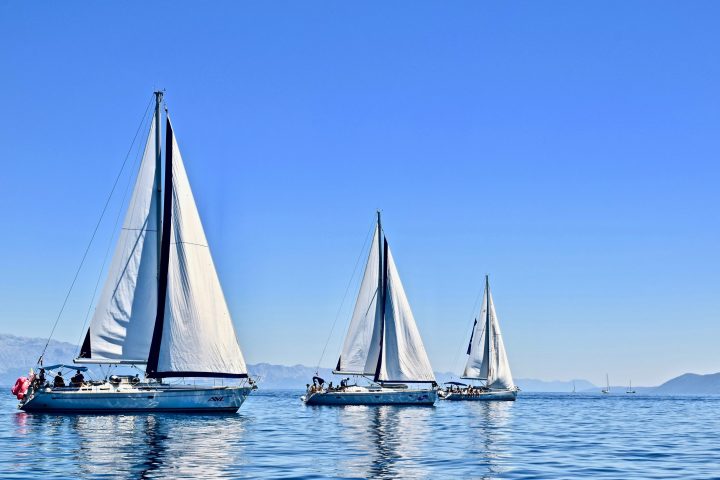
Different Types of Sail Boats
Sailboats come in all types of sailboat shapes and sailboat sizes . Sailboats can be classified by their hull shape, size, or sail plan. The sail plan is how many sails they carry on how many masts.
Hull shapes include monohulls, catamarans, trimarans, and sailing hydrofoils. A monohull has just one hull, a catamaran has two hulls, a trimaran has three hulls, and a hydrofoil lifts out of the water.
Sizes range from eight-foot sailboats to megayachts that are hundreds of feet long. Some sailboats are so small they are only suitable for one child who wants to go skimming across the lake. The largest pure sailing yacht in the world is the Black Pearl at 350 feet long (106.7 meters) long. Visit our Yacht vs Sailboat guide for a more definitive difference between the two and their sizes.
Sailboats also have different sail configurations or sail plans. For example, a sailboat with just one big sail on a forward-mounted mast is called a catboat. A boat with dozens of different sails on three masts is called a three-mast schooner.
Small sailboats are extremely popular and offer a lot of fun to the young and old. Most of the time, these boats are just used for daytime use in pleasant weather conditions. Kids often learn to sail in small monohull sailboats. Families might go for a picnic in a Hobie catamaran.
Yacht club members might race their 16-foot daysailors, while adventurous souls might take their 19-ft weekender and anchor in a calm cove for the weekend.
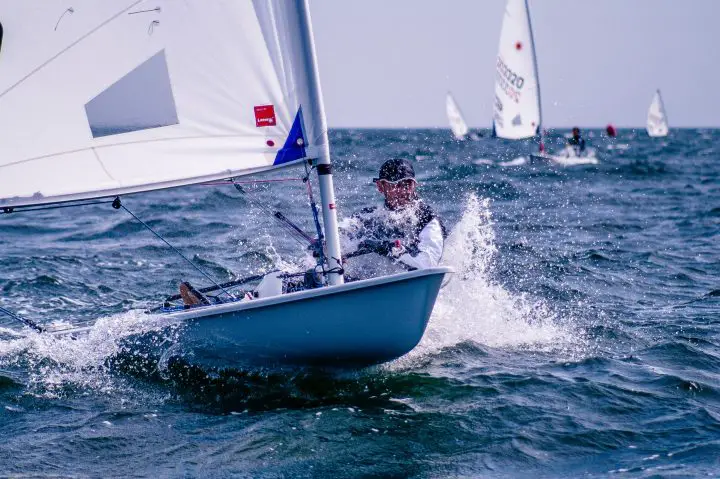
What is a Small Sailboat Called?
Small sailboats have different names, depending on the type of sailboat and the number of sail boat hulls. For example, the boat might be a monohull dinghy, small catboat, small catamaran, or daysailor.
Additionally, like every car on the road, every boat on the water is identified by its make and model. In small boats that are commonly raced, a certain make and model may set up a class of racing boats. Class racing means that all of the boats are identical, so the race is based solely on the skills of the skippers.
Sailing Dinghies
Kids and adults often learn to sail on sailing dinghies. Sailing dinghies can be as small as eight feet long. This small size makes it easy for kids to handle.
Some common sailing dinghies are Optis, Lasers, and Sunfish.
This size sailboat is also functional. They can be used to ferry sailors from their larger anchored boats to shore. The small size also helps sailors easily store their dinghy on larger boats. The word dinghy is often used to refer to any small boat used as a tender for a larger vessel, even if the tender is a motorboat.
Cat Rig Boats
A cat rig boat, or cat boat, is a type of sailboat that usually just has one large mainsail and a forward-mounted mast. Many smaller dinghies and training boats are catboats. A catboat has a free-standing mast with no standing rigging.
Small Catamarans
A catamaran is a boat with two hulls. The Hobie brand is synonymous with small catamarans, which are popular with families looking for a fun hobby. Hobie Cats are seen on the sand at beach resorts all over the world—they’re safe, fun, and fast.
Catamarans are faster than monohulls, and these boats are fun to race. Small catamarans are often used by families that live on the waterfront. Their lightweight makes them easy to drag to the waterfront and launch.
Small catamarans are also popular on beaches. Many beach resorts offer Hobie cats for rent. Small catamarans are between 12-20 feet in length. The hulls are joined only with spars and netting, so these fast and light open boats are not set up to carry a lot of people or supplies.
Daysailors are the ultimate fun boat. As the name implies, this type of sailing boat is used for day sailing. These boats are usually between 12 to 20 feet long. Some use these smaller boats for racing or overnight camping, but most sailors use daysailors for a leisurely sail.
Small Sailboats with Cabins
While most small sailboats just have a large open cockpit, several small yacht types have cabins. These cabins offer a chance for sailors to use a porta-potty or get out of the sun. Some small sailboats even have sleeping accommodations for overnight stays.
An excellent example of this is the Cape Dory Typhoon Weekender. This small sailboat is known as “America’s Littlest Yacht.” Down below, there are two small bunks for sleeping and enough space to have a small stove and a porta-potty. Most owners don’t stay aboard long-term, but the cabin is a useful place to stow items while sailing or to hide during a rainstorm.
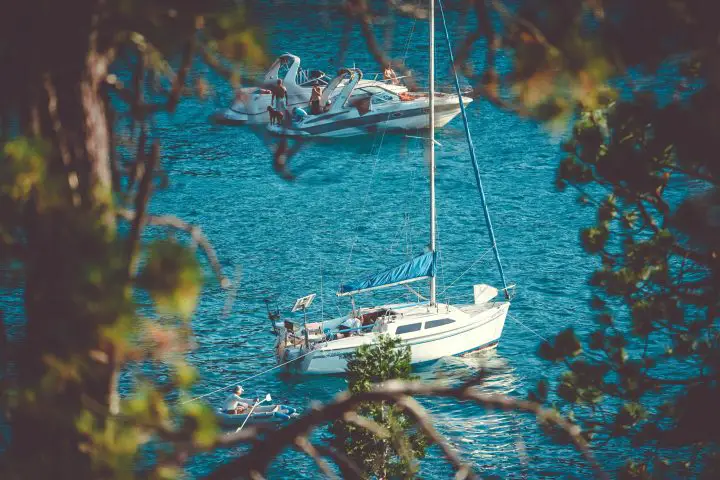
Cruising boats are boats that are capable of traveling long distances. Cruising boats have sleeping accommodations, cooking facilities, and bathroom facilities. These boats are like RVs for the waterway.
Cruising boats offer sailors the chance to live on their boats while sailing. Like RVs, cruising sailboats travel to different ports of call. Cruising sailboats are one of the more popular types of sailing boat. They offer adventurous sailors the chance to enjoy sailing as a sport while seeing new things.
Cruising boats are usually 30 to 50 feet long. Most cruising couples prefer a boat that is around 40 feet long since this provides enough space to live comfortably and enough storage space for all of their gear.
Monohulls are very popular cruising boats. These boats offer good storage, are safe, and are easy for a couple to handle together. Monohulls have different types of sail configurations.
Cruising Bermuda Rigged Sloops
Most monohulls are Bermuda rig sloops. This sail plan features one mast with a mainsail and a headsail. Bermuda rig sloops are easy to single-hand and very versatile. How many sails does a sloop have? A Bermuda sloop flies two sails at a time, which are the mainsail and a headsail.
However, the boat might have other sails onboard. For example, the captain might take down the jib in light winds and use a bigger genoa to capture more wind power. During a downwind sail with light winds, the captain might rig a large spinnaker, which looks like a huge kite, to keep sailing even in little wind.
Even within the sloop category, there are many variations in the design. A masthead sloop is one whose forestay (headsail) goes all the way to the top of the mast. In contrast, a fractional sloop’s forestay connects at some point lower. So a 3/4 fractional rig has a headsail that only goes up three-quarters of the way to the top.
Riggers and boat designers have a lot of tools in their toolbox from which they can make a boat faster or more user-friendly. The type of rigging and sail plan a boat is equipped with offers it performance improvements as well as functionality.
Cruising Cutter
A cutter is a sailboat with one mast, one mainsail, and two sails forward of the mast. The sail at the front of the boat is the jib, genoa, or yankee depending on its size and cut. The next sail in, the inner headsail, is called the staysail. Island Packets are popular boats with this sail plan.
Cutters are popular choices as cruising and bluewater cruiser boats because the staysail provides the skipper with many different sail options. They could fly all three sails fully, or they could fly a small partial mainsail and just the staysail for heavy winds.
Cruising Ketch With Mizzen Sail
Some cruising monohulls are ketches. A ketch can be easily identified by its two masts. The forward mast is the main mast with a mainsail. The aft mizzen mast is shorter and has a mizzen sail. This sail plan can make it easier to carry a big sail area and configure the sails for various sailing conditions.
A boat with more than one mast is called a split rig because the rig is split between two shorter masts instead of all mounted on one tall one. The advantage of a split rig is that there are more sails, each of which is smaller. That makes them easier to handle, and important consideration when you are sailing alone or with only one other person.
Cruising Yawl
A yawl is similar to a ketch and has two masts. However, the mizzen mast on a yawl is aft of the rudder post, whereas it is forward of the rudder post on a ketch. This mizzen mast location is even further back than a ketch’s. Yawls are one of the less popular types of sailboats. However, like the ketch, they offer diverse sail options and can keep sailing in many different types of weather.
On both ketches and yawls, the mizzen mast is shorter than the main mast. If the two masts are of equal height, or the forward mast is shorter, then you are looking at a schooner.
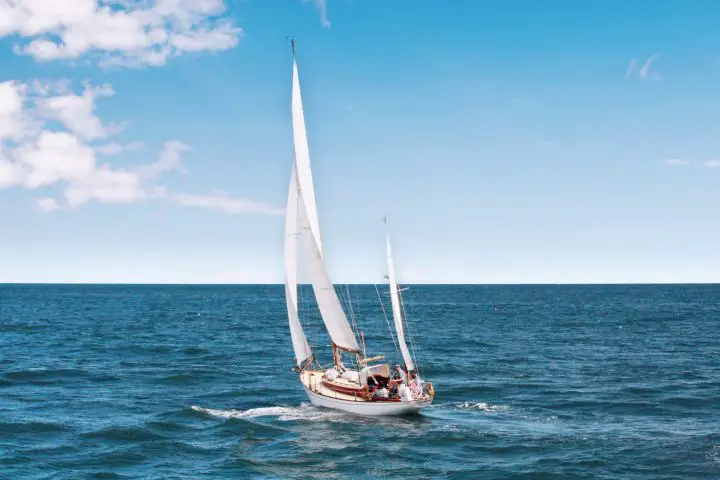
Cruising catamarans are one of the most popular classes of sailboats right now. This type of sailing boat has two hulls and offers sailors speed, space, and comfort. A cruising catamaran is usually between 40 and 60 feet long and 20 to 30 feet wide. The additional width offers cruise sailors huge amounts of space.
Cruising catamarans have excellent storage space and ample living accommodations if you intend to living on a boat . These boats are popular with couples and families and are often used to sail around the world on circumnavigations.
Cruising catamarans are usually fractional sloop rigs. They have one mast, a large mainsail, and a jib or genoa. In general, these boats are designed to be easy to sail and minimize complications.
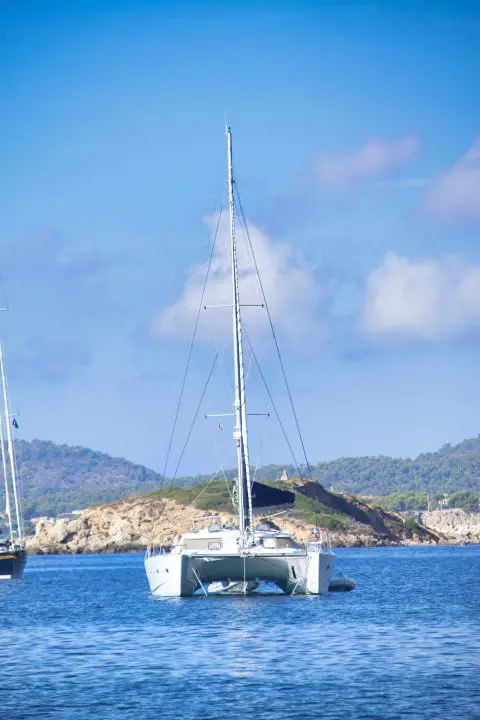
Trimarans are a type of sailboat with three hulls. Trimarans are known to be fast and are popular with racing sailors. However, they are also gaining popularity as cruising boats. These boats usually have fewer accommodations than cruising monohulls and catamarans. However, more modern trimarans like the Neel Trimaran have luxurious living spaces.
Types of Keel
Another way to classify the different types of sailing boats is by looking at the boat’s keel type. You can easily get an idea of different keel designs by walking around a boatyard. When a sailboat is in the water, it is hard to tell the shape of its keel.
The keel is the bottom part of the hull and is underwater. The keel is structurally essential. The keel’s weight helps the boat sail evenly and uprightly. The force created by the water moving over the keel counteracts the effects of the wind on the sails.
So a keel does two jobs for a sailboat. First, it provides a force that allows a sailboat to sail into the wind. Second, it provides stability. If storm-force weather conditions cause a monohull boat to roll, the weight in the keel will help the boat right itself.
Many older cruising boats had full keels. The keel shape runs the entire length of the boat. A full-keel boat is strong and easy to manufacture. Full-keel boats often have deeper drafts. The boat’s draft refers to the amount of water it needs to float. Full-keel boats can’t go into the shallow anchorages that catamarans or swing-keel boats can access.
Captains often report that full-keel boats are harder to maneuver in tight places such as marinas. Full-keel boats lack quick maneuverability. They have a reputation for being slower than more modern designs, but they make up for this by providing a very comfortable and safe ride in rough weather.
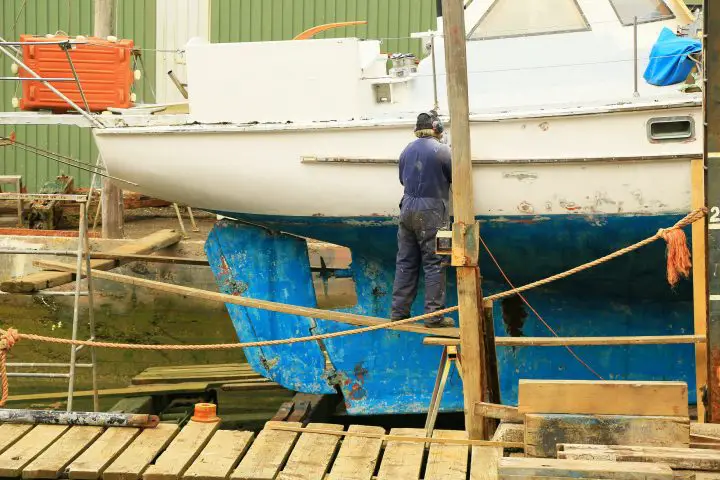
A boat with a fin keel has a smaller underwater profile than a boat with a full keel. This smaller keel resembles a fish fin. Captains find fin keel boats easier to maneuver. Fin keels use their shape to create very effective forces underwater. That makes them very good at countering the forces on the sails, meaning that fin keels sail upwind very well.
A boat with a bulb keel has a torpedo-shaped bulb on the bottom of a fin keel. Bulb keels offer improved stability. Bulb keels have shallower keels than a fin keel boat. The bulb also lowers the center of gravity in the boat, making it more stable overall.
A wing keel features a keel with a small wing on either side of the keel. Viewed from above, the keel looks like it has a set of small airplane wings.
Similar to a bulb keel, wing keel boats often have a shallower draft than fin-keel boats. However, the additional shape causes drag and can reduce sailing performance in some circumstances.
A centerboard is common on small daysailors that are launched and retrieved from trailers. Deep keels make getting those boats in and out of the water difficult. By chopping off the keel, you can make a sailboat as easy to launch as a powerboat.
Related: Best Trailerable Sailboats
But of course, a sailboat needs to have a keel. A centerboard is a simple swinging fin keel that can be raised or lowered. This provides some excellent benefits if the sailor on board likes to explore areas with shallow water.
Many bigger boats have centerboards, too. A boat with a centerboard can be seen as the best of both worlds. A centerboard boat has a fixed shallow draft keel. However, the captain can deploy the centerboard when sailing in deeper waters. The centerboard adds depth to the keel and offers increased stability and performance.
A modification of the centerboard is the swing keel — a ballasted keel that can be retracted like a centerboard . These are rare. They’re used on large cruising boats where the crews want the option of accessing shallow waters. In England, this type of boat is used and can be dried out when the tide goes out.
Racing Sailboats
Yacht racing is a popular sailing sport. It’s a great way to get out on the water while competing. In fact, racing is a great way for sailors to hone their sailing skills. Sailors have to pay close attention to weather conditions and manage their sails effectively to maximize their speed.
Sailors can race any boat with sails. Kids race sailing dinghies against each other. Club racers sail daysailors or catboats. Catamarans and trimarans are also popular race boats. Several classes of boat races in the Summer Olympics.
Hydrofoil Sailboats
A hydrofoil is a unique and modern type of racing sailboat. A hydrofoil can be a monohull, catamaran, or trimaran. A hydrofoil has wing-like foils on the hull’s underside.
As the sailboat speeds up, the hydrofoils lift the hull out of the water, and the hydrofoil sailboat almost appears to be flying above the water.
Because the hull is now out of the water, drag, and resistance are minimal, and the sailboat can sail even faster. For example, a dinghy that usually goes four knots can accelerate to 12 knots when fitted with a hydrofoil.
Most hydrofoil sailboats are catamarans and trimarans. The added width of these multihull sailboats gives the hydrofoil sailboat more stability.
Traditional Sailboats
Traditional sailboats are the type of sailboats used to transport people and goods before modern transportation options were available. Before the railway, cars, and airplanes, a tall ship sailboat was used to ship cargo and people across oceans and from port to port.
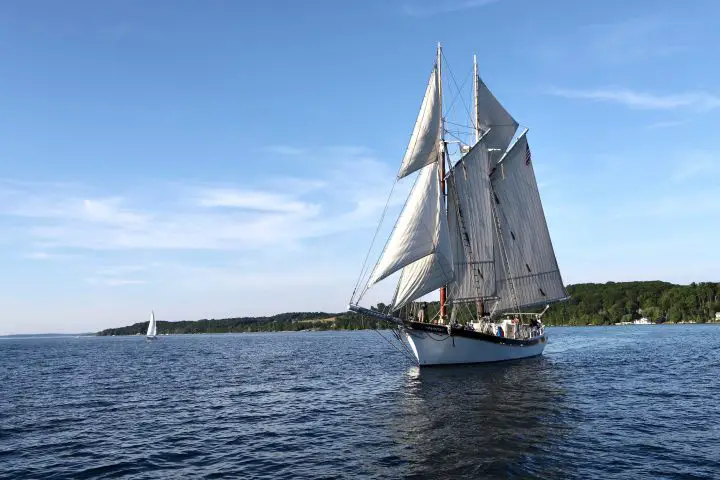
A gaff rig refers to the gaff, which is the upper spar on a square-shaped sail. Gaff rigs can be used with any mast configuration, but this feature is usually seen on traditional boats like a catboat, tall ship, or schooner.
A schooner has at least two masts. They are different from other mast configuration designs with two spars in that both masts are equal in height, or the forward mast is shorter. Schooners are faster than most traditional boats and were often used to transport perishable goods such as fruit.
Schooners were also popular race boats in the early 20th century. For example, first America’s Cup races were won by schooners.
Today, schooners are usually used as charters for vacations or youth sail training programs. But there are a few cruising boats out there that feature schooner rigs.
Any way you divvy it up, there are tons of different types of sailboats out there. With a little research and a little looking, you’re sure to find one that suits your style and boating plans.
What are the classes of sailboats?
Sailboat styles can be classified by hull type, use, or sail plan. The types of sailboat hulls include monohulls, catamarans, and trimarans. You can also categorize the kinds of sailboats by their use. For example, sailors use their boats for daysailing, cruising, and racing. Finally, different kinds of sailboats have different sail plans. A sailboat might be a sloop, ketch, yawl, catboat, or schooner. The term “classes” has a particular meaning in sailing, however. Class racing is the competitive racing between boats of the same make and model—boats of the same “class” or of “one design.” There are hundreds of different classes of sailboats out there. Some of the most popular classes include the Laser and Sunfish classes.
What is a small 2 person sailboat called?
A small two-person sailboat is a dinghy. These small boats are fun to sail on protected waters. Many kids learn to sail in a sailing dinghy. There are dozens of makes and models of sailing dinghies available, some are used in Olympic sailing racing while others are just rowboats with sail rigs attached.
Matt has been boating around Florida for over 25 years in everything from small powerboats to large cruising catamarans. He currently lives aboard a 38-foot Cabo Rico sailboat with his wife Lucy and adventure dog Chelsea. Together, they cruise between winters in The Bahamas and summers in the Chesapeake Bay.
Leave a comment
Your email address will not be published. Required fields are marked *
Save my name, email, and website in this browser for the next time I comment.
- BOAT OF THE YEAR
- Newsletters
- Sailboat Reviews
- Boating Safety
- Sails and Rigging
- Maintenance
- Sailing Totem
- Sailor & Galley
- Living Aboard
- Destinations
- Gear & Electronics
- Charter Resources
- Ultimate Boating Giveaway

40 Best Sailboats
- By Cruising World Editors
- Updated: May 24, 2024
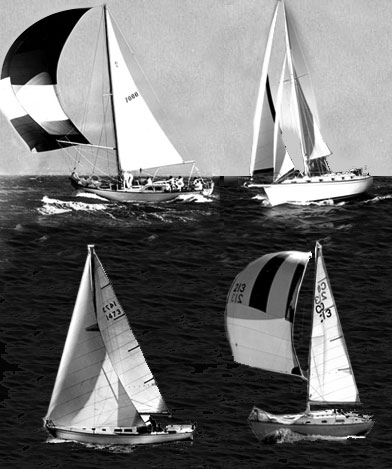
Sailors are certainly passionate about their boats, and if you doubt that bold statement, try posting an article dubbed “ 40 Best Sailboats ” and see what happens.
Barely had the list gone live, when one reader responded, “Where do I begin? So many glaring omissions!” Like scores of others, he listed a number of sailboats and brands that we were too stupid to think of, but unlike some, he did sign off on a somewhat upbeat note: “If it weren’t for the presence of the Bermuda 40 in Cruising World’s list, I wouldn’t even have bothered to vote.”
By vote, he means that he, like hundreds of other readers, took the time to click through to an accompanying page where we asked you to help us reshuffle our alphabetical listing of noteworthy production sailboats so that we could rank them instead by popularity. So we ask you to keep in mind that this list of the best sailboats was created by our readers.
The quest to building this list all began with such a simple question, one that’s probably been posed at one time or another in any bar where sailors meet to raise a glass or two: If you had to pick, what’re the best sailboats ever built?
In no time, a dozen or more from a variety of sailboat manufacturers were on the table and the debate was on. And so, having fun with it, we decided to put the same question to a handful of CW ‘s friends: writers and sailors and designers and builders whose opinions we value. Their favorites poured in and soon an inkling of a list began to take shape. To corral things a bit and avoid going all the way back to Joshua Slocum and his venerable Spray —Hell, to Noah and his infamous Ark —we decided to focus our concentration on production monohull sailboats, which literally opened up the sport to anyone who wanted to get out on the water. And since CW is on the verge or turning 40, we decided that would be a nice round number at which to draw the line and usher in our coming ruby anniversary.
If you enjoy scrolling through this list, which includes all types of sailboats, then perhaps you would also be interested in browsing our list of the Best Cruising Sailboats . Check it out and, of course, feel free to add your favorite boat, too. Here at Cruising World , we like nothing better than talking about boats, and it turns out, so do you.
– LEARN THE NAVIGATION RULES – Know the “Rules of the Road” that govern all boat traffic. Be courteous and never assume other boaters can see you. Safety Tip Provided by the U.S. Coast Guard
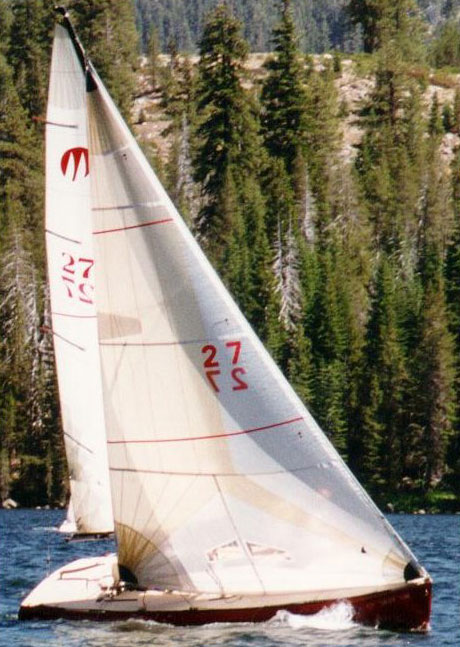
40. Moore 24
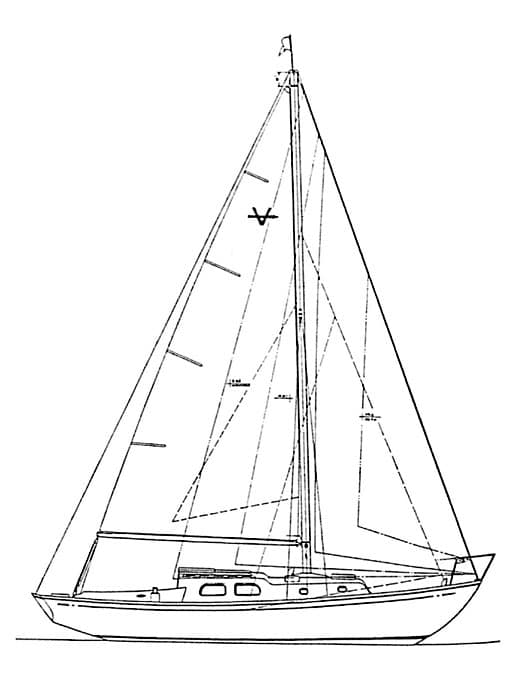
39. Pearson Vanguard
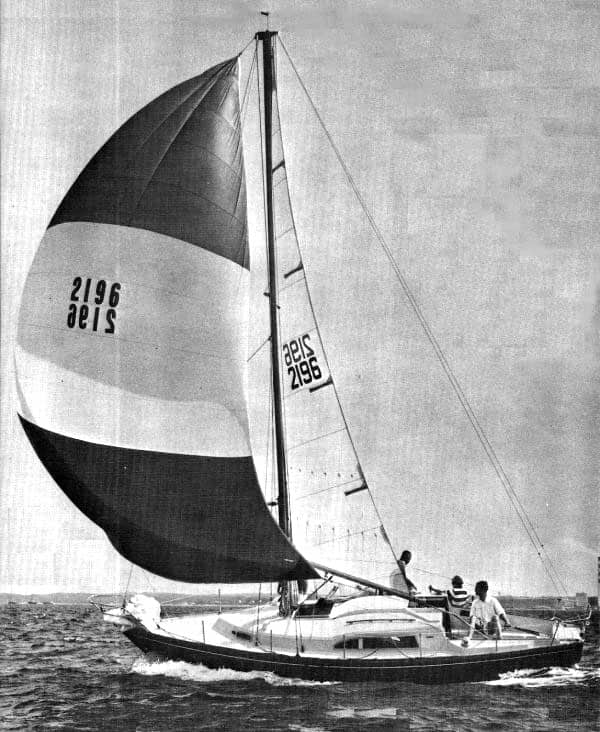
38. Dufour Arpege 30
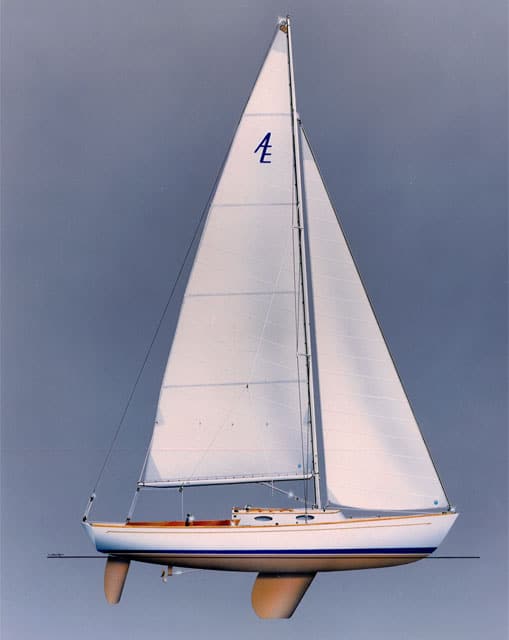
37. Alerion Express 28
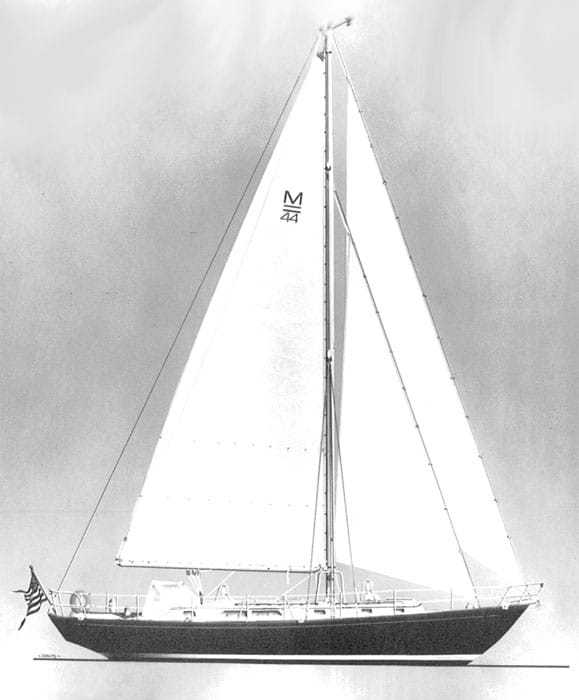
36. Mason 43/44
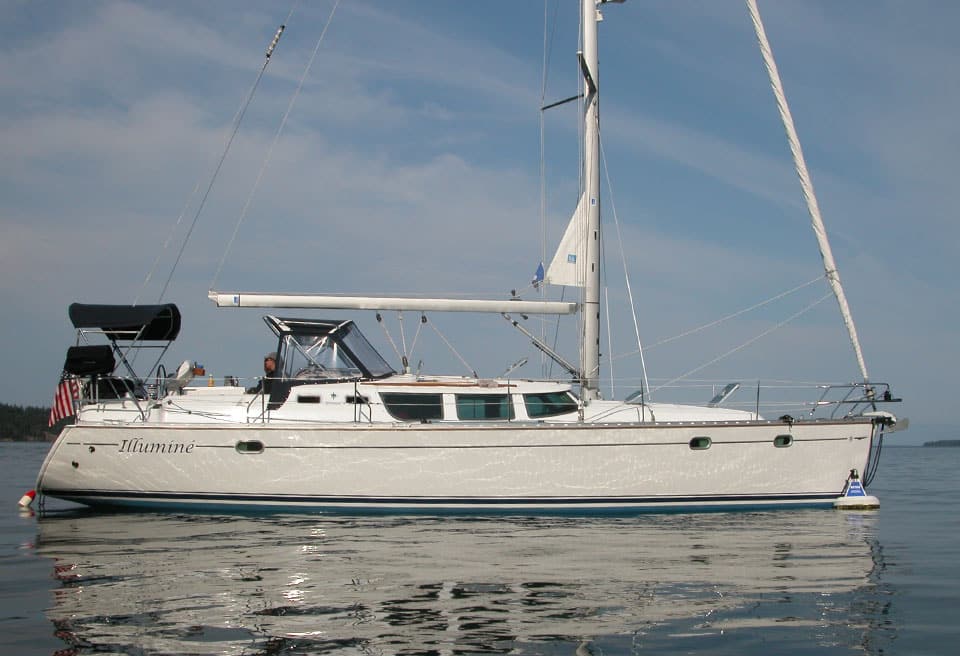
35. Jeanneau Sun Odyssey 43DS
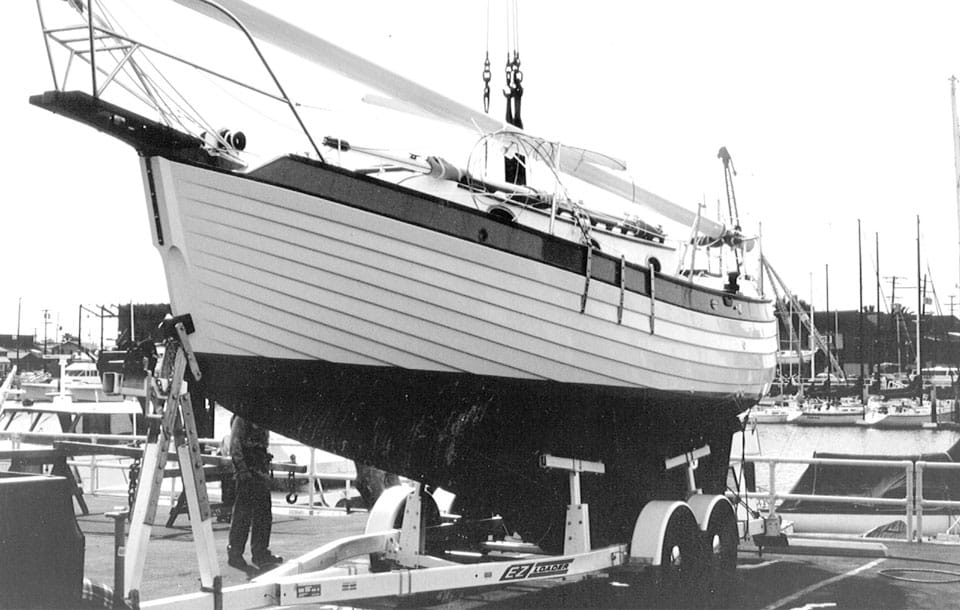
34. Nor’Sea 27
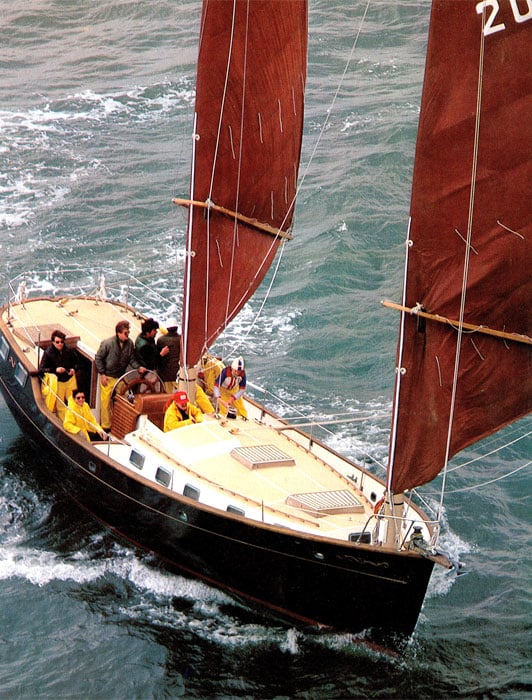
33. Freedom 40
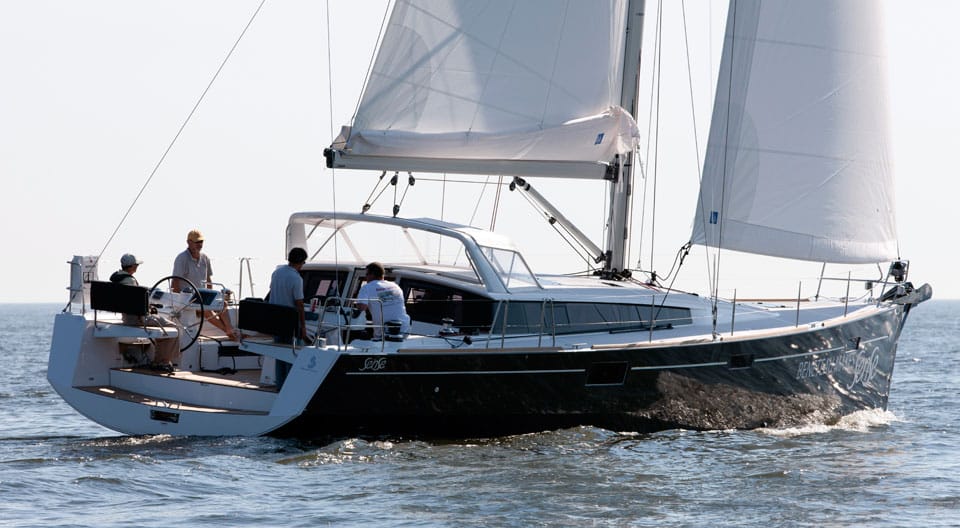
32. Beneteau Sense 50
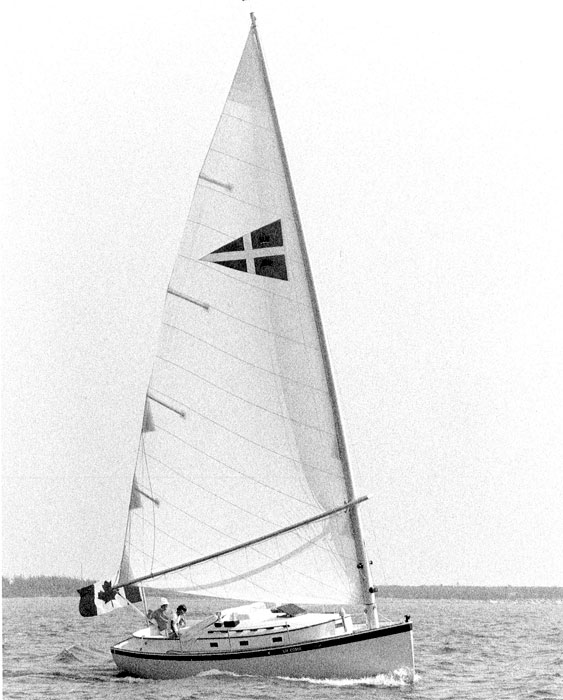
31. Nonsuch 30
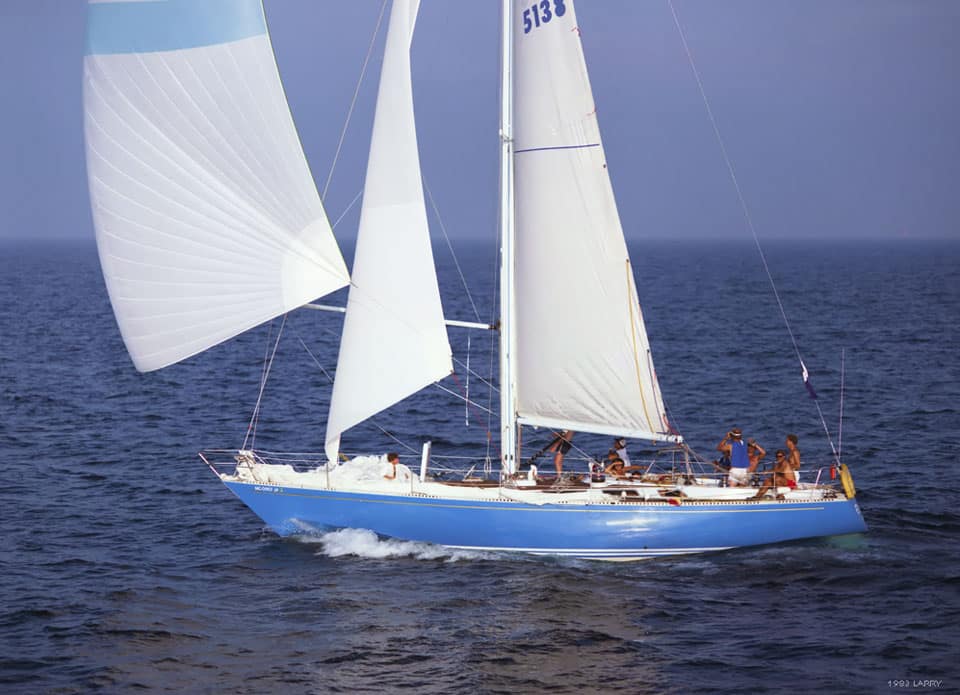
30. Swan 44
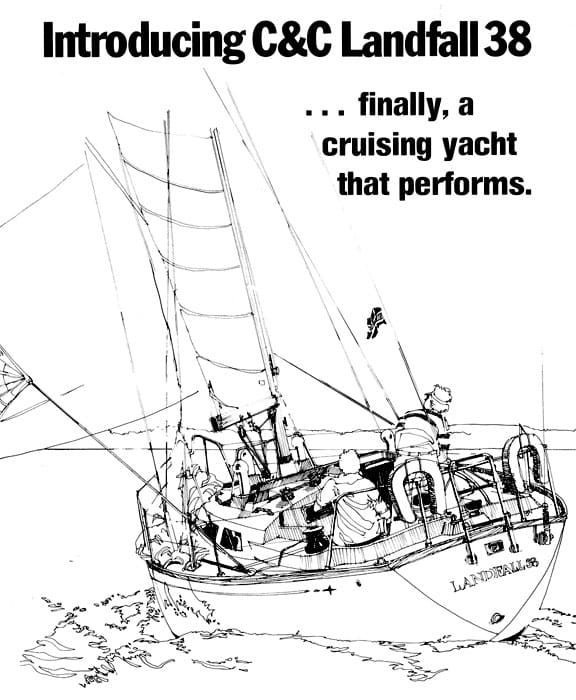
29. C&C Landfall 38
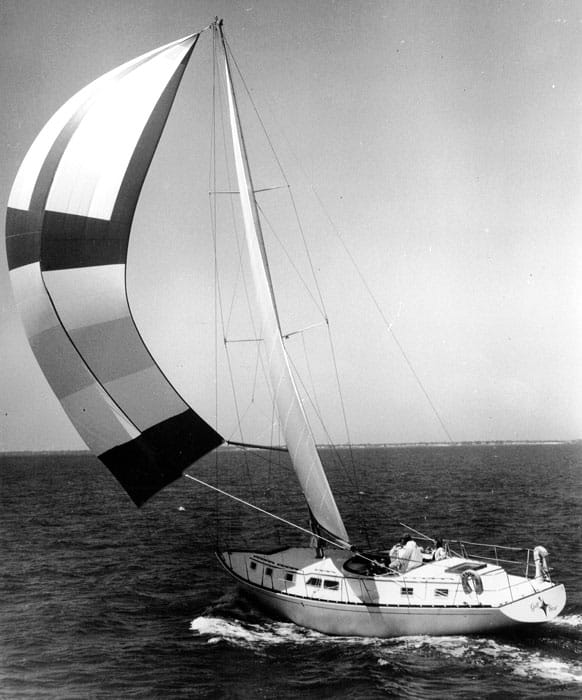
28. Gulfstar 50
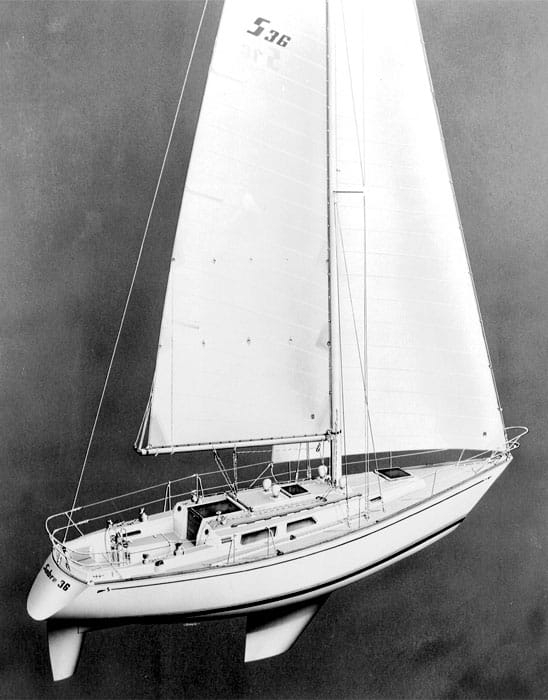
27. Sabre 36
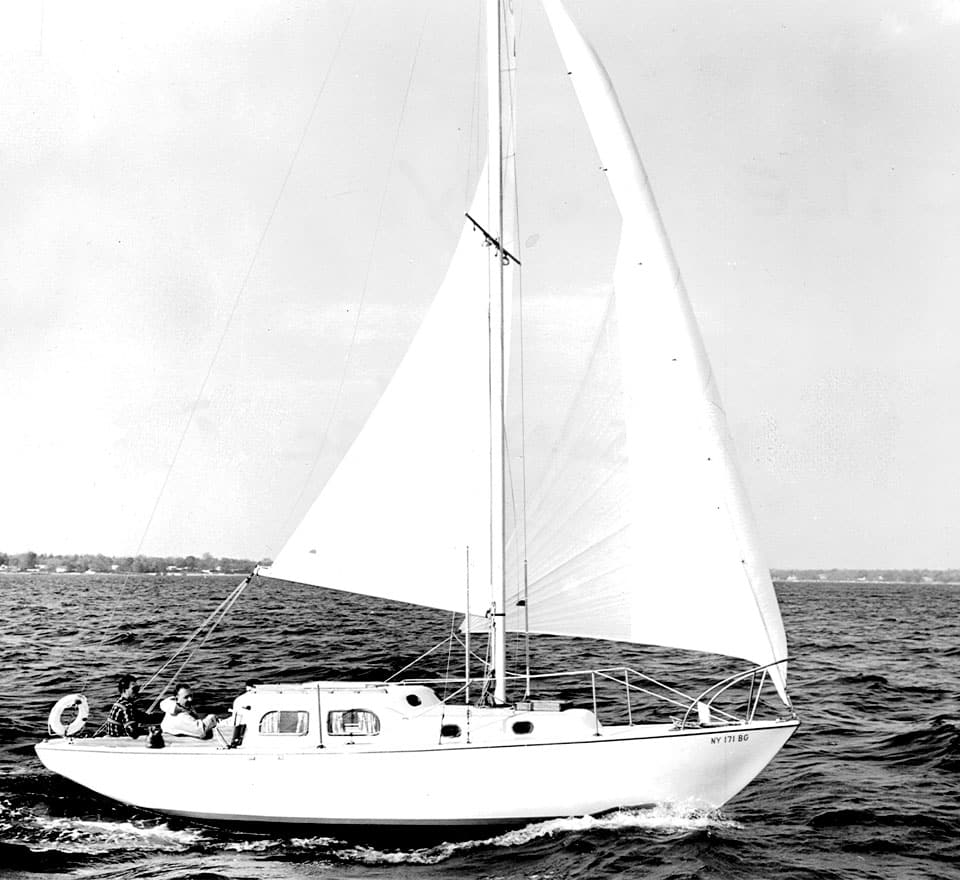
26. Pearson Triton
– CHECK THE FIT – Follow these guidelines to make sure your life jacket looks good, stays comfortable and works when you need it. Safety Tip Provided by the U.S. Coast Guard
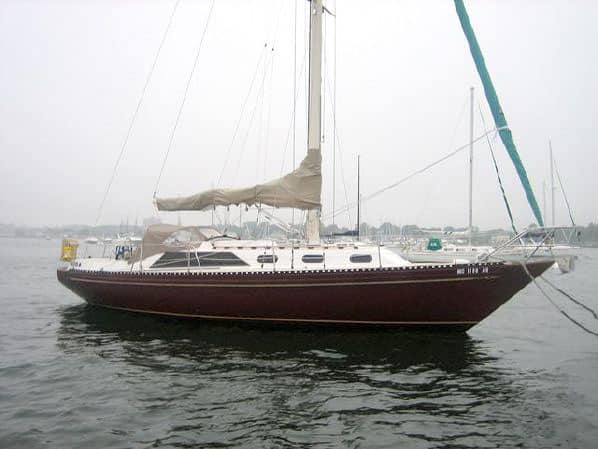
25. Islander 36
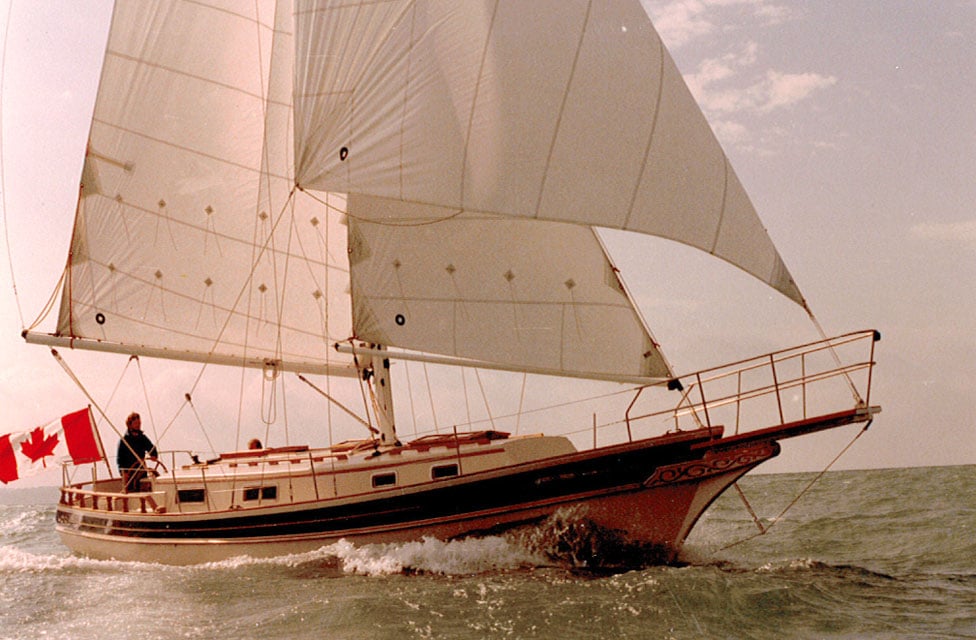
24. Gozzard 36
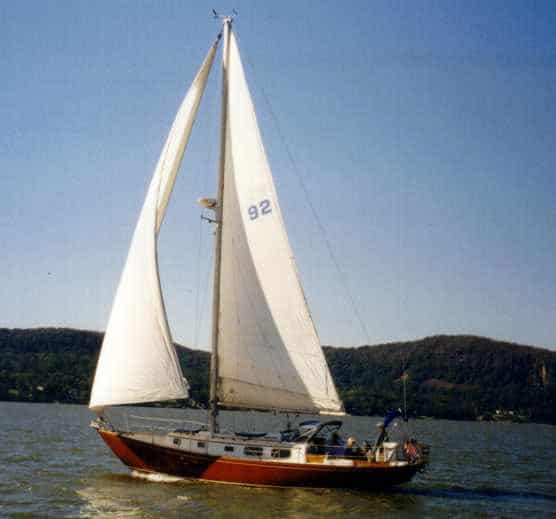
23. Bristol 40
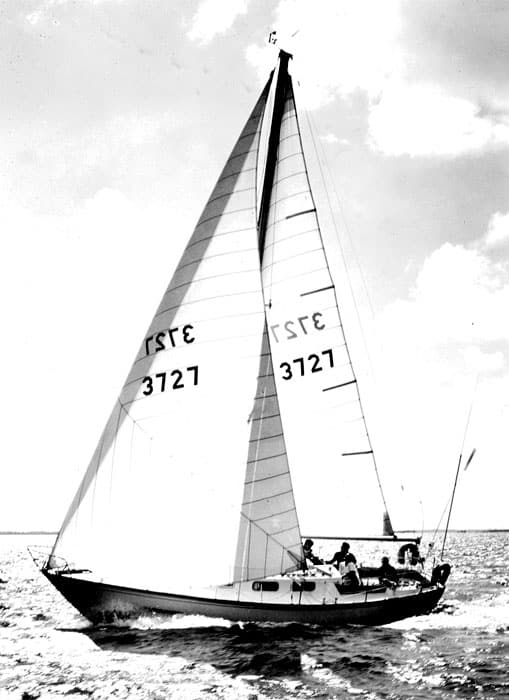
22. Tartan 34
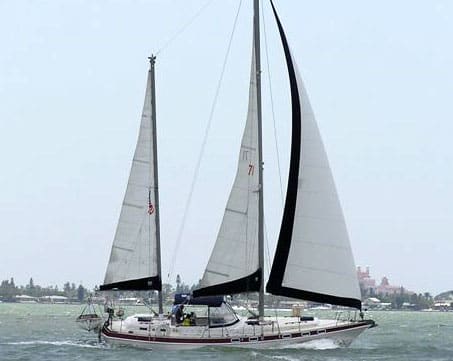
21. Morgan Out Island 41
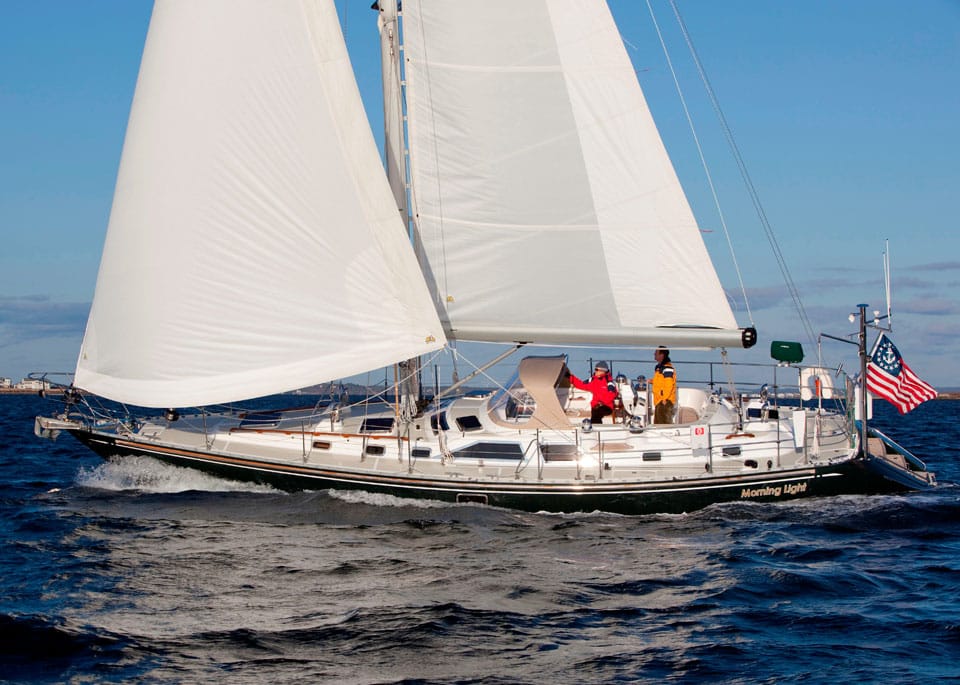
20. Hylas 49
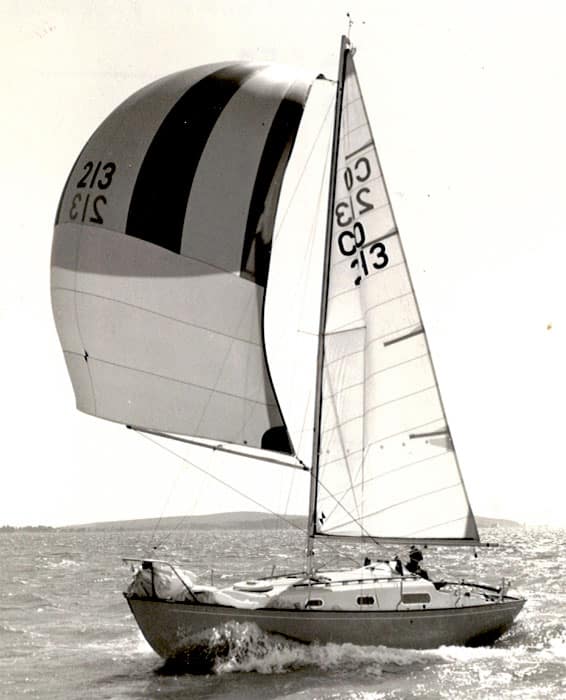
19. Contessa 26
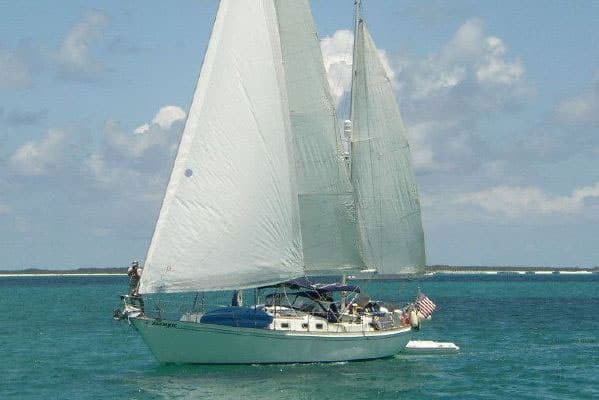
18. Whitby 42
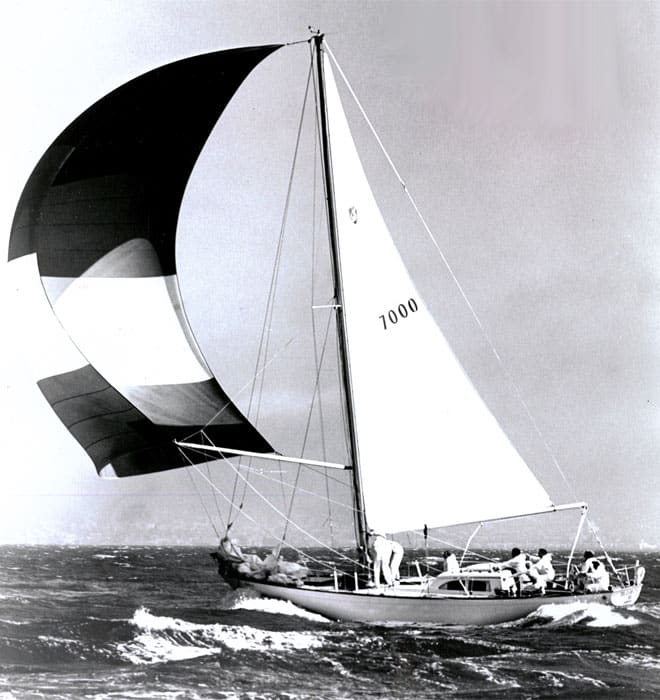
17. Columbia 50
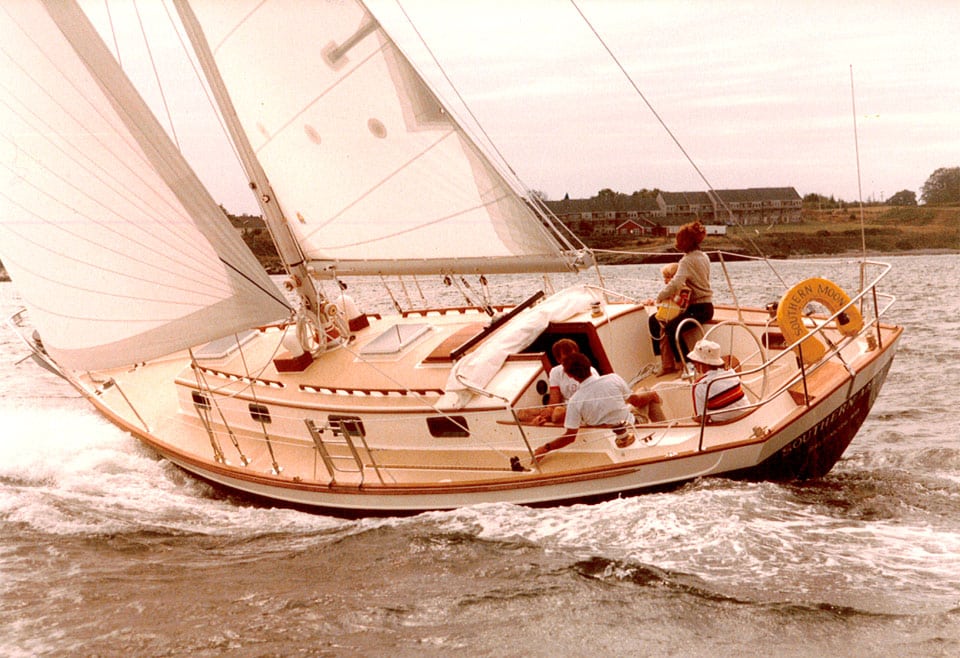
16. Morris 36
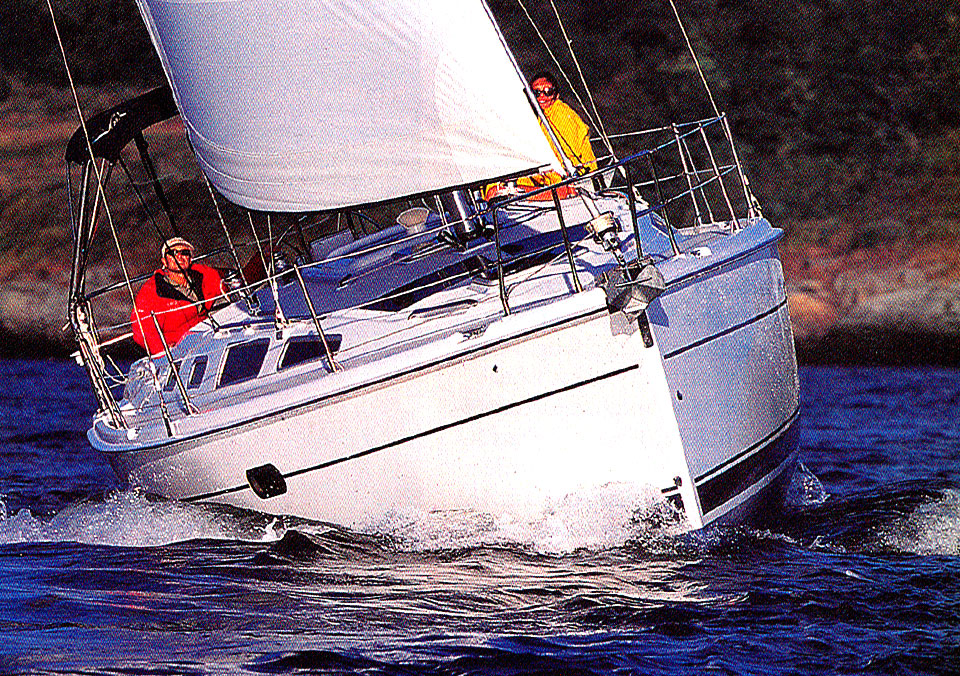
15. Hunter 356
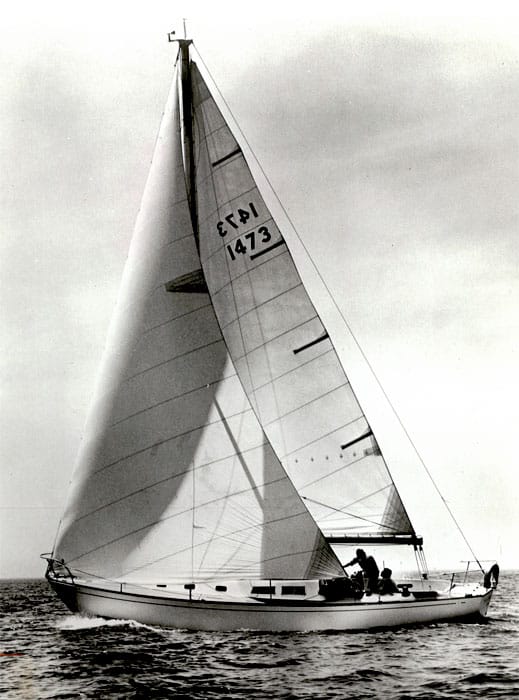
13. Beneteau 423
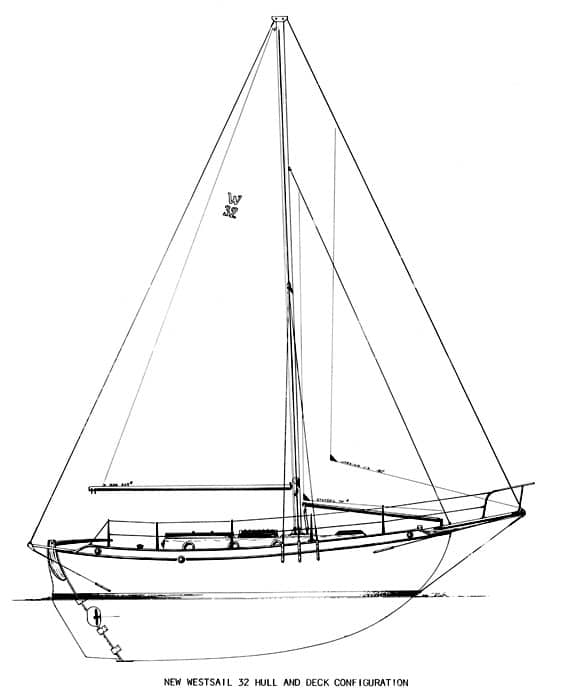
12. Westsail 32
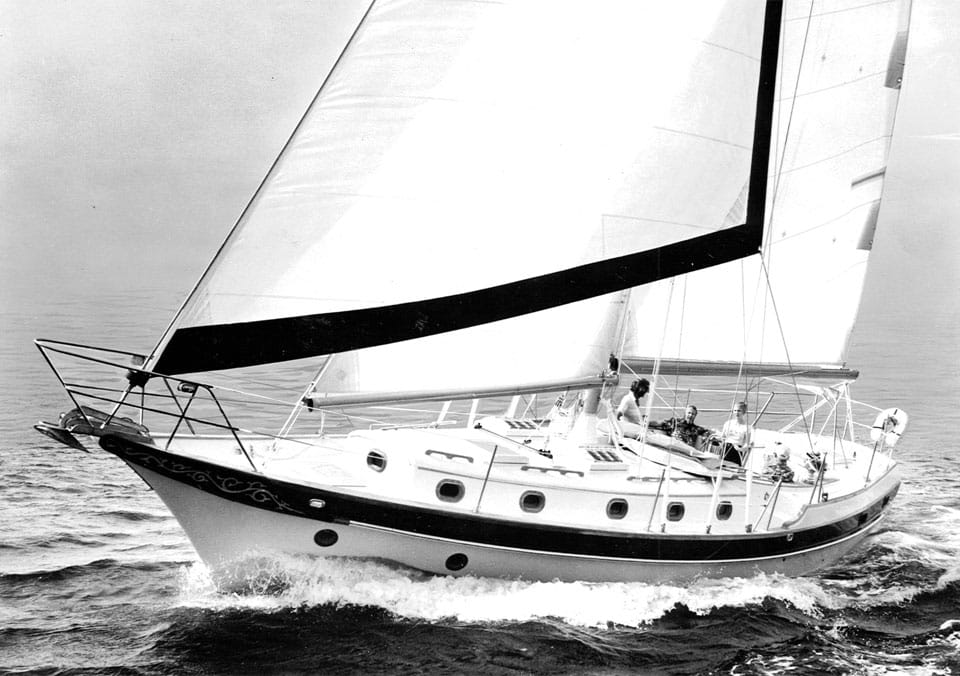
– CHECK THE WEATHER – The weather changes all the time. Always check the forecast and prepare for the worst case. Safety Tip Provided by the U.S. Coast Guard
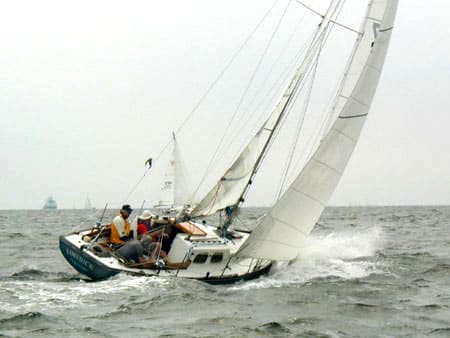
10. Alberg 30
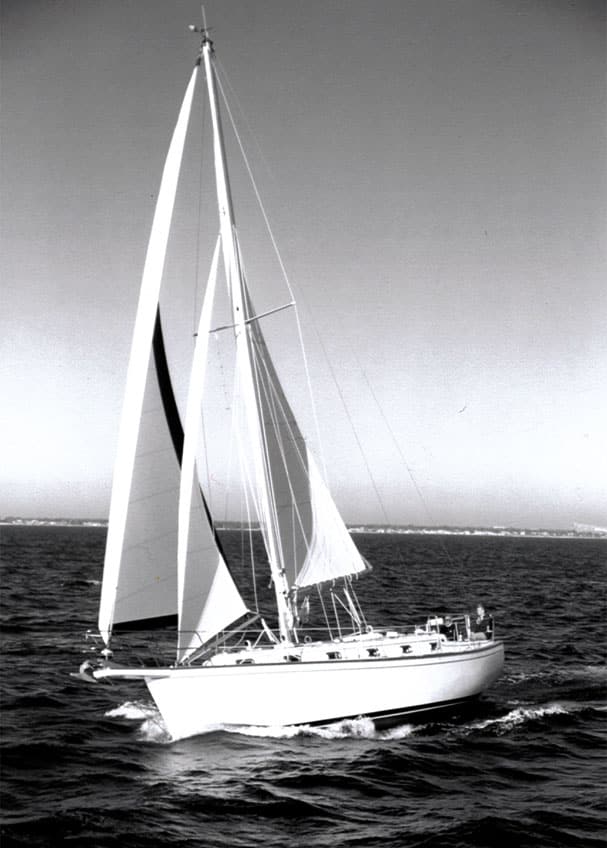
9. Island Packet 38
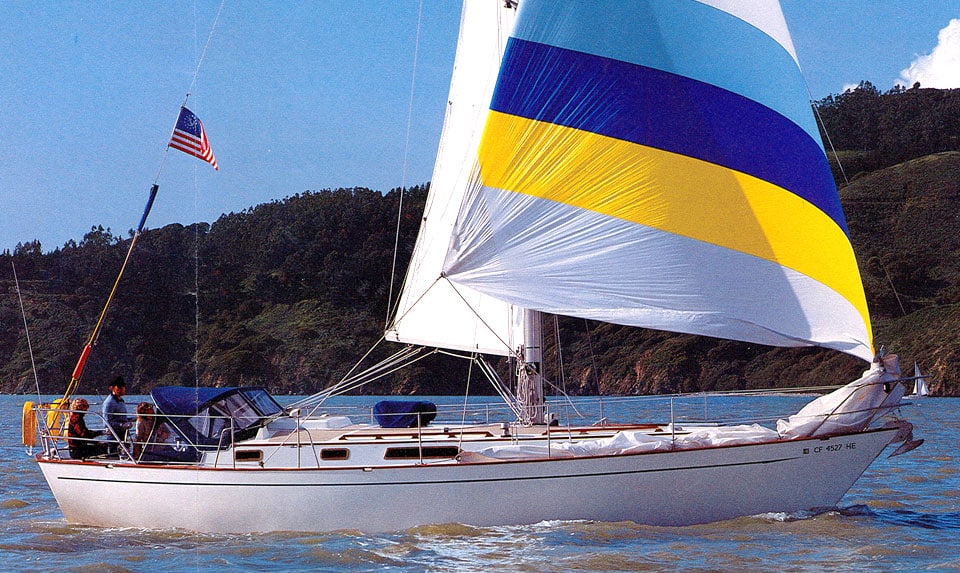
8. Passport 40
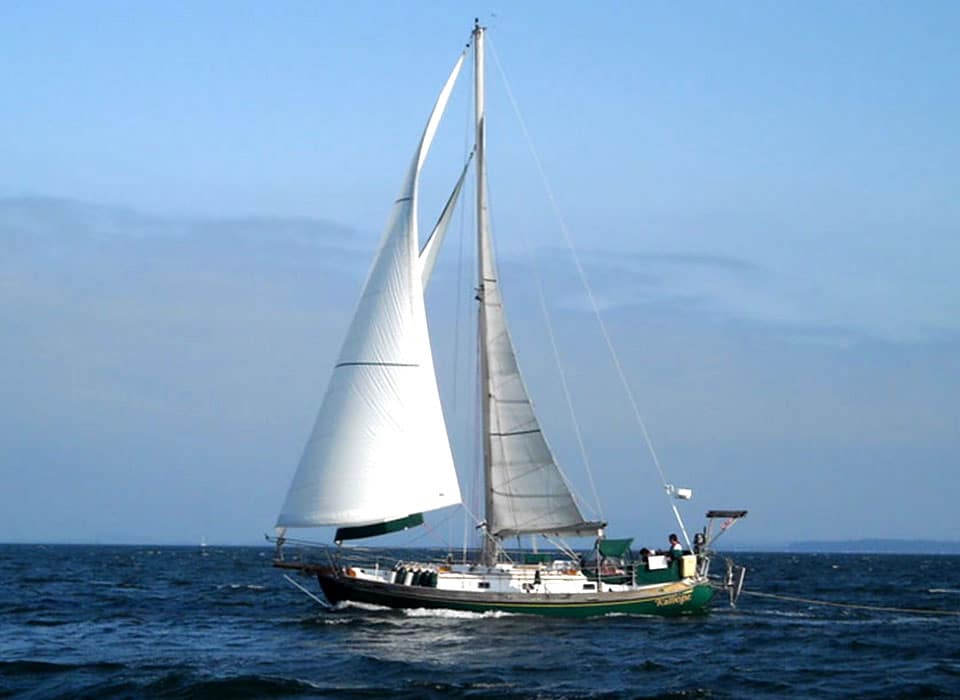
7. Tayana 37
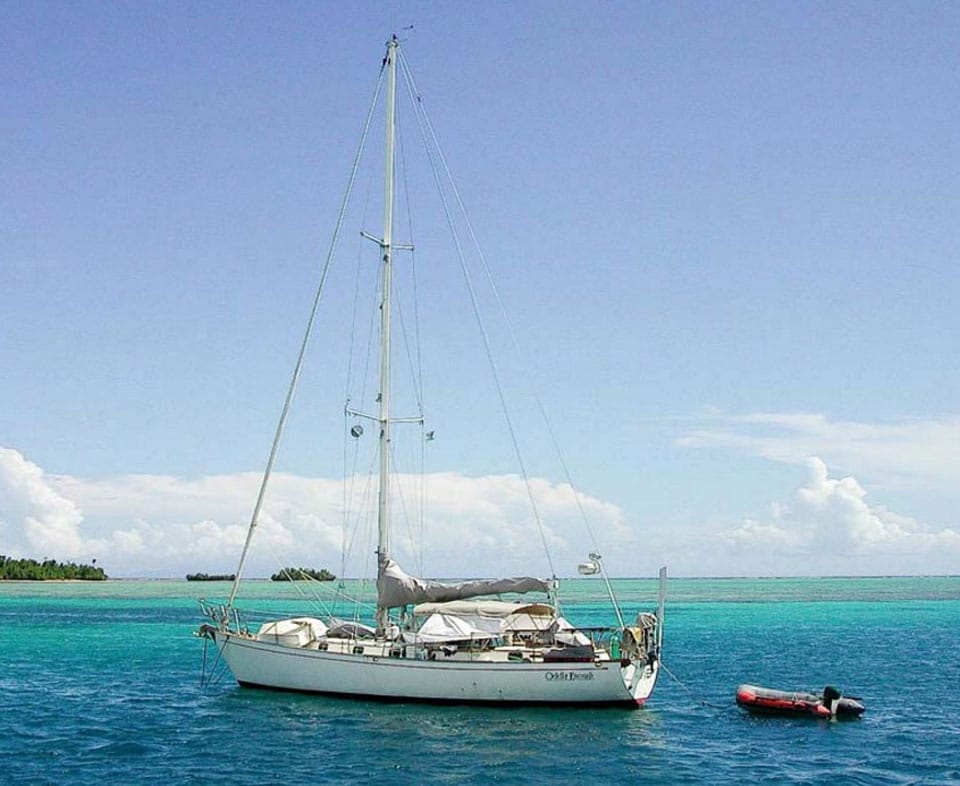
6. Peterson 44
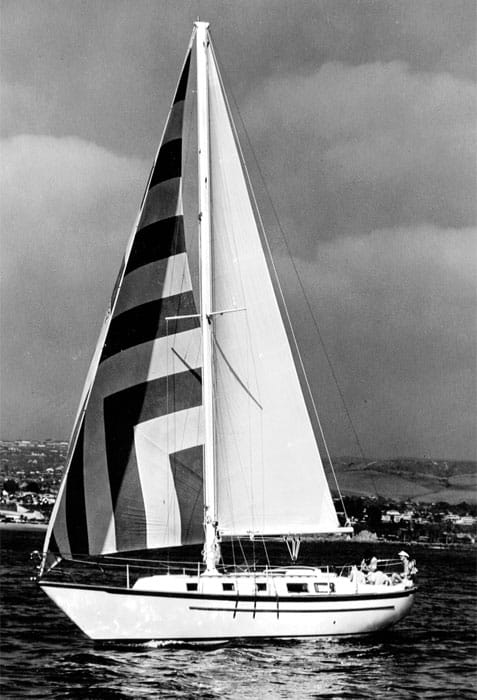
5. Pacific Seacraft 37
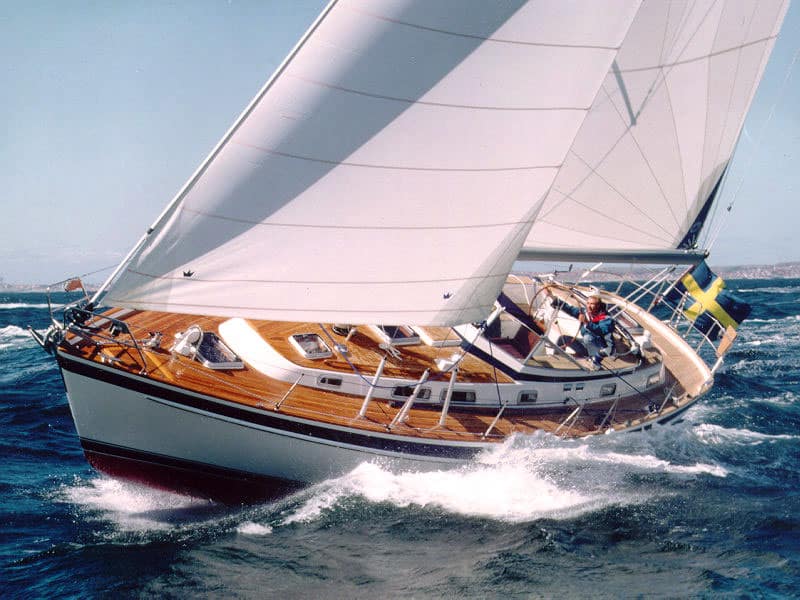
4. Hallberg-Rassy 42
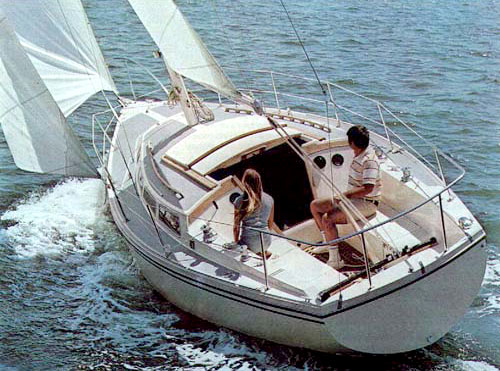
3. Catalina 30
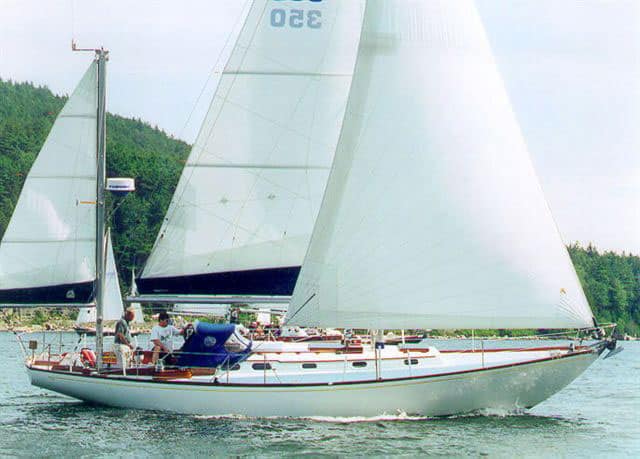
2. Hinckley Bermuda 40
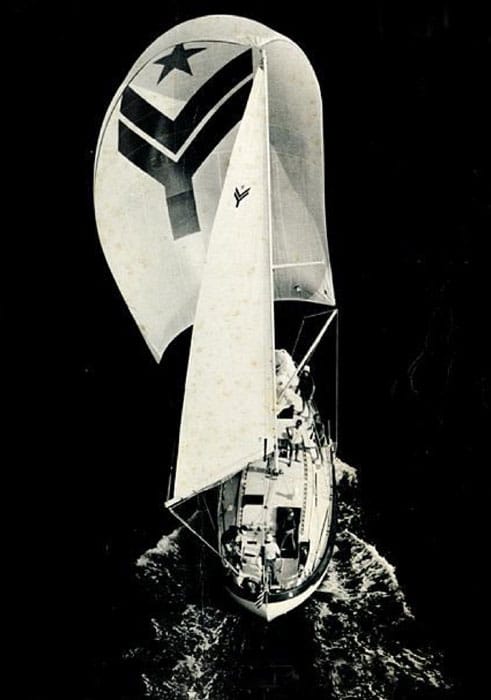
1. Valiant 40
- More: monohull , Sailboats
- More Sailboats

Sailboat Preview: Elan GT6 Explorer

For Sale: 1984 Camper & Nicholsons 58

Alubat Updates OVNI Models

For Sale: Little Harbor 63 Ketch

From Paradise to Medical Emergency: A Bahamas Nightmare Turns Lesson Learned

Free Medical Advice: The Unwarranted, Unprofessional Edition

Gatekeepers of the Waterway

Rigging Redo: Our Switch to Synthetic
- Digital Edition
- Customer Service
- Privacy Policy
- Terms of Use
- Email Newsletters
- Cruising World
- Sailing World
- Salt Water Sportsman
- Sport Fishing
- Wakeboarding

The global authority in superyachting
- NEWSLETTERS
- Yachts Home
- The Superyacht Directory
- Yacht Reports
- Brokerage News
- The largest yachts in the world
- The Register
- Yacht Advice
- Yacht Design
- 12m to 24m yachts
- Monaco Yacht Show
- Builder Directory
- Designer Directory
- Interior Design Directory
- Naval Architect Directory
- Yachts for sale home
- Motor yachts
- Sailing yachts
- Explorer yachts
- Classic yachts
- Sale Broker Directory
- Charter Home
- Yachts for Charter
- Charter Destinations
- Charter Broker Directory
- Destinations Home
- Mediterranean
- South Pacific
- Rest of the World
- Boat Life Home
- Owners' Experiences
- Conservation and Philanthropy
- Interiors Suppliers
- Owners' Club
- Captains' Club
- BOAT Showcase
- Boat Presents
- Events Home
- World Superyacht Awards
- Superyacht Design Festival
- Design and Innovation Awards
- Young Designer of the Year Award
- Artistry and Craft Awards
- Explorer Yachts Summit
- Ocean Talks
- The Ocean Awards
- BOAT Connect
- Between the bays
- Golf Invitational
- BOATPro Home
- Superyacht Insight
- Global Order Book
- Premium Content
- Product Features
- Testimonials
- Pricing Plan
- Tenders & Equipment
Top 10 largest sailing yachts in the world
The list of the top ten largest sailing yachts in the world is not easily disrupted. In fact, it had remained unchanged since the launch of the 106.7-metre Oceanco Black Pearl in 2018, which swiped the top spot from Lürssen 's 93-metre Eos . For four years, Black Pearl remained the largest yacht in the world until early in 2023 when Oceanco sent a new flagship down the slipway, the mighty 127-metre Koru . Read on to discover our official list of the largest sailing yachts in the world.
1. Koru | 127m
Leading this list is a new entry: Oceanco 's record-breaking 127-metre sailing yacht Koru . Commissioned by Amazon founder Jeff Bezos, Koru has been the subject of much speculation for years but was revealed in all its glory in 2021. Not only is she the largest sailing yacht in the world, she is also the largest superyacht ever to be built in the Netherlands. Her name, Koru, is the Māori word meaning "new beginnings" and she is accompanied by a 75-metre support vessel named Abeona . She was delivered in 2023 and is over 20 metres longer than the former title-holder Black Pearl.
- Builder: Oceanco
- Country of build: Netherlands
- Delivery year: 2023
- Length Overall: 125.82 m
- Beam: 16.95 m
- Gross Tonnage 3493 t
More about this yacht
More stories, 2. black pearl | 106.7m.
Instantly recognisable with her black sails and Dynarig set-up, Black Pearl is the second-largest sailing yacht in the world. Delivered during the same year as 142.81-metre Sailing Yacht A (officially designated as a sail-assisted motor yacht), Black Pearl spent five years in development at Dutch yard Oceanco . Dykstra Naval Architects , Ken Freivokh , Nuvolari Lenard , BMT Nigel Gee and Gerard P Villate all contributed their expertise to this monumental project, which looks set to turn heads the world over for decades to come. She is often compared to Maltese Falcon , the first Dynarig superyacht, but boasts a number of technological advancements. She flies 25 per cent more sail area with hinging spars that fold down to allow her to pass through the Panama Canal, but it is what lies beneath that really counts. Two variable pitch propellers harness kinetic energy while she is under sail, which can run the hotel or recharge the batteries, allowing her to cross oceans without expending a drop of fuel.
- Delivery year: 2018
- Length Overall: 106.7 m
- Gross Tonnage 2700 t
3. Eos | 92.93m
Eos was built in Germany under a cloak of secrecy for her American media and movie mogul Barry Diller. Eos is a three-masted Bermuda rigged schooner and was refitted at Royal Huisman in 2011. After emerging from her refit the yacht caught fire in Norway and had to return to the yard to be repaired.
- Builder: Lurssen
- Country of build: Germany
- Delivery year: 2006
- Length Overall: 92.93 m
- Beam: 13.5 m
- Gross Tonnage 1500 t
4. Athena | 90m
Athena was built by the Royal Huisman in Holland for US software developer Jim Clark. Athena's advanced engineering means that she is able to sail in relatively light airs, while still offering the interior space typically only found on motor yachts. In stronger winds, Athena has been credited as attaining 19 knots under sail. The yacht's three closed decks include a large owner's suite, four guest suites, a saloon and dining room on the main deck and a sky lounge on the upper deck. Her clipper-bow and three-masted schooner sprung from the boards of Pieter Beeldsnijder (exterior styling) and Dykstra Naval Architects (naval architecture).
- Builder: Royal Huisman
- Delivery year: 2004
- Length Overall: 90 m
- Beam: 12.2 m
- Gross Tonnage 1103 t
5. Maltese Falcon | 88m
Maltese Falcon was built for the late American venture capitalist Tom Perkins. The iconic three-masted schooner is the fifth-largest sailing yacht in the world. Maltese Falcon's rig is made up of three unstayed, 'weapons-grade' carbon fibre masts, with a fully computerised sail and rotating mast system. The system has been dubbed a triumph of design, development and engineering and Maltese Falcon has topped an impressive 24 knots under sail. The Ken Freivokh interior is a marriage of industrial chic and high tech. It features leather, glass, wood and steel as well as a modern art collection. The yacht has accommodation for 12 guests and is available for charter.
- Builder: Perini Navi
- Country of build: Turkey
- Length Overall: 88 m
- Beam: 12.47 m
- Gross Tonnage 1112 t
Yachts for charter
6. aquijo | 85.9m.
The highly anticipated Aquijo was the result of a collaboration between Vitters and Oceanco. Both Dutch yards worked closely with the owner's representative to create a highly complex, performance-driven sailing machine that became the third largest sailing superyacht when launched. Aquijo is an aluminium ketch-rigged yacht, and features a custom steering system. Aquijo's interior layout provides clear sight lines thanks to her high-volume superstructure.
- Builder: Vitters | Oceanco
- Delivery year: 2016
- Length Overall: 85.9 m
- Beam: 14.48 m
- Gross Tonnage 1538 t
7. Sea Eagle II | 81m
Delivered in 2020, Sea Eagle II is the most recent addition to the top ten largest sailing yachts in the world. Built by Royal Huisman, Sea Eagle II features exterior styling by Mark Whiteley and naval architecture penned by Dykstra Naval Architects . Sold in summer 2016 by Northrop & Johnson as Project RH400, Sea Eagle II is the largest yacht ever built by the Dutch yard.
- Delivery year: 2020
- Length Overall: 81 m
- Gross Tonnage 1150 t
8. M5 | 78.4m
Built by Vosper Thorneycroft in Southampton, England, M5 was launched as the iconic yacht Mirabella V in 2004. She remains the world’s largest sloop to date. M5 was designed by Ron Holland for American yachtsman Joe Vittoria, who enjoyed sailing her for seven years before she was sold on. The new owner renamed her M5 and she was extended by 3.2 metres in a refit at Pendennis before her relaunch in 2013. Her most recent refit , however, in 2019, saw M5 emerge from the sheds with all new paint-work, composite biminis, a reinforced mast and a new bow-thruster.
M5 has a displacement of 780 tonnes (165 tonnes of which is the keel). The carbon fibre mast is an amazing 88.3 metres tall and can carry approximately 3,700 square metres of sail.
- Builder: Vosper Thornycroft
- Country of build: United Kingdom
- Length Overall: 78.4 m
- Beam: 14.8 m
- Gross Tonnage 1009 t
9. Badis | 70m
The second largest Perini Navi sailing yacht to date, Badis was built for the multiple superyacht owner Bill Duker and launched in 2016 as Sybaris . The name comes from a Greek settlement in ancient Italy that was famed for its hedonism, feasts and excesses. Featuring naval architecture and sailplan optimisation by Philippe Briand, this all-aluminium ketch can host up to 12 guests across six cabins. Interiors are by PH Design with a total internal volume of 870GT, while the crew quarters allow for a staff of up to 11. Under power, Badis's twin MTU 16V 2000 M72 diesel engines generate a total of 3,860hp, resulting in a top speed of 17.5 knots and a maximum cruising range of 5,000 nautical miles at 12.5 knots.
- Country of build: Italy
- Length Overall: 70 m
- Beam: 13.24 m
- Gross Tonnage 887 t
10. Atlantic | 69.3m
Atlantic might have the looks of an old classic but don't be fooled, this modern three-masted schooner was delivered in 2010 to an owner with a penchant for classic sailing yachts. She was built from scratch as a replica of the famous 64.5-metre Townsend & Downey schooner by the same name built in 1903. The sailing yacht made history when she set the record for the fastest Atlantic crossing in 1905 - a record that remained unbroken for nearly 100 years - but she was sadly scrapped in 1982. Inspired by its legacy, owner Ed Kastelein built a replica as a tribute to the record-breaking classic at the Van de Graaf shipyard in the Netherlands. The new Atlantic 's three masts stand 50 metres high and support 1,700 square metres of sails with 36 winches in bronze built specially by Harken.
- Builder: Van der Graaf
- Delivery year: 2010
- Length Overall: 69.31 m
- Gross Tonnage 268 t
Yachts for sale
Sponsored listings.
Better Sailing
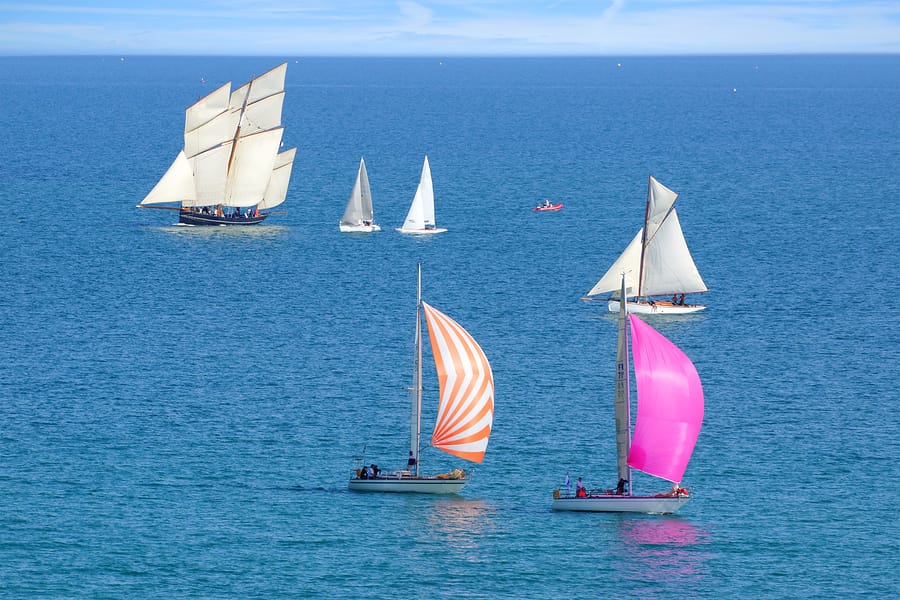
Types Of Sailboats
A Sailboat is a water vessel which drives all, or part, of its propulsion from the force of the wind and water speed. Distinctions in size do not have strict definitions, and what comprises a Sailing Ship, a Sailboat or other small vessel varies across regions and cultures.
There is a large variety of Sailboats, each having its own characteristics and styles. They can be differentiated based on the purpose and number of Hulls or Sails.
There are many types of Sailing Ships, but the basic components are relatively the same: every Sailing Ship has a hull, rigging, and at least one mast to hold up the sails.
Knowing the different Sailboat Types is important when learning to sail. In this section, know what the basic Sailboat Types are and learn the features of each.
Below are some examples:

The catboat has a single mast well forward. This design of the sail plan emerged in the 19th century in North America and was used for fishing and transport in coastal waters because of their great beam. Catboats can be quite fast but perform poor to windward. They come gaff-rigged or with Bermudan sails. Nowadays, there are mostly used as a small pleasure day sailing vessel, and it has its own place within the racing community.
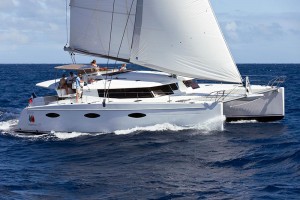
A Catamaran is a boat with two hulls. It is usually lighter, much faster than a monohull sailboat, and more stable because of the wider distance from one side of the boat to another. This leads to more sail area carried for every foot of length compared to a single-hulled Sailboat.
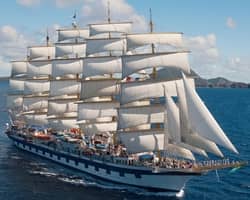
Clippers are large sailboats used mainly in the 19th century as merchant ships. Clippers have between three and five masts and square rigs.
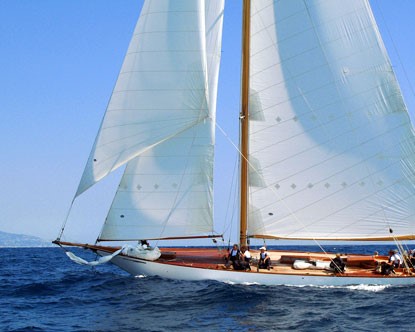
The cutter rig has one mast, which is further aft than on a sloop and carries one mainsail and two or more headsails. A traditional cutter will have as well a bowsprit. Pictured on the left is a gaff rig cutter that has a mainsail and the main topsail. The mainsail has four sides and is supported by a gaff, therefore a gaff rig cutter. Nowadays, you will find as well Cutter rigs with Bermudan sails. This is an easy to handle cruising rig. The sail before the mast is called stay sail, which can have its own boom on the food of the sail, which allows self-tacking.
Day Sailers
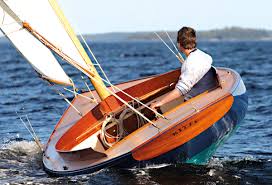
Relatively small sailboats without sleeping quarters, but they come with small cabins intended for storage space and a little shelter. Daysailers are stable crafts and are sailed like small yachts.
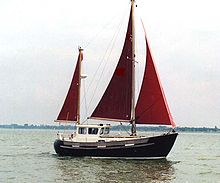
The Ketch is a popular cruising rig too. It offers a large sail area and is still shorthanded manageable. This rig has two masts, the main and the smaller mizzen mast, which is forward of the rudder. The sail on the mizzen mast is called mizzen sail. It is as well possible to have a cutter-rigged Ketch, which will carry more than on foresail, usually, a self-tacking staysail and a jib. The main and mizzen sail could be with a gaff or a Bermudan shaped sail.
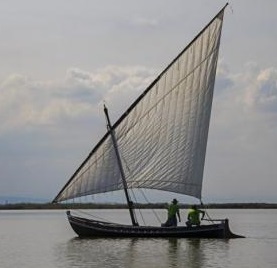
A Lateen is a sailboat with a triangular sail attaching on a long wooden pole called “antenna”. It is an invention of the Arabs and we find it mainly in Egypt.

The schooner has two masts where the first one is smaller than the second and can have more than one foresail. This type of rig emerged in the 18th century, and the largest schooner build had seven masts. They were used commercially as pilot, fishing or cargo vessels and could sail better to windward than previous rig designs. Nowadays, some larger cruising yachts use the two-masted schooner rig, which is easy to sail short-handed. The schooner comes as well with gaff or Bermudan sails.
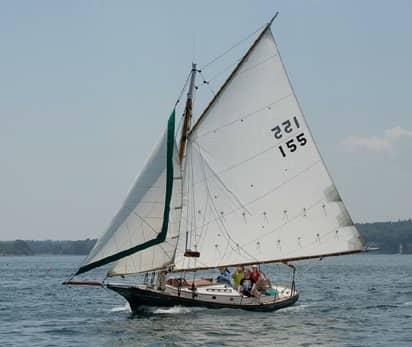
Probably the most used rig nowadays is the sloop rig, which has above all other types the best performance to windward but needs extra sails like a spinnaker to perform well downwind. The sloop rig has one mast which carries a mainsail to aft and a fore or headsail to forward. The Bermudan sloop originated from the Bermudan Islands in the 17th century and was continuously developed further. We can find this rig on racing sloops with high aspect sails competing in the America’s Cup. When the forestay ends at the top of the mast then the sloop is called Masthead, while when it ends lower (at 7/8 of the mast) it is called Fractional.
Trailer Sailer
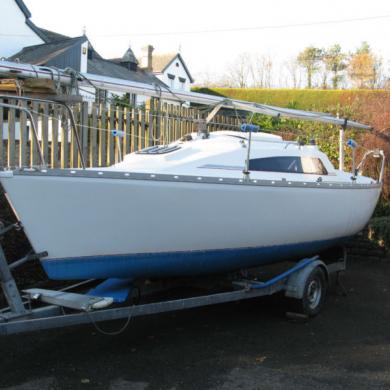
A small sailboat which can be moved towards different areas by the use of road trailers towed by an automobile. They are usually larger than a sailing dinghy. They are especially popular with small families and retirees and are used for both racing and recreation.

A Trimaran is a multi-hulled Sailboat. It has a main hull with two smaller Hulls located on each side, giving the Trimaran greater stability. Compared to a single-hulled Sailboat, a Trimaran has a wider Beam and can keep its stability even in stronger winds. However, it is a bit harder to maneuver because of its structure.

The yawl rig has like the ketch to masts, but the mizzen mast is aft of the rudder. This sail plan derived originally from commercial fishing boats. Later on, it became quite popular with single-handed sailors because sails could be trimmed to sail without having to control the rudder.
In comparison to the ketch, the mizzen sail on a yawl is less for propulsion than for balancing the rest of the rig. Nowadays, the yawl lost popularity since other steering aids like electronic autopilots or mechanical wind vanes make her mizzen sail and mizzen mast redundant. The yawl comes as well with gaff or Bermudan sails.
Types Of Sailboats – Concussion
These are some of the basic Sailboat Types. There are many other styles out there, but whatever type you want to use, just make sure that you are knowledgeable on the features of that particular Sailboat so you can handle it properly.
Whichever boat a sailor chooses is unique. Their characteristics are different, but one. They are all sailing boats and that means they have sails. These sails are called Mainsail, Jib and Spinnaker, depending on their type. Depending on the size, the material, the construction, and the strength, they have different types. The only sure thing is that no matter how different they are, all they need is good sailors.
Peter is the editor of Better Sailing. He has sailed for countless hours and has maintained his own boats and sailboats for years. After years of trial and error, he decided to start this website to share the knowledge.
Related Posts

Atlantic vs Pacific: Which is More Dangerous for Sailing?

Why Do Sailboats Lean?

How Does a Boat Sail Upwind? Unveiling the Mechanics of Against the Wind Sailing

How Does Sailing Work? The Physics of Sailing
- Buyer's Guide
- Destinations
- Maintenance
- Sailing Info
Hit enter to search or ESC to close.

IMAGES
COMMENTS
Ever wondered what type of sailboat you're looking at? Identifying sailboats isn't hard, you just have to know what to look for. In this article, I'll help you.
The term sailboat includes many different sizes, shapes, and hull types. Here's how to identify most of the common ones.
Distinguishing Types of Sailboats In this article, we'll distinguish sailboats by traits such as their hull type, rig, and general configuration. Some sailboats share multiple characteristics with other boats but fall into a completely different category. For example, a sailboat with a Bermuda rig, a large engine, and a pilothouse could technically be called a sloop, but it's more likely a ...
The basics of sailboat design play a significant role in the classification and function of these vessels. Hull shapes, keel types, and construction materials contribute to the speed, stability, and maneuverability of sailboats. Additionally, rigging and sails come in various shapes and sizes, which influence sailing performance and handling.
This observation alone will enable you to identify the five main types of sailboats — sloops, cutters, ketches, yawls and schooners - all of which are described here. But apart from the various rig types, you can describe types of sailboats from a different viewpoint - sailing dinghies, dayboats, motorsailors, monohulls, catamarans and ...
Sailboats can be divided into three basic types based on their hulls (catamaran, monohull or multihull), their keel and their rigging, and then further subdivided from there. The result is that there are actually well over a dozen different kinds of sailboats out there.
Whether you're new to sailboats or already an American Sailing Association (ASA) certified skipper, knowing the difference between the different types of vessels is essential. We'll provide you with a basic understanding of the different types of sailboats, the advantages of each, and which type of voyage they're best used for.
Sailboats come in a vast variety of shapes and sizes and the uses for each different kind can be confusing. The word "sailboat" doesn't really describe a type of boat but rather the inclination to move with the power of the wind and experience a freedom that's not always present with other kinds of boating.
Sailboat shapes Sailboats can be monohulls or multihulls, which can be catamarans with two hulls or trimarans with three. Monohulls Monohulls are the classic sailing boat with one hull. Large, traditional, and older versions have deeper and heavier keels integrated into the hull for greater stability. At the same time, newer designs have fin keels that are attached rather than integrated ...
Sailboat types differentiate by design and use, and even the type of culture that permeates each subgroup. Let's divide sailboats by hull types, rig types and activities/uses.
List of sailing boat types. A Windmill sailing dinghy. The following is a partial list of sailboat types and sailing classes, including keelboats, dinghies, and multihull ( catamarans and trimarans ).
This post explains the most common types of sailboats. Sailboats are classified by size, rig type, the number of hulls and construction material.
The types of keels commonly associated with sailboats are as follows: full-length keel, fin keel, centreboard keel, bilge keel, bulb keel and wing keel. As the name suggests, full-length keels have keels that extend in the form of a long fin below the main structure of the ship.
Several factors determine the types of sailboats, including the hull type, keel type, mast configuration, and sails and rigging. The hull is the boat's body and can be either a monohull, catamaran, or trimaran.
Discover the different types of sails and rigs, how they work, and what they are used for. This guide includes pictures and examples of sailboats from around the world.
There are lots of different types of sailing boats, which are also referred to as sailboats, sailing dinghies, sailing yachts and simply, yachts. Sailing boats range in size, from lightweight dinghies, such as the Optimist dinghy (2.36m) all the way up to superyachts as large as 90 metres in length.
Sailboat Classifications Ok, you want to set sail in your dreams, or maybe daydreamed about cruising crystal-clear waters on a sleek sailboat. Before you chart your course, you may want to explore the different types of sailboats and know its unique personalities and ideal uses. By Hull Design Monohulls Think classic sailboats - these are the most common, offering stability and a variety of ...
A cat rig boat, or cat boat, is a type of sailboat that usually just has one large mainsail and a forward-mounted mast. Many smaller dinghies and training boats are catboats.
Looking for a used sailboat? Start with this list for the best sailboats that hold value. All summer readers cast votes for their favorites on CW's 40 greatest production monohulls of all time list, now you can see how the fleet stacks up.
1. Sailing Yacht A - 142M (465 Ft.) Above: The largest sailboat in the world, "Sailing Yacht A" (a sail-assisted vessel) at anchor in a harbor in Europe. Note how the sailboat to her stern is dwarfed by her sheer size. Photo by Brock Harris for YachtWorld. This vessel is both innovative and controversial.
The ultimate superyacht guide to the top 10 largest sailing yachts in the world, updated with the new record holder to emerge from Oceanco in 2023 and other impressive boats.
A Sailboat is a water vessel which drives all, or part, of its propulsion from the force of the wind and water speed. Distinctions in size do not have strict definitions, and what comprises a Sailing Ship, a Sailboat or other small vessel varies across regions and cultures. There is a large variety of Sailboats, each having its own characteristics and styles. They can be differentiated based ...
List of boat types This is a list of boat types. For sailing ships, see: List of sailing boat types Contents A B C D E F G H I J K L M N O P Q R S T U V W X Y Z See ...